ICG MAGAZINE

BIG
TOLD ME
GEORGE FOREMAN + DEAD RINGERS + THE LAST THING HE





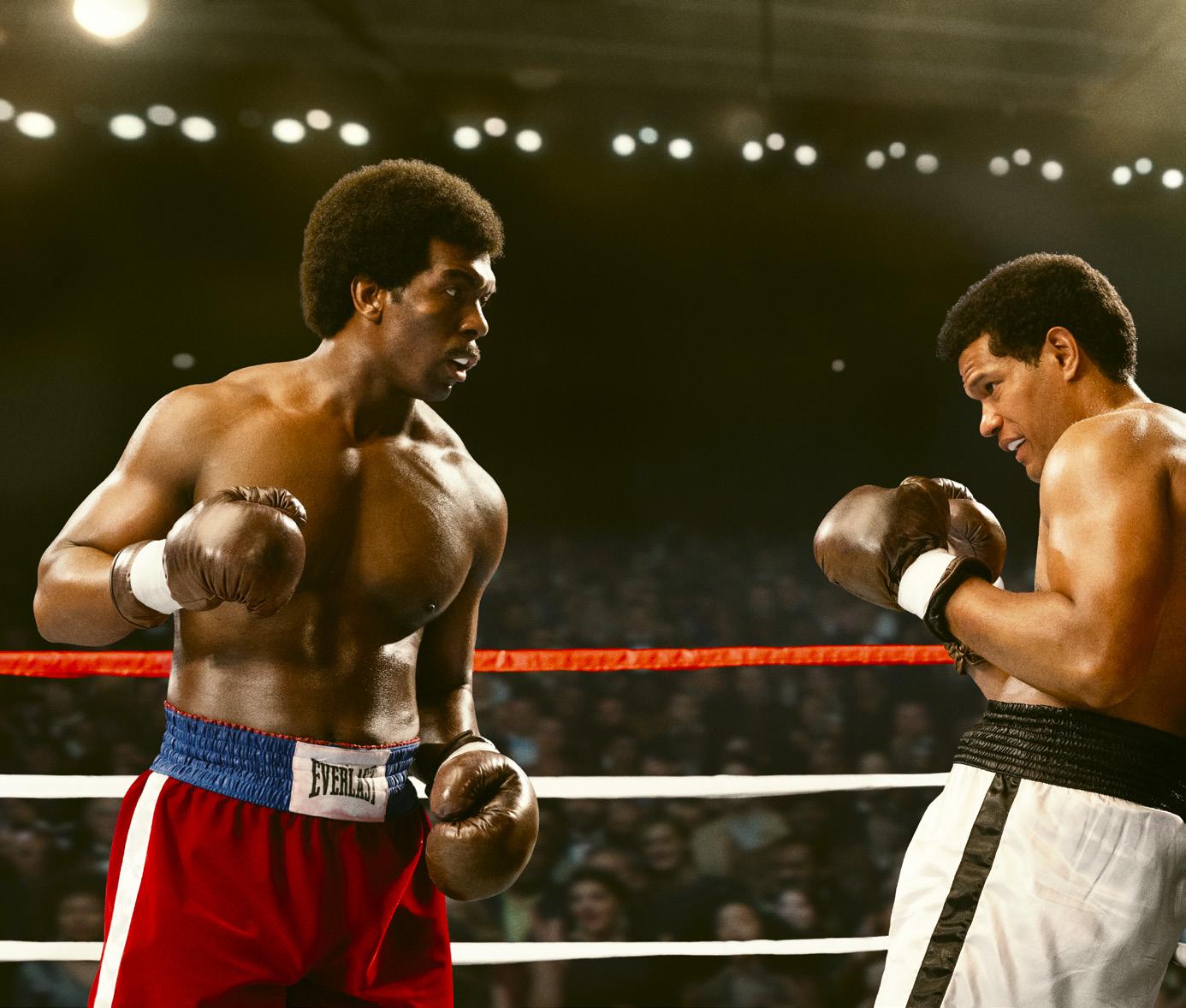
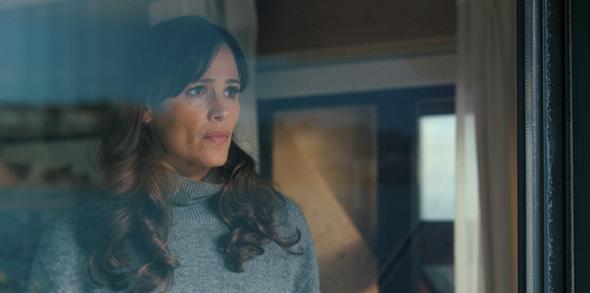

4 MAY 2023 A PUNCHER’S CHANCE FEATURE01
26 SPECIAL True Vintage Glass Explained .... 72 LIGHTING&LENSES DEPARTMENTS gear guide ................ 12 deep focus ................ 16 depth of field ................ 18 exposure ................ 22 production credits ................ 84 stop motion .............. 90 May2023/Vol.94No.04
John Matysiak and David Tattersall, BSC, help bring the one-of-a-kind life story of “Big George Foreman” to the big screen.
FEATURE03 IN A FOG
A new Apple TV+ series unites two longtime Guild cinematographers (and two regional locations) for the screen adaptation of Laura Dave’s best-selling novel.
FEATURE02 42 58 BODY DOUBLE CONTENTS
Jody Lee Lipes, ASC, and Laura M. Gonçalves probe beneath the skin for a reimagining of David Cronenberg’s horror classic Dead Ringers
MOUNT ANYWHERE, LIGHT ANYTHING





Beam shaping with six included light modifiers and a large range of mounting options make HydraPanel more flexible than any other product in its class. The full-spectrum Titan LED Engine generates an impressive 1300 Lumen output while running on battery power for 1:45h. All packed into a solid watertight housing of just 600g weight and 166mm length.
17W LED POWER DRAW








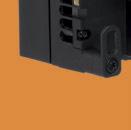






WIRELESS + WIRED DMX
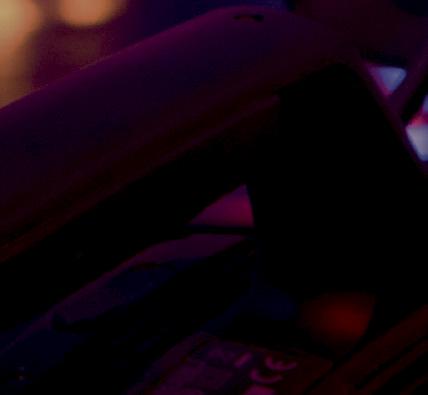

















LIGHT MODIFIERS FOR FULL FLEXIBILITY



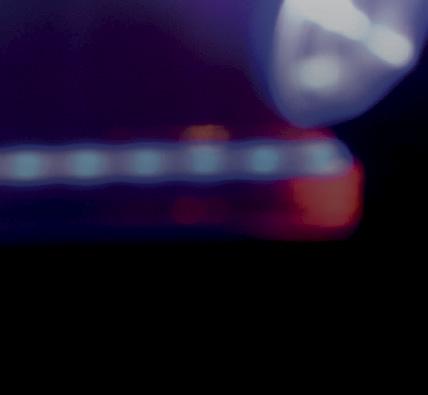



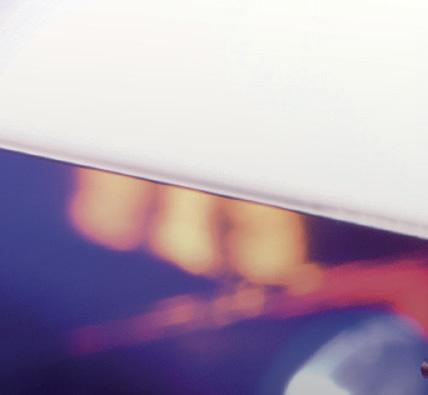

















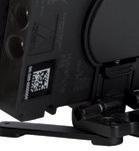
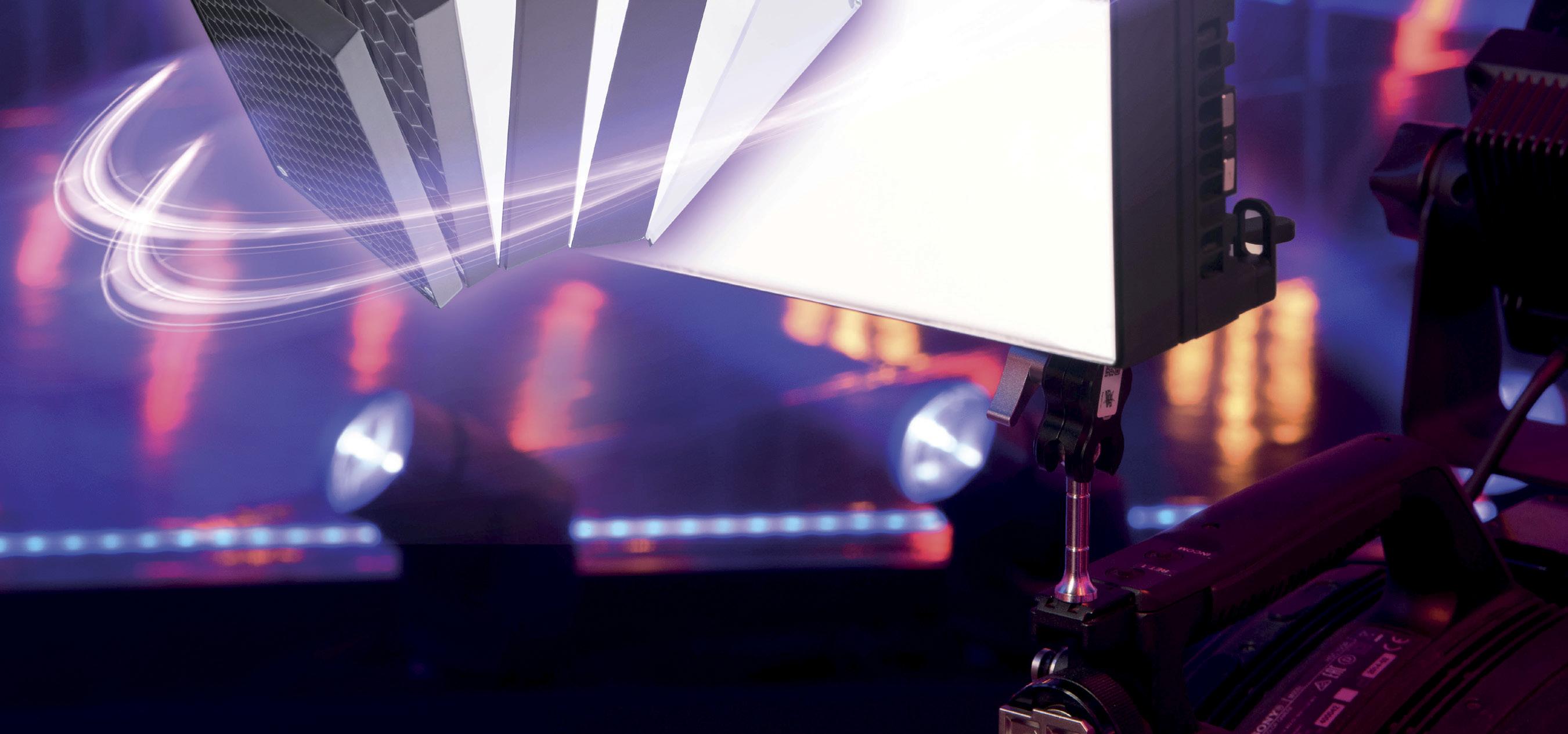 Foldable foot for setup on flat surfaces
Cold Shoe for thirdparty accessories and to attach on cameras
Babypin included for mounting on stands and via SuperClamp
Foldable foot for setup on flat surfaces
Cold Shoe for thirdparty accessories and to attach on cameras
Babypin included for mounting on stands and via SuperClamp
ASTERA TITAN LED ENGINE HYDRA PANEL POWERED BY RGB+MINT+AMBER FULL SPECTRUM 1750K - 20000K WIDE CCT RANGE TLCI/CRI Ra ≥ 96 EXCELLENT COLOR RENDERING from 3.200K to 6.500K RGB, HSI, X,Y & FILTER GELS Max. 20h Wireless DMX App IP65
Combine units to build a bigger panel
www.astera-led.com/hydrapanel
PRESIDENT’S LETTER
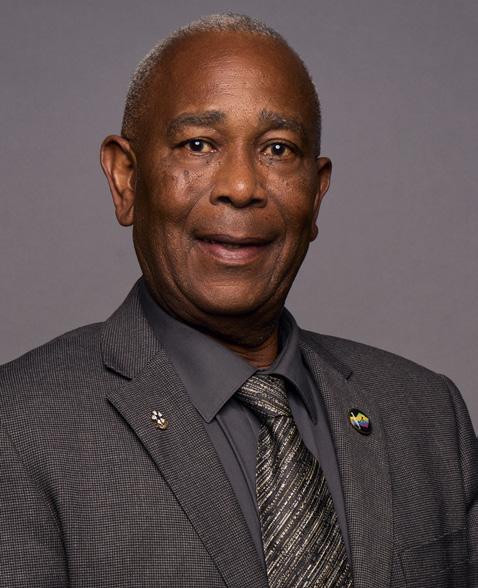
Lens to Our World
This month’s issue of ICG Magazine , themed around lenses and lighting, is, for me, as a lifelong camera technician, close to my heart. One of the most important responsibilities of the camera technician’s craft is the lens selection chosen by the director of photography. Prepping lenses is an art form, and knowing the characteristics of your lenses is key not just for the technician and the director of photography, but to the project you’re both filming. On a recent feature, we were using the Panavision DXL camera; Director of Photography Jody Williams wanted to have a set of lenses that would mirror the look of four retro shots we needed to do, which emulated the original movie our show was based upon. We went to Panavision lens expert Dan Sasaki, who put together two sets of lenses for our needs. The first was the Primo Artiste, which was our main lens set for the project. Dan also helped deliver us a set of Sphero 65 lenses (see attached chart) for the retro portion, and it was exactly what Jody was looking for. To me, the process was comparable to a DP choosing a film stock (back in the day). These days, there are so many different, and incredible, lenses to choose from – helping the cinematographer and his or her camera team create virtually any conceivable look for any project.
6 MAY 2023
Baird B Steptoe
Photo by Scott Everett White
National President International Cinematographers Guild IATSE Local 600
Large Format Lens Descriptions Sphero65 Series Sphero 65 T/stop Format Coverage 62mm Contrast Sharpness Flaring Characteristic Focusing Characteristic Field Characteristic Bokeh 24mm t/2.8 Alexa 65 62mm diagonal and smaller Strong black foreground to background separation. Some higher order aberration that helps create depth and texture Has image quality similar to the PV ‘Z’ series lenses. Images are not too sharp and has a nice transition between details Modern coating that produces minimal ghost flares. Minimal veiling glare. Forgiving focus quality that is similar to the PV ‘Z’ series lenses. Minimal breathing similar to a Primo 35 lens. Flat field with consistent performance from center to the edge of field. Round bokeh without any element artifacts (clean rounded defocus quality) 29mm t/2.8 35mm t/2.8 40mm t/2.8 50mm t/2.8 75mm t/2.0 100mm t/2.0 135mm t/2.8 180mm t/2.8 300mm t/2.8 400mm t/2.8
Scan
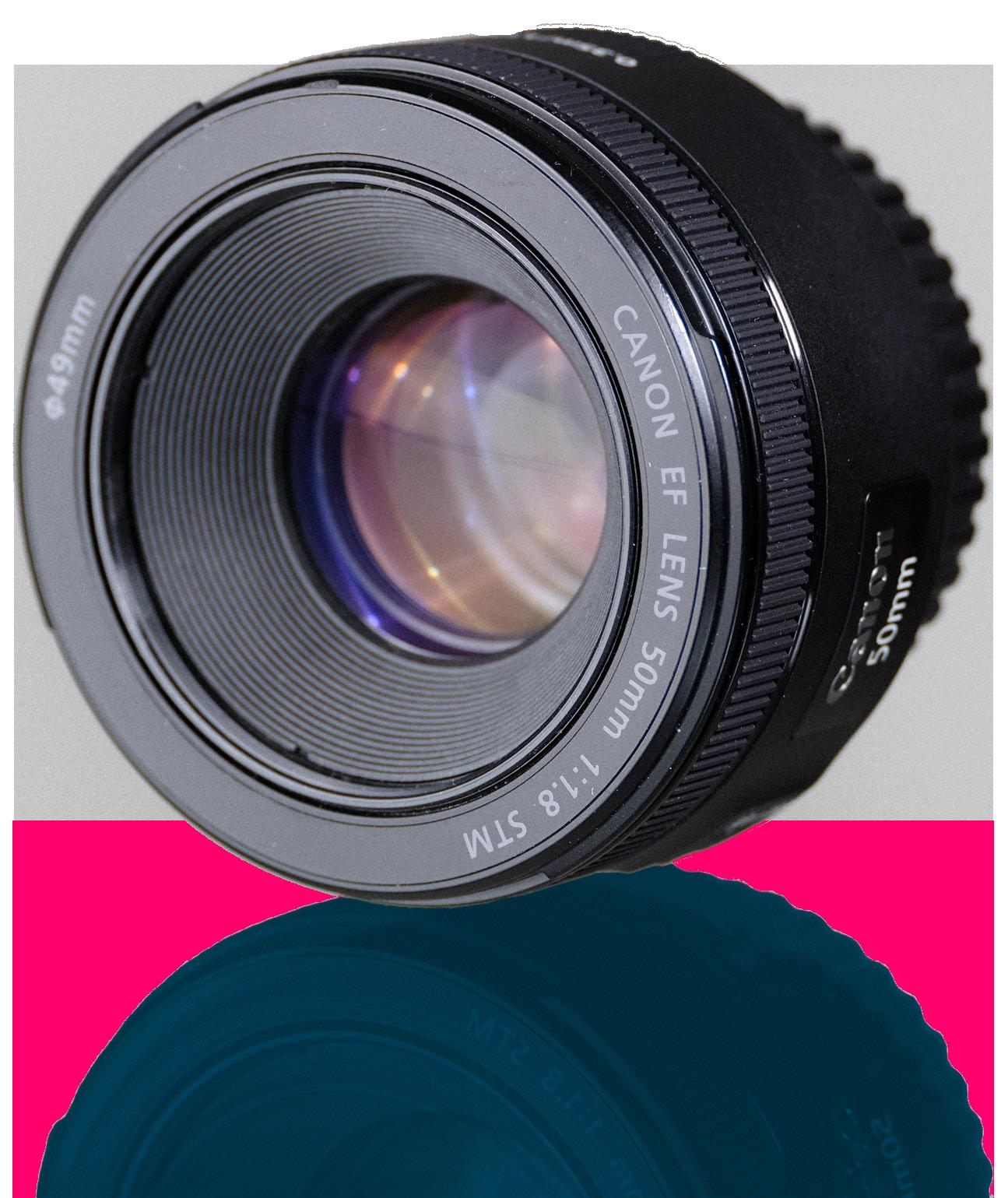

Turn


the QR code and get a free quote in seconds
“I’ve been using MPB for years now and they’ve never failed. From buying to selling each transaction goes very smoothly.
”
your extra gear into extra cash. Sell to MPB. MPB customer review
Publisher
Teresa Muñoz
Executive Editor
David Geffner
Art Director
Wes Driver
STAFF WRITER
Pauline Rogers
COMMUNICATIONS COORDINATOR
Tyler Bourdeau
COPY EDITORS
Peter Bonilla
Maureen Kingsley CONTRIBUTORS
Ted Elrick
Matt Hurwitz
Kevin Martin
Niko Tavernise
May 2023 vol. 94 no. 04
IATSE Local 600
NATIONAL PRESIDENT
Baird B Steptoe
VICE PRESIDENT
Chris Silano
1ST NATIONAL VICE PRESIDENT
Deborah Lipman
2ND NATIONAL VICE PRESIDENT
Mark H. Weingartner
NATIONAL SECRETARY-TREASURER
Stephen Wong
NATIONAL ASSISTANT SECRETARY-TREASURER
Jamie Silverstein
NATIONAL SERGEANT-AT-ARMS
Betsy Peoples
INTERIM NATIONAL EXECUTIVE DIRECTOR
Chaim Kantor
COMMUNICATIONS COMMITTEE
John Lindley, ASC, Co-Chair
Chris Silano, Co-Chair
CIRCULATION OFFICE
7755 Sunset Boulevard Hollywood, CA 90046
Tel: (323) 876-0160
Fax: (323) 878-1180
Email: circulation@icgmagazine.com
ADVERTISING REPRESENTATIVES
WEST COAST & CANADA
Rombeau, Inc.
Sharon Rombeau
Tel: (818) 762 – 6020
Fax: (818) 760 – 0860
Email: sharonrombeau@gmail.com
EAST COAST, EUROPE, & ASIA
Alan Braden, Inc.
Alan Braden
Tel: (818) 850-9398
Email: alanbradenmedia@gmail.com
Instagram/Twitter/Facebook: @theicgmag
ADVERTISING POLICY: Readers should not assume that any products or services advertised in International Cinematographers Guild Magazine are endorsed by the International Cinematographers Guild. Although the Editorial staff adheres to standard industry practices in requiring advertisers to be “truthful and forthright,” there has been no extensive screening process by either International Cinematographers Guild Magazine or the International Cinematographers Guild.
EDITORIAL POLICY: The International Cinematographers Guild neither implicitly nor explicitly endorses opinions or political statements expressed in International Cinematographers Guild Magazine. ICG Magazine considers unsolicited material via email only, provided all submissions are within current Contributor Guideline standards. All published material is subject to editing for length, style and content, with inclusion at the discretion of the Executive Editor and Art Director.
Local 600, International Cinematographers Guild, retains all ancillary and expressed rights of content and photos published in ICG Magazine and icgmagazine.com, subject to any negotiated prior arrangement. ICG Magazine regrets that it cannot publish letters to the editor. ICG (ISSN 1527-6007)
Ten issues published annually by The International Cinematographers Guild 7755 Sunset Boulevard, Hollywood, CA, 90046, U.S.A. Periodical postage paid at Los Angeles, California.
POSTMASTER: Send address changes to ICG 7755 Sunset Boulevard Hollywood, California 90046
Copyright 2021, by Local 600, International Alliance of Theatrical Stage Employes, Moving Picture Technicians, Artists and Allied Crafts of the United States and Canada. Entered as Periodical matter, September 30, 1930, at the Post Office at Los Angeles, California, under the act of March 3, 1879. Subscriptions: $88.00 of each International Cinematographers Guild member’s annual dues is allocated for an annual subscription to International Cinematographers Guild Magazine. Non-members may purchase an annual subscription for $48.00 (U.S.), $82.00 (Foreign and Canada) surface mail and $117.00 air mail per year. Single Copy: $4.95
The International Cinematographers Guild Magazine has been published monthly since 1929. International Cinematographers Guild Magazine is a registered trademark. www.icgmagazine.com www.icg600.com


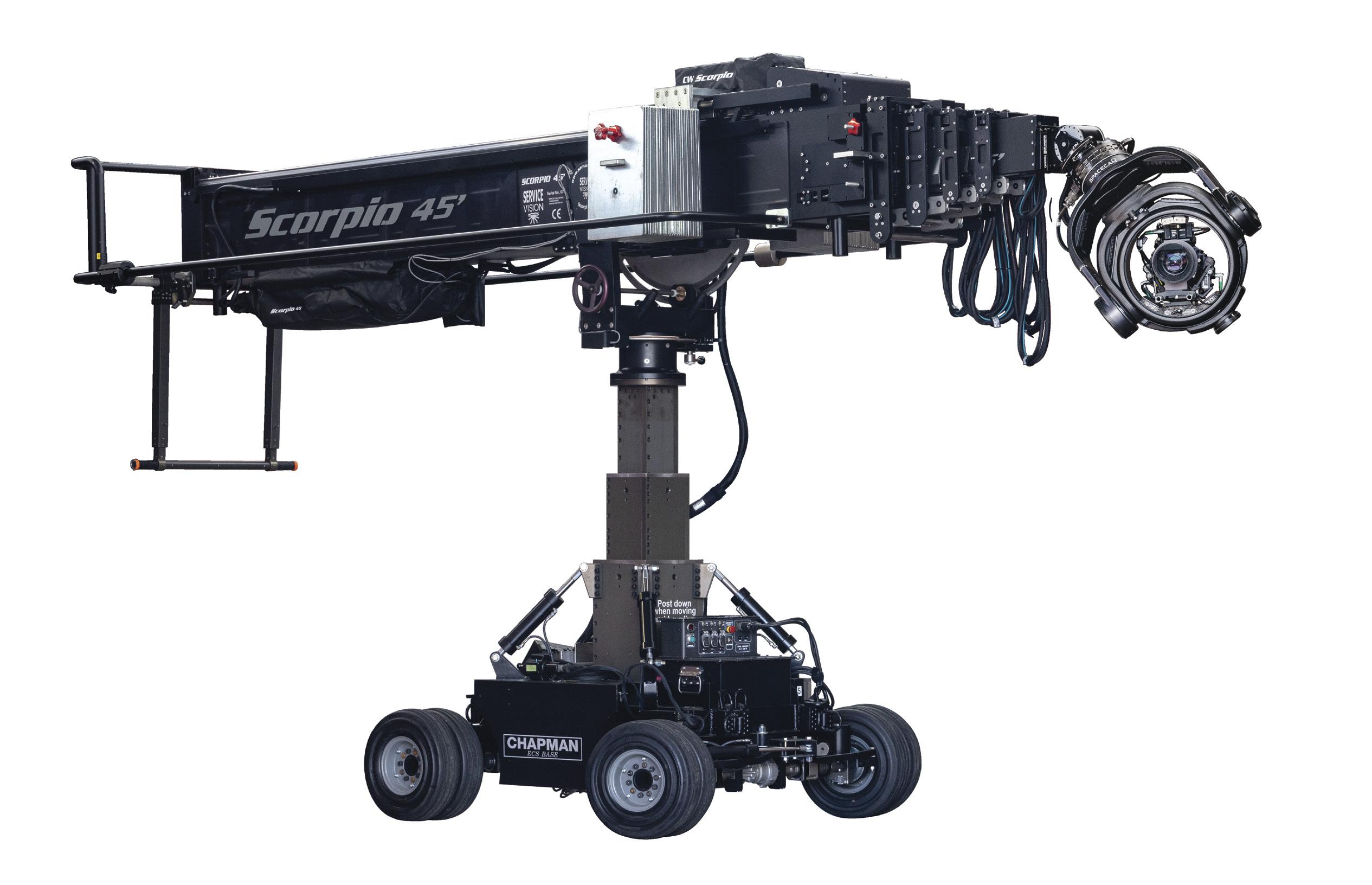
Icannot count the number of cinematographers who (once upon a time) used film stocks to differentiate their projects, telling me that, today, they accomplish the same goal with vintage lenses. It’s not only because sensors in modern digital camera systems capture at resolutions so high as to create a hyper-version of reality (sending filmmakers scrambling for any tool that can restore a socalled “cinematic” look). Vintage lenses, like film stocks, belong to an era when technology was crafted by hand; when aberrations in glass, coating, flare quality, sharpness, and any other number of factors once used to describe the “character” of a lens gave each lens, well, character.
Or, as Director of Photography Jay Holben, ASC, describes in Pauline Rogers’ superb feature, True Vintage Glass Explained (page 72), vintage lenses represent “the images of the collective memory of filmmakers who grew up in a pre-digital era. These nostalgic, softercontrast, more aberrant [or high-character] lenses imbue an emotional response in the audience to the story being told. They aren’t a perfectly faithful representation of the world as we see it, but rather a more artistic and, dare I say, painterly or impressionistic view that may better represent how the filmmakers see their stories.”
Painterly? Impressionistic? Artistic?
Even those words feel out of tune with the digital technology that dominates entertainment today. And Holben, who along with Christopher Probst, ASC, authored the definitive guide to motion picture optics in The Cine Lens Manual, understands the ironies at play. In Rogers’ article, he goes on to cite Canon’s insanely popular K35 series (from the early 1970s), which “were not openly favored when they were released. Although they were fast [and predated the Arriflex/Zeiss Super Speeds], most cinematographers saw them as ‘low-budget lenses’ with far too many aberrations. These lenses were practically given away for just a few thousand dollars per set for decades. Today, these poor, rejected lenses are now some of the most coveted vintage glass around,” selling for upwards of $250,000.
Oliver Schietinger, co-principal of TCS, goes one better, describing today’s appetite for “less than perfect” vintage lenses as a massive shift from the celluloid era, where cinematographers “demanded lenses to get better – better corrected, fewer aberrations, higher contrast.” Schietinger told Rogers that “attempting to argue in favor of designing new lenses with optical flaws [has] led to some confusing conversations with the top cinema lens manufacturers. I think I even managed to – unintentionally – insult one lead optical designer. And I get it. It’s counterintuitive.”
Working with vintage glass is not without its challenges. First AC Justin Watson, from FX’s Emmywinning series Atlanta, describes, in Rogers’ piece, how “[many vintage lenses] can’t resolve wide open like modern glass, and DP’s who like to live at a wideopen stop by default end up needing to close down on specific shots to get some sharpness back. If they don’t, the image contrast and resolution fall apart.”
But even with the speed bumps, Guild filmmakers continue to love on old glass. In Matt Hurwitz’s cover story on Big George Foreman: The Miraculous Story of the Once and Future Champion (page 26), John Matysiak and David Tattersall, BSC, along with Matysiak’s longtime focus puller, Geoff Storts, and B-Camera Operator Sam Willey’s assistant, James Teninty, used more than 23 different lenses. Those included the Hawk C Series and V Series anamorphics, and a Kowa 40-mm anamorphic that helped to visualize the distorted rage that propelled Foreman to the top of the boxing world. Likewise for the extensive flashback scenes in the new Apple TV+ series The Last Thing He Told Me (page 58). Michael “McD” McDonough, ASC, BSC, working closely with Producing Director Livi Newman (Where The Crawdads Sing) to set the look in the pilot, tested a dozen different lenses (at Keslow Camera) before deciding on the Canon K35s.
McD says the lenses “had the kinds of imperfections and organic elements” that were very different from the Signature Primes he and Co-DP Daryn Okada, ASC, used for the present-day scenes. In fact, Colorist Pankaj Bajpai says throughout the show’s postproduction process, the K35s were described as having a “buttery Chardonnay” look.

Personally, I can’t conceive of a universe where filmmakers use the terms “buttery” and “Chardonnay” to describe contemporary optics – and that pretty much sums up why the popularity of vintage lenses continues to skyrocket. It may be ironic that the same imperfections Schietinger says cinematographers once begged manufacturers to design out of lenses are now in high demand.
Or it may be something else – progress.
David Geffner ExecutiveEditor
Email:david@icgmagazine.com
True Vintage Glass Explained
“I was thrilled to have the opportunity to capture the talented individuals who make it possible for our camera teams to utilize these remarkable vintage lenses. The character and style that these lenses offer are truly distinctive, and they can be a challenge to recreate with modern equipment. Nevertheless, when paired with modern camera technology, the results are often stunning, creating a perfect fusion of old and new.”
Matt Hurwitz
A Puncher’s Chance
“I grew up in the 1960s and 70s seeing the great boxers of my generation, including George Foreman, in highprofile broadcasts of important bouts. So, to get to pick the brains of DP’s John Matysiak and David Tattersall, BSC, along with their teams, to learn how they recreated those fights for Big George Foreman , which included having the camera get hit by punches, was quite remarkable.”
CORRECTION:
In our May “Wide Angle,” Page 10, it was incorrectly stated that Crescenzo Notarile, ASC, AIC, shot Seasons 1 and 2 of Star Trek: Discovery . Crescenzo worked on Season 3 only.
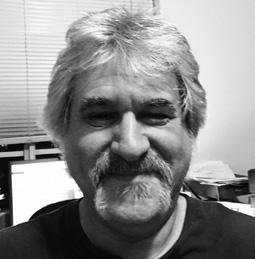
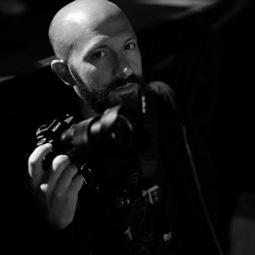

10 MAY 2023
ICG
CONTRIBUTORS
MAGAZINE
Cover photo by Alan Markfield
Photo by Sara Terry
Greg Gayne
WIDE ANGLE
October 1, 2023
Television Academy at the Saban Media Center Wolf Theatre Los Angeles, CA
www.ecawards.net

Cooke S8/I Full-Frame
PRICING: $34,650 TO $37,450
WWW.COOKEOPTICS.COM
Cooke has recently augmented its S8/i FF lens range with four new focal lengths –18, 27, 35 and 65mm. With an all-spherical design and T1.4 throughout, these lenses answer the demand for more realistic and cinematic images. They have an organic feel and a smooth, spherical bokeh effect with minimal color fringing, enabling high dimensionality. The lenses are constructed to deliver a near telecentric projection of light rays, which is more efficient for creating organic images that are both sharp and natural, with dimensional roll-off. The improved contrast results in a sharper image on screen. Produced for larger than full frame aperture, they feature a maximum T1.4 across the core focal range. The fast T stop extends the control over depth of field and lens flares but still delivers low-light performance. Additional focal lengths will be introduced throughout 2023.
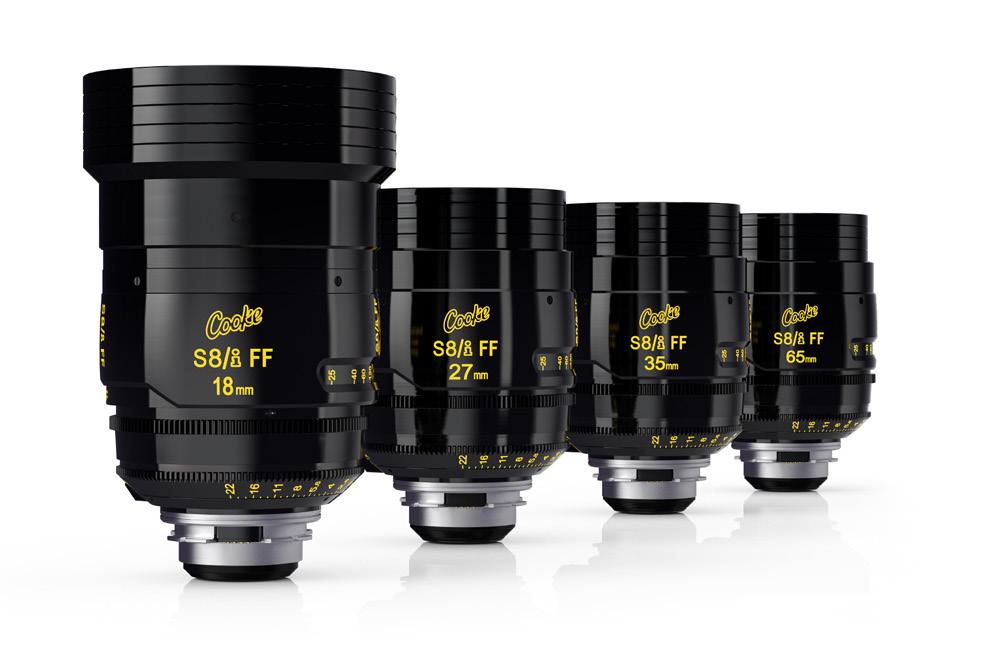
FUJIFILM Duvo HZK25-1000 Box Lenses
PRICING: $265,000
WWW.FUJINON.COM
The first in Fujifilm’s new “Duvo” series, this native PL-mount cinema box lens utilizes optical design technology to achieve a maximum aperture of f2.8 and 40x zoom ratio. In addition, Duvo 25-1000 employs a dual-format system that supports two sensor sizes: large format and traditional Super 35 mm. The result is easier filming in low light, such as at indoor concerts or nighttime events, with a shallow depth-of-field and beautiful bokeh, bringing a cinematic look to both live and commercial productions. “As a cinema DP, I don’t really do anything with broadcast equipment; I’m always shooting with high-end digital cameras, so a lens with that kind of range is unheard of,” says Daniel Pearl, ASC, who was the first to work with the Duvo on a Mariah Carey special. “Most cine lenses are either long without being very wide or wide without being very long, but this was an amazing blend of both. In a concert situation, that’s critical, because with seat kills and lines of sight blocked, the close-up camera winds up being one of the furthest away from all the other cameras in the house.”
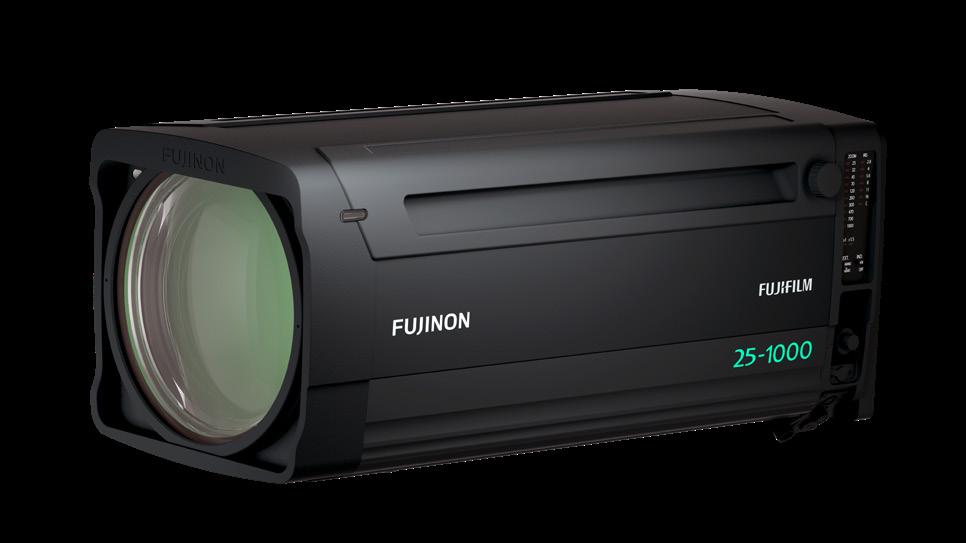
12 MAY 2023
GEAR
GUIDE
OTTOBLAD Lens Series

PRICING: CALL FOR RENTAL RATES
WWW.OTTONEMENZ.COM
Kino Flo MIMIK 120
PRICING: $8,800
WWW.KINOFLO.COM
“It’s the first ever of its kind,” says Kino Flo’s co-founder and President Frieder Hochheim. “A white-light tunable Kelvin lighting system that can display full-spectrum images as a light source that can be genlocked to a Volume. It’s become the holy grail for the visual-effects community.” An image-based video lighting tile mirrors video content, applying a higher tonal and colorrendering range by dividing the incoming RGB signal into warm white, cool white, red, green and blue. The MIMIK’s extended spectral bandwidth and cinematic color fidelity mimic talent and set elements when working with virtual production. Controlled by the Megapixel VR HELIOS LED processor, MIMIK expands realtime and post-production options, delivering 10,000 NITS and the ability to shoot as high as 960 frames per second, and offers as many as 32 alpha channels at 30 frames per second.
Otto Nemenz’s new OTTOBLAD lens series is a reimagining of the Zeiss Hasselblad T* Series featuring the optical tuner (OT). Designed with the team at P+S Technik, these rehoused Hasselblad lenses offer the ability to start with a pristine image and adjust the field resolution to a portrait-lens quality. As a result, they offer high contrast and superior resolution – as well as ultralow distortion (with the exception of the 30mm fisheye). In addition, the lenses offer a minimized close focus distance at nearly half the original distance. The built-in optical tuner is dialed-in using the engraved reference numbers (0 to 6 and each quarter in between) and has an optional locking feature. Lenses range from 30 to 150 mm, with 180mm and 250mm soon to come.

13 MAY 2023
GEAR GUIDE
Panalux Allegra
PRICING: AVAILABLE TO RENT
WWW.PANAVISION.COM
Nanlux Evoke 900c

PRICING: TBA AFTER NAB, UPON RELEASE WWW.NANLUX.COM
This powerful RGBLAC LED light fixture is approximately equal to a 6K Tungsten fixture but with the intense saturation and extensive color space of RGBLAC technology. Equipped with its RGBLAC LED ARRAY, this is a sophisticated high-speed processor with accurate color mixing throughout the dimming range, yet is responsive to the most demanding aesthetics. The Evoke has Art-Net/sACN’s infrastructure built in, and the new protocol, with the ultra-high-speed refresh rates of the entire NANLUX brand, makes it artifact-free and controllable for use on Volume stages. Ryan McIntyre, owner of Cine Speed Productions, was one of the first to test the Evoke 900c, which will be released post-NAB. “It has ultradurable water- and dustproof housing, consistent with the IP certifications of the Evoke line,” McIntyre says. “This fixture is more than double the output of any other RGB LED light on the market. From my testing, I found that throughout the whole color range, it was flicker-free up to 10,000 fps. We’re looking forward to using it in the studio and on location for shooting high-speed setups in RGBLAC color space.”
The Panalux Allegra system provides a range of lighting options. Available in full-color and bi-color versions and a variety of form factors, the lighting heads have a lightweight and slim design for seamless rigging, even in small or hard-to-reach places. Allegra C heads incorporate a new proprietary light engine that produces a broad-spectrum wide CCT range and enables fine color rendering. Panalux bi-color Allegra heads offer tunable white-light output with a consistent, broad, and even spectrum, ensuring precise colortemperature control and natural skin-tone rendering. “The Panalux Allegras have great output and a very good color gamut, and the lightweight is very useful,” adds Chief Lighting Technician Theo Milford. “The ability to wirelessly control the lights from a lighting desk makes cable management much easier.”
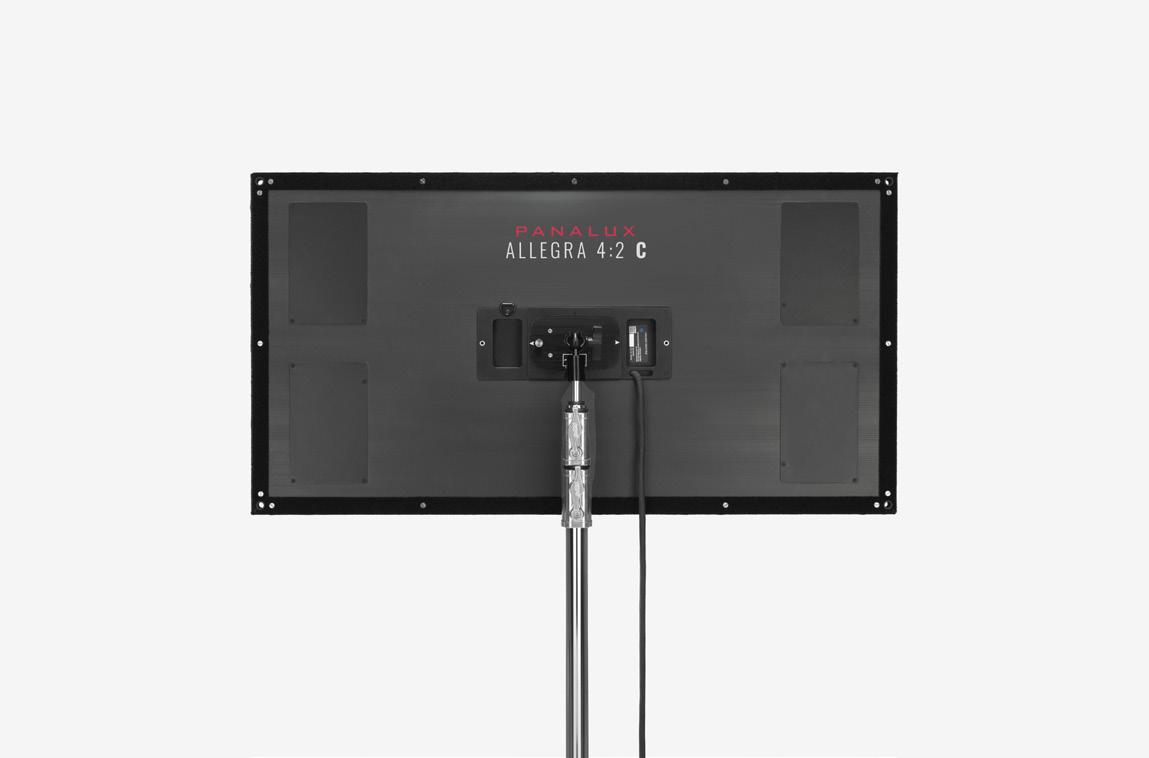
14 MAY 2023
GEAR GUIDE
Dedolight Lightstream
PRICING: STARTS AT $5,800
WWW.MRMOCO.COM
Dedolight’s Lightstream reflector system is designed to deliver highquality reflected light from reflectors of various spread indexes and sizes. It also allows users to produce brighter, more controlled light with fewer fixtures, opening lighter spaces to shoot and reducing the set’s grip footprint. Power savings is considerable, making it an eco-friendly choice for studios and professionals. The reflectors redirect a light source or add 12, 50 or 90, depending on the reflector index. An additional reflector has an anamorphic effect, spreading light into a strip. Used with Dedolight Beam intensifiers, it is possible to split the origin beam with a reflector and create two new light sources with additional reflectors. The intensifiers increase the output of a Dedolight up to 600 percent in a tight spot (2- to 9-inch beams), enabling users to have brighter beams with more impact from reflectors. They are available in various sizes, including 7×10 cm, 12×15 cm, 25×25 cm, 50×50 cm and 1×1 m.
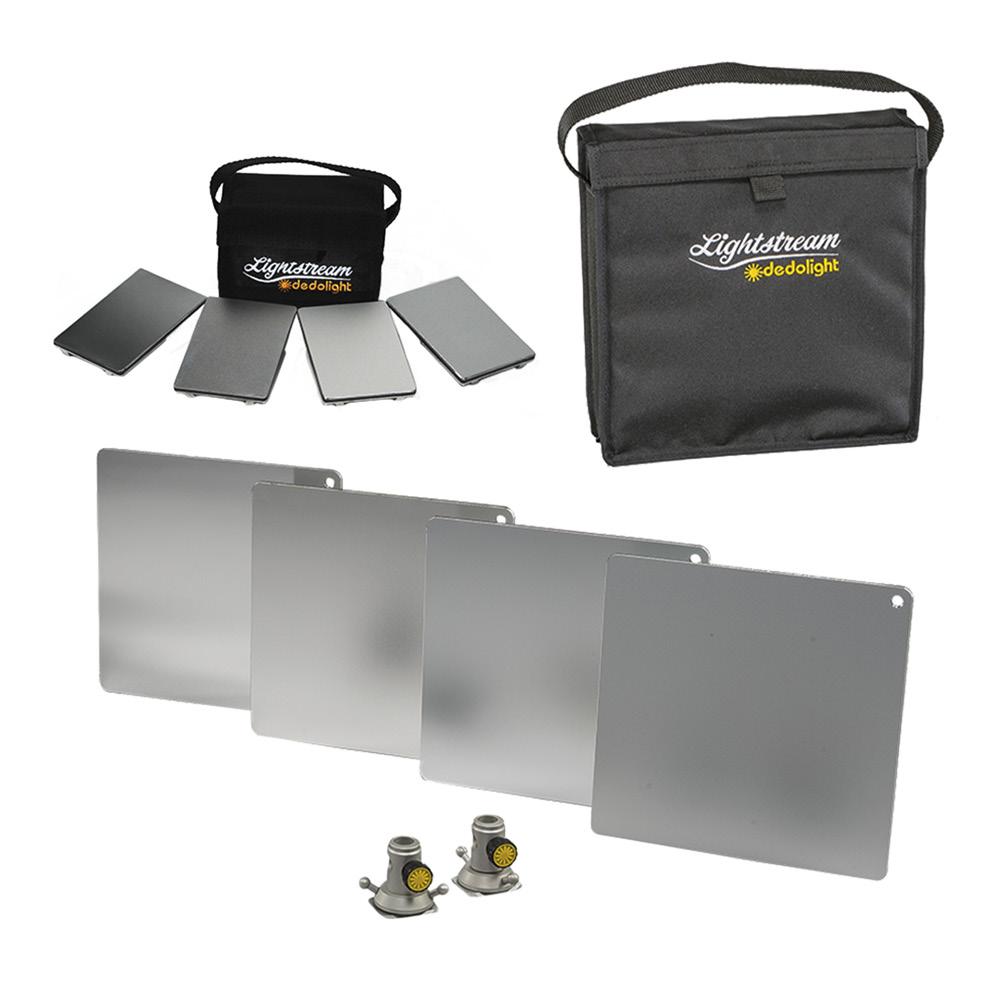
Stargate Studios’ ThruView
PRICING: DEPENDS ON JOB REQUIREMENTS
WWW.STARGATESTUDIOS.NET
With a Volume that is fully mobile and installed on stage, Stargate Studios brings real-time VFX to shows like Station 19 , Your Hono r, The Lincoln Lawyer , and the new WB sitcom How To Be a Bookie . “It’s a scalable, virtual production process that successfully meets the creative demands, tight schedules, and varying budgets of multiple films and television series,” explains Stargate Founder/CEO and Virtual Production Supervisor Sam Nicholson, ASC. “Offering high resolution, mobile LED walls with integrated camera tracking, and pixel-tracked kinetic lighting, ThruView delivers finished sequences on the most demanding shoots.” In addition to filming custom plates, Stargate designs unique display and playback configurations to fit each production’s workflow. It employs advanced Silverdraft servers that distribute multiple 8K images through synchronized DaVinci Resolves to mobile Aoto P1.5 LED walls, Sony OLED monitors, and DLP projectors. For three-dimensional content, Stargate’s computer graphics team integrates Epic’s Unreal Engine with pixel-tracking lighting units from Kino Flo, Prolycht, and Nanlux for a photoreal result.

15 MAY 2023
GEAR GUIDE

16 MAY 2023 DEEP FOCUS
DAN MING
depending on the operator, to check sharps. On Life of Pi in 2010, it was the CineTape. But we had to check the monitors, mainly to make sure both eyes were matching, using Master Primes wide open frequently. We were rarely able to get too close to cameras because of being tethered to the convergence carts, so pulling off the monitor with CineTape reference was how we did it.
On American Sniper, in 2013, Clint Eastwood’s style was one take and move on. We had one chance to get it right. But we rehearsed and would block and had a decent stop, and that always helps to get things in focus.
Pulling focus is always about constant communication with the camera operator, anticipating what they might do, and letting them know if something is happening out of the frame that might potentially affect the shot. When shooting on film, especially, pulling focus is also about feedback from the operator since the view through the eyepiece is the highest-resolution view of the shot.
On the focus knob, you are right next to the operator’s ear, and they can whisper if you are near or far, as well as nudge the knob in situations where verbal communication isn’t possible. With film and remote focus, John Connor had a system I learned that worked well, where a mic was on the eyepiece, and he wore an IFC. The operator could whisper anything, and he would be able to hear it from wherever he needed to be to see marks when the view was obstructed by the camera.
Fast lenses, like ARRI’s T1.4 Master Primes, came out while film was still going strong, and then it became necessary to be accurate with focus to the inch or sometimes less. Being on remote focus off to the side let us see more precisely where the actor was relative to the marks. Once digital cameras kicked in, the focus became even more unforgiving, especially wide open.
Today, many operators are looking at HD eyepieces and small onboard monitors, and many AC’s are on larger monitors off to the side. I use a SmallHD Cine 13 4K monitor and feed whenever possible. 4K comes
in handy on wider lenses than longer, as it’s easier to see if something is out of focus on a long lens. But if something is out on a wide lens, for whatever reason, it may not be caught unless you are looking at a 4K signal.
A blend of methods is the best way to approach the focus on a given shot. Example: a long-lens shot of someone driving, running, riding a horse or riding a motorcycle towards you. One: Have the second AC count-off marks as they come towards you. As long as the second has a good view, this method is foolproof, regardless of foreground crossing. Use landmarks as backup marks in case they lose sight. Two: Pacing is very helpful – if it is a straight run towards you, speed tends to be more or less consistent, and if they are running at 20 feet per second, then pulling focus at that rate will keep you close between marks. I have used a Wards Sniper to judge that as well – the super-narrow beam will track distance from very far away. Depending on the speed, you can just pay attention to each foot or every 10 feet to feel the pace as they approach. Three: Put marks on the ground. This works great for the last 30 feet if they are running into a close-up. At this point, a closer-range focus-assist unit, like the Light Ranger 2, can pick them up and give you a feel for their deceleration until they stop.
The job is always evolving, as does technology. Yet some tools are still valid today. When we were doing CSI: Miami in 2003, it was on film, and we were on the long end of the 11:1. We used the Ward’s Sniper,
When I was on The Founder , in 2015, we were working with the ALEXA and Panavision G-series anamorphics. I had the first Light Ranger and was testing it. I initially used it like a CineTape that I could aim precisely as needed during the shot. It took a while to get used to the graphical overlay, but basically, it is a simplified 3D representation of the frame and is very effective, especially in seeing subtle movement on a flat screen.
For Top Gun: Maverick in 2018, we were testing new things. We were on the Sony VENICE with Beta firmware. We had to keep a lot of cameras on the original firmware because of the prototype umbilicals for the jet rig. We had to put everything through their paces – shock and vibration testing, g-force tests, as well as shear testing to make sure the rigs could take it, and remanufacture some components that didn’t quite cut it. Once the kinks were worked out, it was about being diligent and consistent for the safety of the pilots and actors and getting footage on the 12 cameras in the two jets every time.
I’ve been asked frequently if there is a right or wrong way to pull focus. And my answer is that it’s important to be familiar with all the available techniques. I sometimes will switch from setup to setup just to practice. The entire filmmaking process is about having a plan and then adjusting to the reality on set when the shot happens, and that applies to focus, and having a bag of tricks helps when adjustments need to be made on-the-fly.
Ultimately, all that matters is that the shot is in focus. But it’s important to remember that the best way might not always be the easiest way, but the way that makes sure that everyone can accomplish what they need to on set. Like moving a bit so that the unit still or the boom operator can get a good angle, staying out of the actors’ eyelines or lighting that the DP and gaffer have set up. It’s a team effort.
17 MAY 2023 05.2023
PHOTO FROM TOP GUN: MAVERICK BY SCOTT GARFIELD, SMPSP / PARAMOUNT PICTURES
1ST ASSISTANT CAMERA

18 MAY 2023 DEPTH OF FIELD 18
NYC FILM WORKSHOP
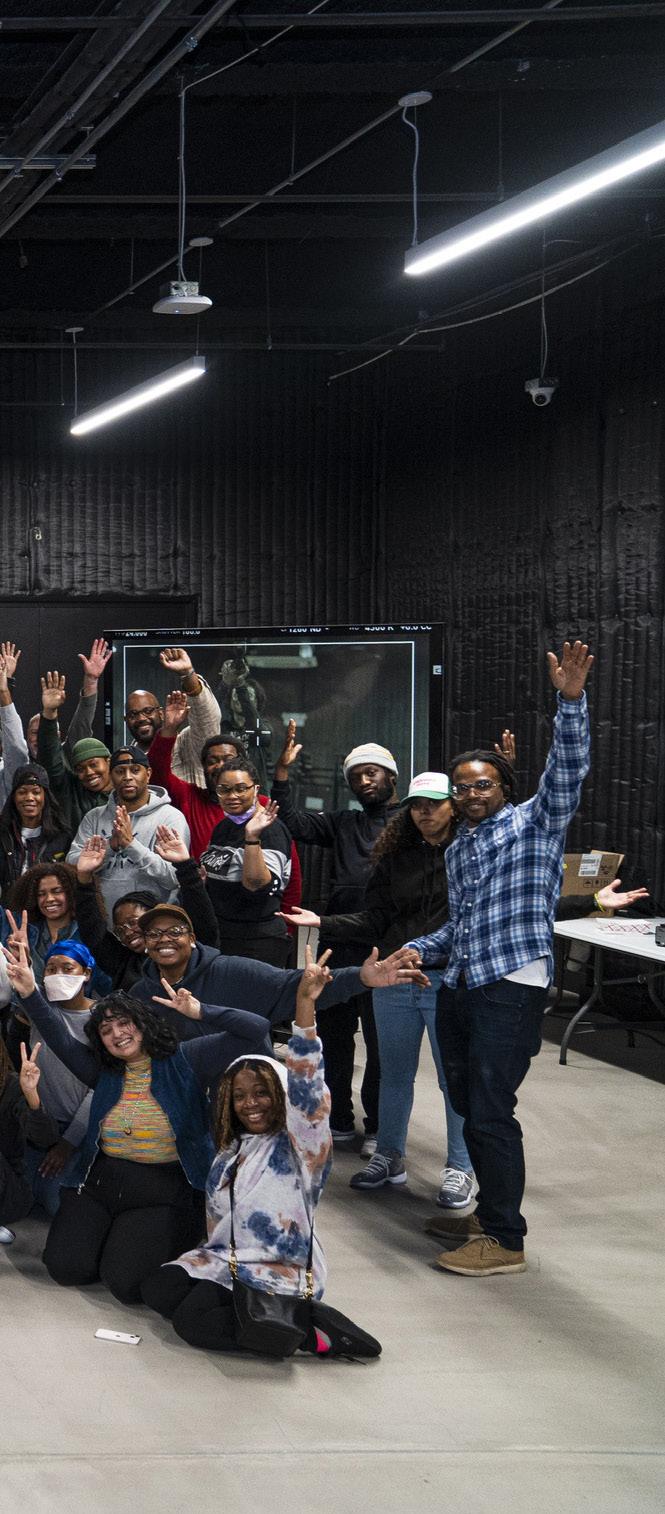 BY PAULINE ROGERS PHOTOS BY ALYSSA LONGCHAMP
BY PAULINE ROGERS PHOTOS BY ALYSSA LONGCHAMP
When Michelle Clementine was an AC in New York, she would invite people to her preps at rental houses. When she moved to L.A. and became a camera operator, she had difficulty finding Black and female crewmembers. “I had to do something about that,” she says. “In the spring of 2022, I hosted a free AC workshop for Black and Latina women, using the ARRI Mini’s at I.F.B. Studios, and about 50 women came. I was blown away by the turnout – with some flying in from D.C. and St. Louis. In the fall, I did my second workshop.”
The idea generated more events, and e-mails started to pour in. So why wasn’t this being done in New York City? A conversation with John Sakellariou at ARRI, Clementine’s former tech boss, took the event in an exciting direction. “Why not do this with film cameras?” he suggested. “We’ve seen more film projects in the past six to eight months where there’s
19 MAY 2023 05.2023
19 MAY 2023
been faulty light leaks and user errors,” he explained. “AC’s on big projects get selected because they have film experience. But low-budget productions usually hire AC’s with little or no experience. Also, ARRI has this great new building available, and community engagement is important to us. So this was a great way to approach this issue.”
Clementine then reached out to Zeiss, BoxedUp, and Kodak, and they jumped aboard. It was perfect timing for Kodak, as they were looking for ways to celebrate 100 years of 16mm film. Reaching an eager audience was easy, and the February 12th NYC Film Workshop was a huge success. As Clementine enthuses: “Nearly 100 people attended, including several union members who served as proctors, and teens from the Ghetto Film School program.”
Guild member Autumn Moran was excited to be one of the proctors. “I love working with film and think it is very much still a valuable and in-demand skill today,” she says. “I was the AC on several film projects, and I had a list of film loaders that I could call on that I knew could handle it. But unfortunately, that list would shrink as people moved up, and it became harder to find a film loader for a tandem unit.
“The interest and enthusiasm displayed by the younger members were so great to see,” Moran adds. “Especially when starting out, being comfortable working with film will quickly make you stand out and open up more opportunities. The depth of questions being asked and how seriously they were taking the process was wonderful.”
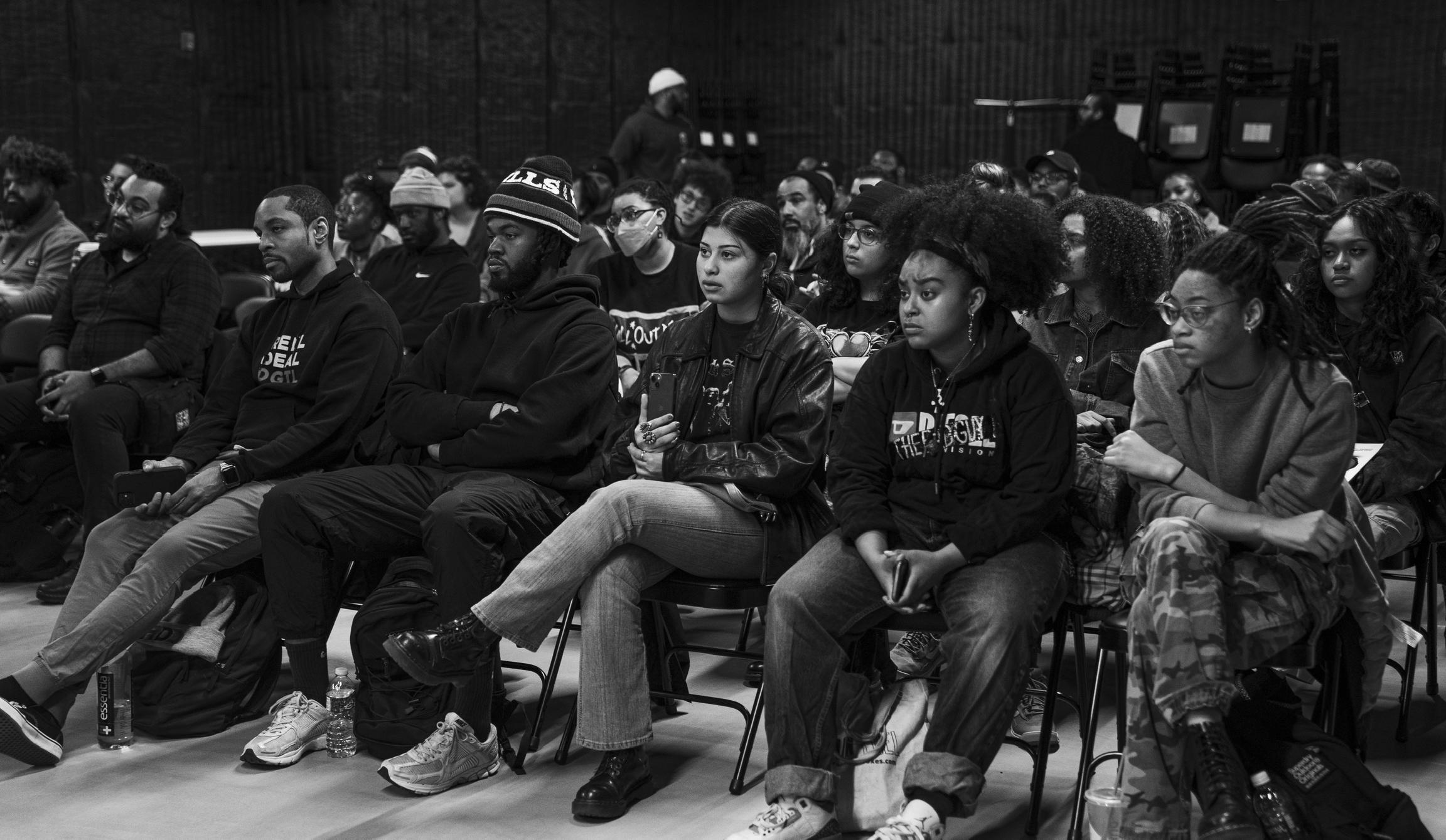
Another member who joined at the last moment was veteran AC Chris Silano, who says his message was: “it’s not about the machines. That’s fun and easy
to learn. It’s about a community of filmmakers wanting you to succeed, welcoming you, and supporting your vision.”
Silano’s enthusiasm was shared by his loader, Kristina Allen. A young Black woman who is on the shy side, Silano said working with new women filmmakers built Allen’s confidence as she explained how she’d just gone through what they were about to. “I genuinely love getting hands-on with film,” Allen recounts. “It’s such a different feeling than loading digitally. Also, exploring the details of the camera, mags and film with fellow and aspiring Local 600 members was a fun experience. There were a few cameras and mags that I hadn’t worked with before. It was interesting to see the differences between 16-millimeter and 35-millimeter film as well as how to mount different mags for various camera bodies depending on the desired result.”
NYC-based AC Christopher Gleaton was excited to have the opportunity to work with filmmakers who had never touched celluloid. “Working with film has dictated the on-set workflow of this industry to this day, and I feel it’s an excellent teaching tool to prepare this incoming workforce,” Gleason shares. “What was unexpected was the diverse group of [union] members there to lend their expertise. Everyone I spoke to stood out because they all brought a different approach. As much as dealing with film is a regimen, it also allows you a personal connection. I wanted to give everyone an opportunity to have a relationship with the medium. I felt like that would be something unforgettable for them and something
they could build up later as they developed in the business.”
For Local 600 AC Sammy Leonard, the event inspired him because of the eagerness and excitement of the attendees. “Most of them seemed to be in their mid-20s, but there were a few who were older that were looking to transition,” Leonard recalls. “They wanted to learn foundational skills. For example, one person needed to learn how to load an ARRI 416 mag for a potential job, and I taught him how to do that. Days later, he tagged me in his Instagram story as a thank you – he got the job!”
“The energy, the enthusiasm, and the smiles from everyone in that room was such a beautiful thing for me to witness,” concludes Clementine. “I’ve done digital workshops in L.A., but being able to bring this home and do it for film hits differently.
“It’s really easy to see what the camera world lacks as far as diverse crew makeup,” Clementine adds, returning to why she began this workshop. “But we all have a part to play in changing the culture of camera for the better. As an AC, I invited people to prep. Now, as a cinematographer, I’ve been able to rely on my relationships with rental houses built over the years to train dozens of people.
“People are hungry to grow their skill sets and eager for opportunity, and giving them my time sharing what I know has been truly rewarding. People who have a love for the camera but didn’t know Local 600 existed are now moving into careers as working AC’s. Being able to teach them film cameras means a whole new generation – of union filmmakers –has acquired skills that will keep them working for decades.”
20 MAY 2023 DEPTH OF FIELD 20


21 MAY 2023 05.2023 21 MAY 2023
GEORGE TILLMAN JR.
BY MATT HURWITZ

Filmmaker George Tillman Jr. has written, produced, and directed a wide variety of projects, the vast bulk of them centered on Black life in America. Tillman’s gift, among many, is his ability to take a specific swath of the Black experience and make it appeal to a wide audience, beyond the world he came from. The Milwaukee, WI native studied film and video at Columbia College Chicago, where his short film Paula, about a single teenage Black mother, won a Student Academy Award (1992). Tillman self-financed his first feature, the unreleased Scenes for the Soul, before breaking out big with 1997’s Soul Food, a warm, down-to-earth film about a Black family in Chicago, rich with strong female characters.
Tillman followed up Soul Food with a military drama, Men of Honor (2000), starring Cuba Gooding Jr. and Robert De Niro, which focused on an everyday hero’s challenges confronting racism in the military. Two years later Tillman began the first film in the popular Barbershop series (directed by Tim Story), about everyday Black life in a South Chicago neighborhood. 2009’s Notorious brought audiences inside the life of rapper Notorious B.I.G., while his most recent feature, 2018’s The Hate U Give, details the realities a Black family faces in an America where a simple traffic stop can lead to death. Tillman has also helmed episodes of This Is Us and Power, as well as his new series for Disney+, Crossover ICG Magazine talked to Tillman about the challenges inherent in his latest feature project, Big George Foreman: The Miraculous Story of the Once and Future Heavyweight Champion of the World (page 26).
22 MAY 2023 EXPOSURE
PHOTO BY KYLE KAPLAN / SONY PICTURES
DIRECTOR | BIG GEORGE FOREMAN: THE MIRACULOUS STORY OF THE ONCE AND FUTURE HEAVYWEIGHT CHAMPION OF THE WORLD

23 MAY 2023 05.2023
ICG: So many of your films, including this one, provide an authentic window into Black life in America that appeals to all audiences. How do you accomplish that? George Tillman Jr.: The first thing I always think about in a story is: What is the universal theme that’s important and that an audience can walk away with? I know everybody wants to be entertained. But I always feel – whether I’m reading a book or even listening to music – that there’s one unified theme. And I can only make a movie if I learn what the subtextual moment is inside a film. I always need to look on the inside. And sometimes, as a director, it’s not all about just directing actors. It’s mostly about making sure everybody’s telling the same story. The first thing I do is define the theme – what are we trying to say in the film and what is it that unites every character? That’s key to having every department on board.
What do you think put you on that path? Long ago I saw Barry Levinson’s Avalon , which is about a Jewish family moving to Baltimore, and I was just struck by it, thinking, “Oh, my God – this is an epic film about this family, over many, many years.” And even though that family’s completely different from
my family, I was able to identify with that story. Barry Levinson is a filmmaker who really delivers a universal thought, in a very specific culture. And because of that, I was able to learn something. That’s what I wanted to be able to contribute as a filmmaker.
Starting with Soul Food , which centers around weekly family dinners, all the way up to The Hate U Give , your films have common threads, even if they’re about entirely different people. Growing up in a lower-middle-class working family in Milwaukee, those Soul Food -type dinners were every Sunday, every week. And one of the things I realized was that no matter how tough things were, family always stuck together. And when we didn’t have those dinners, families came apart. Even in [ Big George Foreman ], in the first scene, George and his family move into a new home, which is not the best. But here they are doing the same thing, around the table, even though the table is lit by a single lantern – because his mother can’t afford electricity – and there’s hardly any food. But the family component is still there, and the mother’s spirituality is still there, no matter how tough things get. The Hate U Give
started with a scene with the father teaching his young kids how to respond/behave if they’re pulled over by a police officer, showing them by putting their hands flat on the table. In my own life, before I even talked about the birds and the bees, I was taught how to conduct myself when a police officer pulls you over! So, I wanted to illustrate that to an audience who may never have experienced that reality. But they can connect with the concern of a parent.
How did you apply this to telling George Foreman’s story? After coming off The Hate U Give , which is about police brutality, I found this beautiful story about a young man who, at the heart of it all, was just trying to find some kind of validation. In the film, we see a teacher who ignores him because of the way he’s dressed – you know, just writing him off. And every time he’d go to a new school, the teachers would ignore him. I thought: that is the simplest universal thought – that we all want validation. We all want to mean something. This movie is about a young man who was so angry because he wanted that validation. And when we get to the second half of the film, we see him finding how to become

24 MAY 2023 EXPOSURE
24 MAY 2023
PHOTO BY ALAN MARKFIELD / SONY PICTURES
something different, to be who he always had the potential to become. That’s something we all think about. George has a spiritual awakening, where he had something to believe in other than himself. The primary theme, in the first part, is selfishness, about trying to find things in the material. And that idea defined the color scheme and the look. The second half is awakening. I can show both, visually. Break it down using color schemes and photographs.
There was quite a lot of material to cover, working within a relatively short 50-day schedule. How do you make something like that work? Our original script was 140 pages, which got whittled down to 138! And that was a tough one because there was so much good material that I wanted to keep in the movie. But what we did was, we shot everything. We didn’t stop. We’d be shooting four or five scenes a day. And the key was to work fast, which this unbelievable team of professionals was able to do, from top to bottom. And it helped to not only do two weeks of rehearsal with our actors but also a week of camera rehearsals to choreograph coverage for our many boxing scenes. One thing that was helpful for me was that a lot of my early films were done on a tight budget. When you
make films about African-American culture, you’re not getting the highest budget. [Laughs.] They got your back, and you want to make this movie, but it always comes at a cost. So, I’m used to shooting fast. But it does become frustrating, as a filmmaker, especially when you see people with 100-day schedules. Still, as I said, the most important thing is to stay subjective to the story and the theme. Not shooting coverage just to shoot it, but to approach it with, “What is the point of the scene? What are we trying to say?” And my coverage is going to dictate that. Not just shoot a wide, master, medium, move on. I want to stay subjectively with the character, to stay in George’s point of view throughout the whole movie. So, to answer your question: I maintain speed by maintaining a subjective, cinematic approach, and don’t shoot more than we need. And, because of the prep we did, we can all be instinctive with each other.
How do you think your experience working in television has helped? Working on shows, doing the pilots I did, or working on Power or This Is Us , which I did between features, all helped. This is Us [ICG Magazine February/March 2019] shoots an episode in nine days. But on Power, you can do an
hour episode – actually, two, shot concurrently – in 20 days, with the same DP, shooting both action and drama. But also, working with De Niro on Men of Honor, and learning about his process, and how you can make the most out of one take. You just keep your take going, and make the most of one or two takes. I could do five takes within one.
With a lot of “okay, go again.” (Laughs) You got it!
For the boxing scenes in Big George Foreman , you prefer to be in the ring, not far away in a video village, which the camera team said they appreciated. I love to be where the action is. I always love to be where the camera is, where the camera operator and camera assistants are. If I’m near the monitor, I feel like I’m just watching the scene, that there is a distance between me and the performance. I can see the truth and honesty of the performance from the actor when I am next to the camera. Yes, standing there for 10 or 12 hours is exhausting, but I’m part of the creative process when I am there. In terms of the boxing scenes, being near the camera allows me to dive into George’s point of view. Every action scene has its character objective, subtext and obstacles. Being in the ring, I can find those moments, in the middle of all these great visual shots [operators] Sam Willey and Kirk Gardner are capturing for us. I can give adjustments without having to cut the camera. I want the actors to know that I’m watching carefully and that I’m creating with them.
The Barbershop series, which you produced, was groundbreaking Black comedy in its day. Would the original Barbershop (made in 2002) be different if you made it today, in terms of the audience and its overall appeal? I still want to go back and produce another sequel for the series, because it’s still so relevant and interesting. Going to the barbershop today, it’s still a place where everybody’s got something to say – locally and socially. When I’ve been out of town working on a movie, I can go into my barbershop, and catch up on the whole neighborhood and what’s going on with everybody. These stories never die. They just keep going. And that’s something I’d love to revisit; something that appeals to everyone and will never go away.
25 MAY 2023
05.2023
“I found this beautiful story about a young man who, at the heart of it all, was just trying to find some kind of validation.”
25 MAY 2023
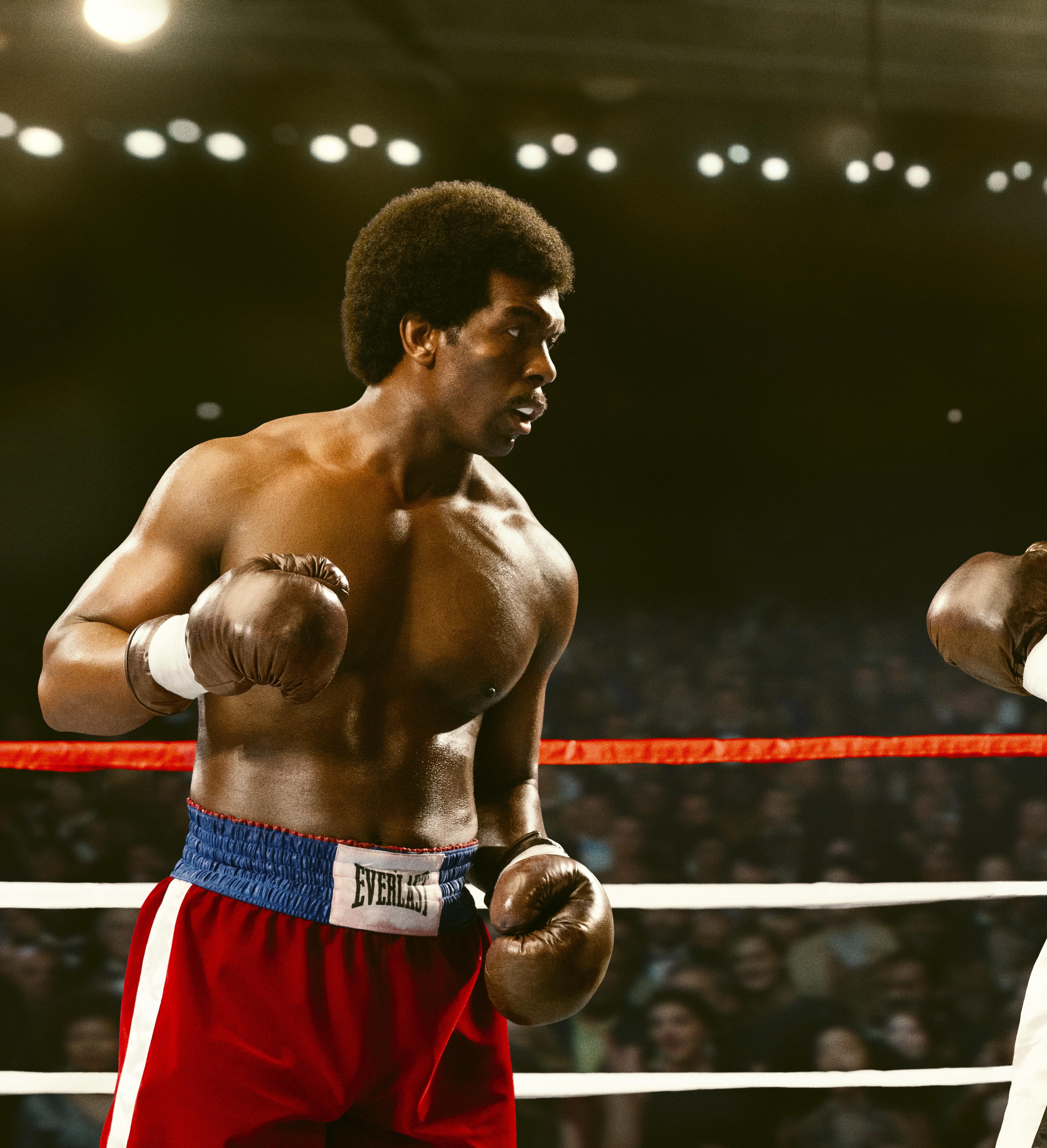 BY MATT HURWITZ PHOTOS BY ALAN MARKFIELD / COLUMBIA PICTURES
BY MATT HURWITZ PHOTOS BY ALAN MARKFIELD / COLUMBIA PICTURES

John Matysiak and David Tattersall, BSC, help bring the one-of-a-kind life story of “Big George Foreman” to the big screen.
A PUNCHER’S CHANCE FEATURE 01
FRAME GRABS COURTESY OF COLUMBIA PICTURES
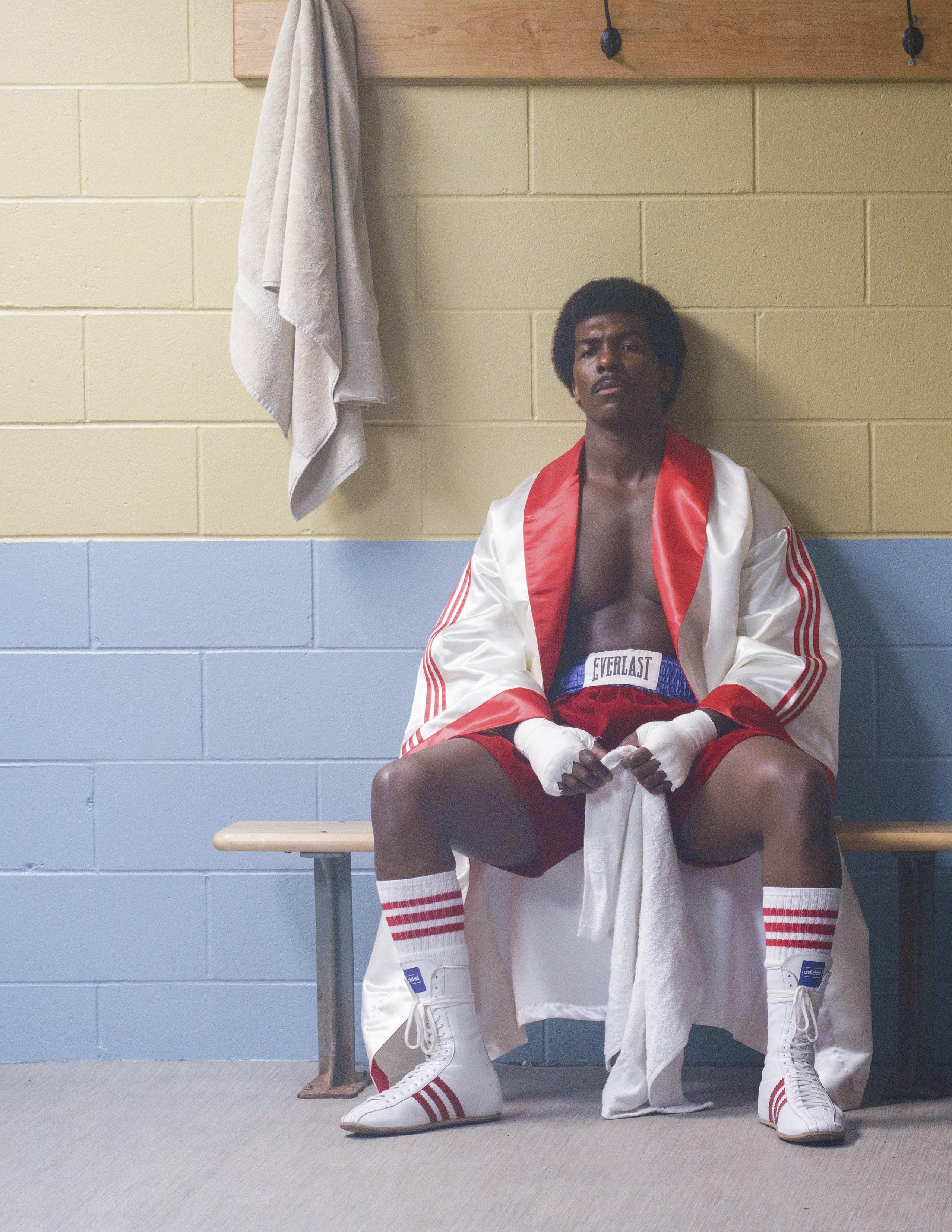


Two-time-world-heavyweight boxing champion George Foreman began life in poverty, a misery he pulled himself out of with a combination of anger, determination, and self-obsession. Somehow he rose to the top of the fight game, winning countless highprofile matches before being crushed by Muhammad Ali in the legendary “Rumble in the Jungle” in Zaire, Africa, in 1974. Beating former heavyweight champion Joe Frazier for the second time a year later, Foreman then came into a fight out-of-shape and unprepared with Jimmy Young. Enduring a particularly brutal loss (and suffering from heatstroke), “Big George” had a near-death experience in his dressing room after the match. Convinced he had seen God, in a “hellish and terrifying realm,” Foreman soon became a born-again Christian. Trading boxing for a street-corner ministry (that grew into a large congregation and youth center in Houston), Foreman preached for 10 years. He returned to the ring (at the age of 38), mainly to escape the crushing debt taken on to fund his church work. In 1991, he unleashed a surprising challenge to the undisputed heavyweight champ of the world, (a much younger and fitter) Evander Holyfield, that fell just short of success. However, three years later Foreman recaptured the crown he had lost to Ali 20 years prior by knocking out Michael Moorer in the tenth round, becoming the oldest heavyweight champion in fight history at the age of 45.

31 MAY 2023
That’s a lot of history to cover in two hours – and, even tougher, an immense amount to shoot in a slim 50-day schedule, including 12 boxing matches. But Director George Tillman, Jr. ( Exposure , page 22), along with Guild Directors of Photography John Matysiak and David Tattersall, BSC, managed to do just that. The result is Sony Pictures Entertainment’s new feature, Big George Foreman: The Miraculous Story of the Once and Future Heavyweight Champion of the World.

Originally known as Heart of a Lion , the project was designed to be shot in two blocks: the first, filmed by Matysiak and covering Foreman’s early life through becoming a preacher in 1978. The second block, shot by Tattersall, picks up seven years later, when the former champ – now overweight and still preaching – opens the youth center, and eventually returns to boxing to pay the bills. A six-and-a-halfweek hiatus was built into the schedule to allow star Khris Davis to gain weight. The entire production was shot in and around New Orleans and Baton Rouge, LA.
Tillman brought in veteran Camera Operator Kirk Gardner, SOC “for his experience with action and the Steadicam,” the director states. Matysiak had worked for eight years with B-Camera Operator Sam Willey, along with Willey’s focus puller, James Teninty. “So, they brought two different styles – Sam, coming from the run-andgun indie world, and Kirk coming from the Hollywood system,” Tillman recounts. Adds Matysiak, “It was like having two A-Camera operators. In fact, we referred to them as ‘Red and Blue.’ We had a pretty deep bench.”
Willey’s talent operating the Mōvi Pro proved pivotal to the fight scenes. “Sam has developed a unique way of operating the Mōvi,” Tattersall describes. “It’s something he has mastered.” Adds Matysiak, “His instincts for covering boxing are very similar to mine. When you’re shooting a fight, you don’t have time to tell an operator what to do. You have to trust them.”
The Mōvi rig was customized by
Willey, who did his own machine work to make the rig specific to his methodology. “I have the settings set such that it turns at a certain speed, which gives you a certain smoothness not unlike what a Steadicam operator does with their hands and feet, but here through the software,” he explains.
Willey’s Mōvi skills were put to use to gather shots otherwise shot on a dolly, but in a fraction of the time. “With our schedule, if there was a shot we could do without laying 30 feet of track, I could just have Sam walk with the camera on the Mōvi,” Matysiak explains. Notes Teninty, “I know only two Mōvi operators who can make it look like Sam does – and he’s one of them.”
NOLA Guild member Penelope Helmer pulled focus for Willey during Block 1, before Teninty joined the team for Tattersall’s block. Matysiak brought his longtime focus puller, Geoff Storts. L.A.based 1st AC Yen Nguyen traveled to NOLA to pull focus for Gardner on Block 2. “Geoff and James have such incredible instincts. They just know what lenses we’re going
32 MAY 2023
ABOVE/RIGHT : CO-DP JOHN MATYSIAK SAYS SAM WILLEY’S SKILLS IN OPERATING THE MŌVI PRO WERE PIVOTAL TO CAPTURING THE FIGHT SCENES.

“SAM’S INSTINCTS FOR COVERING BOXING ARE VERY SIMILAR TO MINE. WHEN YOU’RE SHOOTING A FIGHT, YOU DON’T HAVE TIME TO TELL AN OPERATOR WHAT TO DO. YOU HAVE TO TRUST THEM.”
TOP LEFT : FOR FOREMAN’S (KHRIS DAVIS) “BORNAGAIN” CHIEF LIGHTING TECHNICIAN MITCH MCDANNALD AND HIS TEAM CREATED A MOVING LIGHT RIG THAT “FLARED THROUGH THE WINDOWS AND MOVED WITH HIM AS HE FADES, BEFORE RETURNING TO A NATURALISTIC TOP LIGHT UPON HIS AWAKENING,” MCDANNALD EXPLAINS.

33 MAY 2023

to use based on my body language,” marvels Matysiak. “My AC’s know what I’m going to do before I do!”
Tillman put together a comprehensive lookbook, starting with photos and details given to him by Foreman, including photos from his earliest years. “The two halves of the movie have different visual styles,” Tillman shares, “driven by different lenses and different camera approaches to George’s story.” For Block 1, Matysiak says “the biggest thing we wanted to feel was texture. I knew we didn’t want a clean image – far from it. We wanted an image where things felt naturally lit. It’s an authentic story, grounded in realism.” Adds Tattersall, “There’s a place for cartoonish exaggeration. But that was definitely not a direction [Tillman] wanted to go.”
Working remotely with Company 3 Dailies Colorist Gabriele McIntyre (whose father, it turns out, was a boxer), Matysiak developed LUT’s that the colorist says “were all very strong. One had super-high contrast, and the other softened everything.” Some film grain was added to the dailies to support this vision. Final color timing was done by Siggy Ferstl at Company 3 in Los Angeles. “The look for post-1977,” notes Tattersall, “was more colorful, brighter, and had more expressive camerawork” to represent Foreman’s “rebirth” of sorts. “And all on anamorphic lenses.”
Lensing was indeed a huge element of the movie. Matysiak notes that “we wanted Foreman’s perspective to be distorted at times. So, we would shift from different vintage lenses, through these time periods.” Storts, who spent time with the Matysiak at Keslow Camera testing a wide variety of lenses to pair with their ARRI ALEXA Mini (also from Keslow), adds that “[Matysiak] was choosing between anamorphic and spherical, as well as clean versus lenses with a bit more character. The more we talked about it, the more he realized it needed to be a mix.” [Tillman, posing as a boxer, was the subject in the pair’s lens tests.] Ultimately, they settled on a collection of 23 lenses, including Hawk C Series and V Series anamorphics, a Kowa 4 0mm anamorphic, Zeiss Super Speed primes and anamorphics, and ARRI Master Primes and anamorphics.
It was the Hawks, and occasionally the Kowa, which served to tell the early story best. As Matysiak explains, “this is about a young man trying to dig himself out of poverty, someone who’s been struggling his entire life with a lot of rage. We thought: how do you
distort the world around him he’s caught up in? And these lenses reflect what he’s feeling.” Adds Tillman, “the Hawks were unbelievable. I embraced that ‘stretching’ quality they have.” The Super Speeds would be used for cases where more drastic falloff was required, with their T1 3 T-stop, versus T2 2 for the Hawks.
Tattersall utilized spherical Master Primes with a 2.39:1 wide-screen extraction for sequences portraying 12-year-old Foreman struggling in the Fifth Ward. For the latter part of Block 2, when Foreman’s life is less chaotic, Tattersall used Master Anamorphics for “their crisp and beautiful big Cinemascope feel,” he relates. A few specialty lenses also made appearances, including a Nikkor 6mm fisheye lens and ARRI Ultra Prime 8mm. A set of six Lensbabys was also used, although Tattersall was keen to not emphasize them. “They were used sporadically and very specifically,” says Nguyen, to represent Foreman’s experience of being “punch drunk” in a fight. “We didn’t need tech lenses to tell the story – you don’t want to be too on-the-nose with it.”
This plethora of glass was something Storts took to heart. “Geoff keeps a laminated lens table in his kit!” Matysiak laughs. “So, when he has a tough day, he can look at it and go, ‘It’s not as tough as what that job was like.’” The lenses, along with lighting and set design, played an important part in creating a look Matysiak describes as “slightly faded Ektachrome, with a shifted color perspective.”
Nowhere is that more evident than in the “shack” set, seen early in the film and shot at the beginning of Tattersall’s block. Depicting the poverty Foreman, his siblings, and his mother endured, the scenes take place in a small tworoom house, built by the art department on a vacant lot in NOLA’s Algiers Point section to represent Houston’s impoverished Fifth Ward. “Besides research we found online, George gave us details of what it was like for him to grow up in that shack,” recalls Production Designer Clay Griffith. “You could see light coming through the walls – there was no insulation or drywall; just tar paper that had been ripped on and off.”
With the one bare lightbulb exploding upon the family’s arrival, Chief Lighting Technician Mitch McDannald replicated the sodium-vapor street lighting pushing through the torn curtains over the windows with Astera X-10 Par lights, augmented with carefully bounced Creamsource Vortex RGB LED panels, hidden inside to give a gentle blue. His team also wired a camping lantern with LiteRibbon, battery-powered and dimmable, via remote, as the family’s only obvious light source.
35 MAY 2023
LEFT: MULTIPLE LUTS WERE CREATED BY MATYSIAK AND COMPANY 3 DAILIES COLORIST GABRIELE MCINTYRE TO PORTRAY DIFFERENT ERAS IN FOREMAN’S LIFE. “THE LOOK FOR POST-1977,” NOTES CO-DP DAVID TATTERSALL, “WAS MORE COLORFUL, AND BRIGHTER, WITH MORE EXPRESSIVE CAMERAWORK – AND ALL ON ANAMORPHIC LENSES.”
A special light rig was created for Foreman’s “God moment,” after losing to Jimmy Young. “We did a moving light, which flares through the windows,” Mcdannald adds, “attaching movers to a truss, which could move with him as he fades, before returning to a naturalistic top light upon his awakening.” Matysiak shot the scene in Block 1 with a combination of Hawk C series and Spherical Zeiss Super Speeds.”
At the center of Foreman’s story is his life as a boxer, and the dozen or so fights depicted in the film – from 1968 to 1994 (10 for Matysiak and two for Tattersall). And despite the schedule, the teamwork displayed by every department – from cinematography, production design, electric and hair/make-up to visual effects – along with careful planning and rehearsal, yielded boxing moments, each with its own look, and respectful of existing footage of the time.


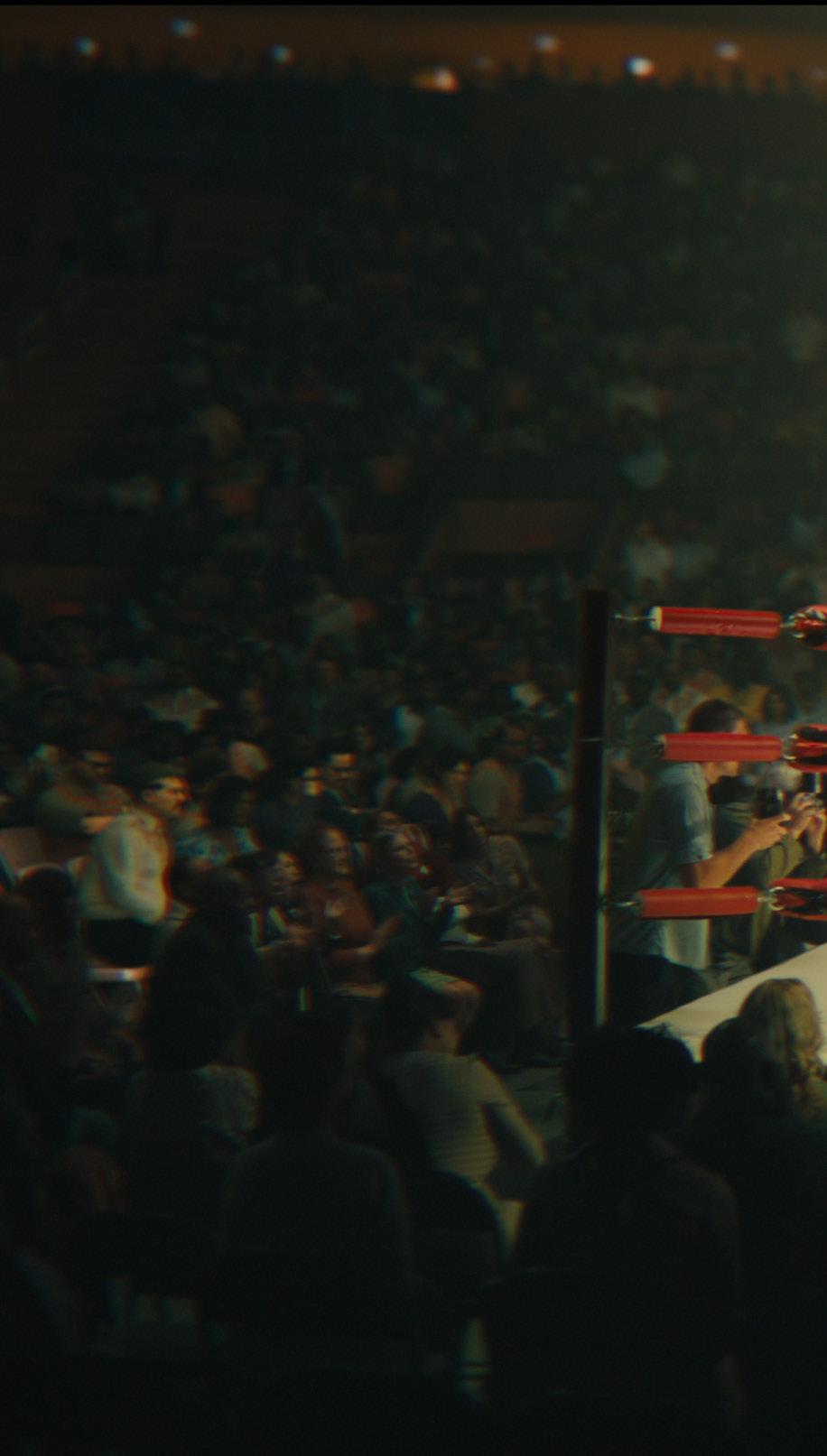
VFX Supervisor Andrew McPhillips, with Toronto-based SpinVFX, was brought in early to help with visualization. A boxing ring – surrounded by blue screen
– was built on the Second Line Stages in downtown New Orleans. The ring was bordered by a number of rows of seating, for the limited (due to COVID) number of background artists and “press.” SpinVFX then crafted not only each venue beyond those seats, but also thousands of “digidoubles” to fill out the crowd, each with appropriate looks and business for each fight.
For on-set lighting, Mcdannald replicated the single soft box over the ring with nine Creamsource SpaceX instruments, and added MAC Aura XB moving concert lights for the glitzy look seen in the later fights. Par-can trees were also built to replicate the ones seen in classic photos. Mcdannald says they worked hard to replicate specific star flares seen in some fights with Proteus Maximus instruments. McPhillips then, at the end of each block, photographed all of those flares, with every lens, to build a library of elements for use in his venue backgrounds.
The first course of action was for Tillman to decide which of Foreman’s fights to include, which he did before completing the script. After viewing the fights on YouTube, and making timecode
36 MAY 2023
THIS PAGE: A RING – SURROUNDED BY BLUE SCREEN – WAS BUILT ON THE SECOND LINE STAGES IN DOWNTOWN NEW ORLEANS WITH A FEW ROWS OF HUMAN EXTRAS (LIMITED DUE TO COVID). TORONTO-BASED SPINVFX THEN CRAFTED EACH VENUE BEYOND THE FRONT ROWS, CREATING THOUSANDS OF “DIGI-DOUBLES” TO FILL OUT THE CROWD.
OPPOSITE: MORE THAN 23 DIFFERENT LENSES WERE USED THROUGHOUT THE FILM, INCLUDING HAWK C AND V SERIES ANAMORPHICS FOR SCENES OF FOREMAN’S POVERTY-DRENCHED CHILDHOOD IN HOUSTON’S 5TH WARD.

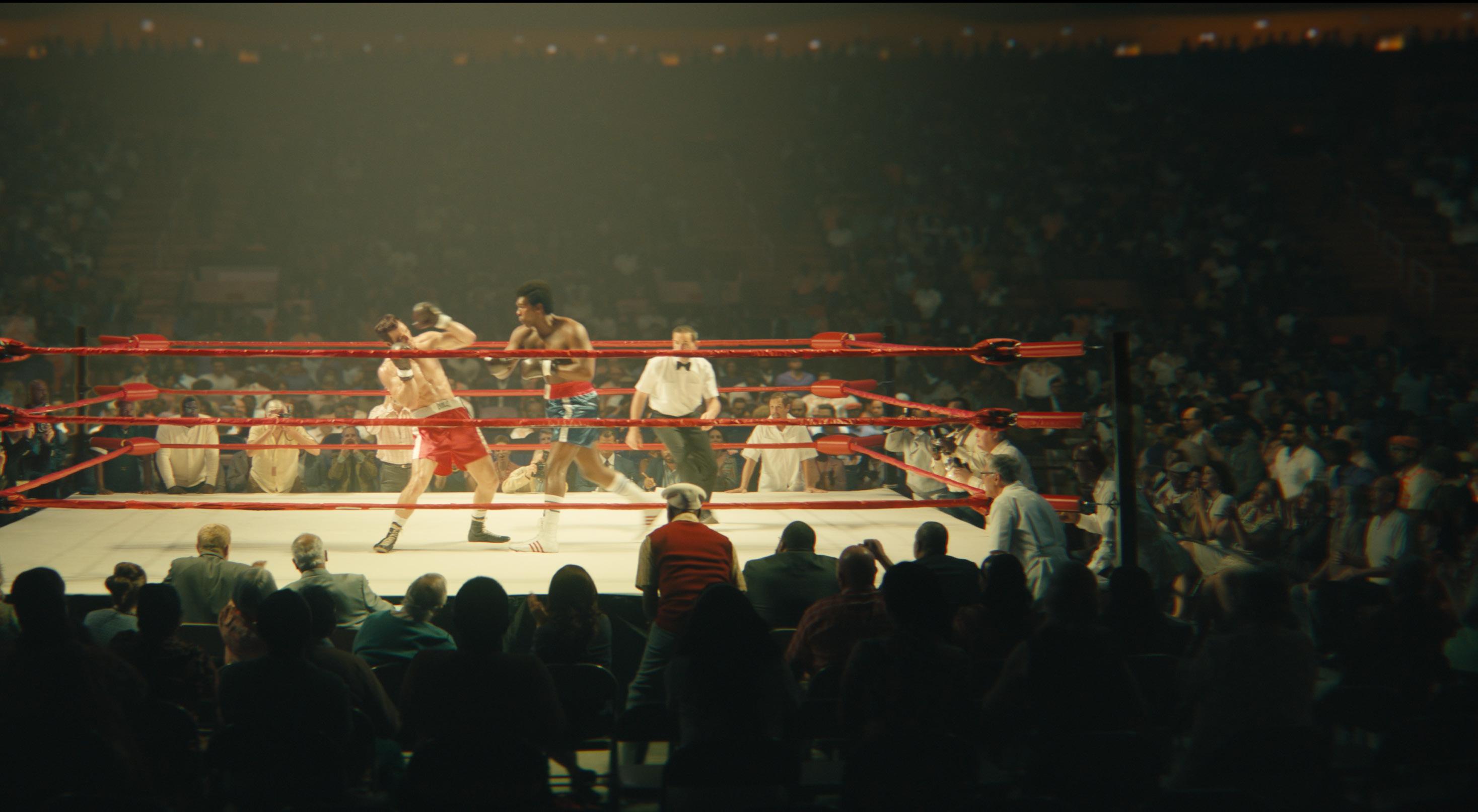
37 MAY 2023
marks for which rounds – and which sections in those rounds – were needed, he had his editor cut each down, after which he created storyboards for each fight. The storyboards reflected the pattern Tillman found in each match, giving each a specific style.

Fight choreographer Darrell Foster, who worked on Ali, spent nearly a year working with actor Khris Davis to teach him how to box those parts of those fights like Foreman. Davis was then matched with real boxers to perform each fight.
“I don’t like when you see a guy punching, and you can see him missing or they move before the punch gets there,” Tillman states. “The key was finding real boxers who can take some of the punches.” Tattersall also had no interest in seeing “Hollywood cheating – superhero punches and haymaker swings.”
Once the storyboards were completed, Tillman and the camera team mapped out coverage. The questions to be answered included, “Where would the camera be in each round and how do we devise the movement around the boxers, while they’re doing the choreography? What shots do we need for each round? What is a master; what are our closeups?” Tillman explains. Spin would then develop previsualizations for each fight based on the director’s storyboards. “We had to choreograph the fighting, almost like a dance,” McPhillips reveals. “Where they move, where the camera needed to be. And it had to be accurate to the real fight.” The previs also needed to show what would appear in future venue settings to support their shot designs. “And that included lights we wanted/needed in camera,” Matysiak reports.

A week was spent rehearsing each fight with the actors to help place cameras within the action and also to determine which camera platform to use and which lenses. “George had his storyboards,” recounts Gardner, “and he’d tell us, ‘At this point, we will be going around them,’ and ‘At this point, they will be looking straight into the lens, and the punch will come straight into the lens.’” As for picking a platform, Matysiak says, “that was just trial and error to see what would provide the feeling George was after.”
Typically, that meant Willey on his Mōvi in the ring with the actors, with Gardner just outside the ring, either handheld, on dolly, or on Steadicam, along with a C-camera operator. Willey says, “Steadicam is big and hard to keep up with the speed of the fight. With the Mōvi, I could move really fast to keep up with the fighters and give them specific angles.” Adds Storts, “Sam’s instincts are so good, he could pan around quickly and get dialed into exactly where he needed to be.”
Gardner agrees, describing Willey’s work on the Mōvi, “among the best I’ve ever seen. Sam really took the Mōvi to another level. And it’s not like there’s a predictable or consistent approach to boxing as an operator, as the movement is always varied,” Gardner adds. “The choreography can move, their bodies
38 MAY 2023
change. It’s very difficult,” especially for focus pullers. “Actors bobbing in and out is always a challenge,” shares Nguyen. “And here, we have a story that is about bobbing in and out.” Nguyen took advantage of her background in dance, memorizing the fight choreography and being ready for a punch or move she knew was coming.
During the Block 1 fights, Gardner was called on to provide the POV of a fighter receiving punches. This was accomplished with a rig that Keslow fabricated and was used on several other boxing films, including Creed III immediately before Big George Foreman , and which Matysiak had the rental house modify to fit the show’s needs. Essentially, it featured a Plexiglas shield, supported by adjustable spring sets and mounted to a vest, to absorb the energy of Davis’ punches, who aimed directly at Gardner, all without damaging the camera. [Though Davis did hit hard enough to damage one of the rig’s springs!]
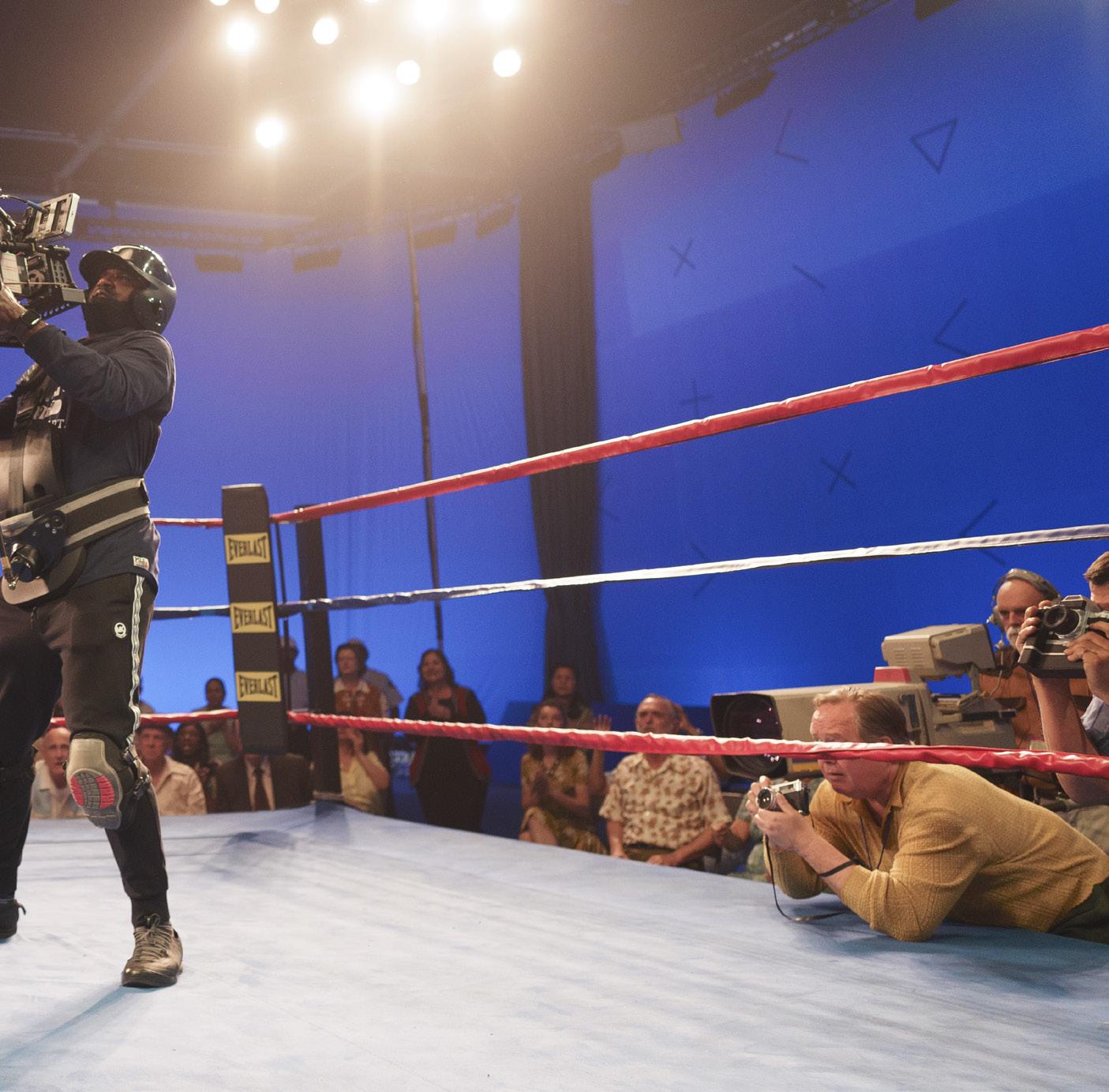

“Kirk had to do the choreography of the other boxer,” Matysiak recounts. “And that’s not just one or two punches – he was running around the ring, getting punched, ducking. It’s visceral.” Gardner was even required to “get knocked out,” showing the experience of Joe Frazier taking a damaging blow from Foreman. “The idea was to see the camera feel like it hit the ground,” Gardner states. “It was fun!”
Tattersall opted not to use the rig for his fights, instead having Davis pull his punches, and, using a 50 mm lens, come as close to the lens as possible, to appear to have struck it, with Willey emulating the physical shock.
Besides general fight coverage, “specials” had to be photographed, often at 120 fps, to show the dramatic effects of important hits, such as Ali knocking Foreman out. The process required repeated hard hits to allow for coverage, the actors sometimes hitting their scene partner – at force – 10 or 20 times.
For the knockout punch Foreman delivers to Moorer, to regain his title in 1994, Tillman says, “everybody knew that was coming. And that’s why a week of rehearsal was important. There’s no f–ing around when people are getting hit. But it worked, and worked well.”
Describing the fight that served as a reclamation of Foreman’s crown, Tattersall notes that “Moorer was like an animal, and Foreman came in very much as the underdog. But he was the favorite, because at this point in his life, he was a well-loved character. George Foreman was funny, amiable and well-liked. But he was old, for a boxer – he was 45, and going against an undefeated 26-year-old. Finally in the 10th round, this little window appeared, where Moorer’s defense dropped, and George jumped in there with a couple of quick punches. He put him on the floor, and he never got up.”
39 MAY 2023
OPERATOR KIRK GARDNER PROVIDED THE POV OF A FIGHTER RECEIVING PUNCHES VIA A RIG FABRICATED BY KESLOW CAMERA AND MODIFED BY MATYSIAK TO FIT THE SHOW’S NEEDS. IT FEATURED A PLEXIGLAS SHIELD, SUPPORTED BY ADJUSTABLE SPRING SETS AND MOUNTED TO A VEST, TO ABSORB THE ENERGY OF DAVIS’ PUNCHES, WHO AIMED DIRECTLY AT GARDNER, ALL WITHOUT DAMAGING THE CAMERA.”
FOR FOREMAN’S BAPTISM SCENE, WILLEY (BG) HELMED THE MŌVI, WITH GARDNER (FG) SHOOTING HANDHLED. GARDNER SAYS WILLEY’S WORK ON THE HANDHELD GIMBALLED RIG WAS “AMONG THE BEST I’VE EVER SEEN. HE REALLY TOOK THE MŌVI TO ANOTHER LEVEL.”

LOCAL 600 CREW
NEW ORLEANS
Director of Photography
John Matysiak Operators
Kirk Gardner, SOC
Sam Willey
1st ACs
Penelope Helmer
Geoff Storts
2nd ACs
Melanie Gates
Jack Khorram
Camera Utility
Kyah Cook
DIT
Nate Borck
Still Photographer
Alan Markfield
Publicist
Michael Umble
LOS ANGELES
Director of Photography
David Tattersall, BSC
A-Camera Operator

Kirk Gardner
A-Camera 1st AC
Yen P. Nguyen
A-Camera 2nd AC
David “Clean” Berryman
B-Camera Operator
Sam Willey
B-Camera 1st AC
James Teninty
B-Camera 2nd AC
Maria Valletta
Loaders
Keira Schmidt
Rachel “Elle” Waldon
DIT
Imanuel Smith
Still Photographer
Alan Markfield
Publicist
Michael Umble
BY KEVIN H. MARTIN PHOTOS BY NIKO TAVERNISE / AMAZON STUDIOS

BODY
Jody Lee
FRAMEGRABS COURTESY OF AMAZON STUDIOS
FEATURE 02
BODY
DOUBLE
 Lipes, ASC, and Laura M. Gonçalves probe beneath the skin for a reimagining of David Cronenberg’s horror classic Dead Ringers.
Lipes, ASC, and Laura M. Gonçalves probe beneath the skin for a reimagining of David Cronenberg’s horror classic Dead Ringers.
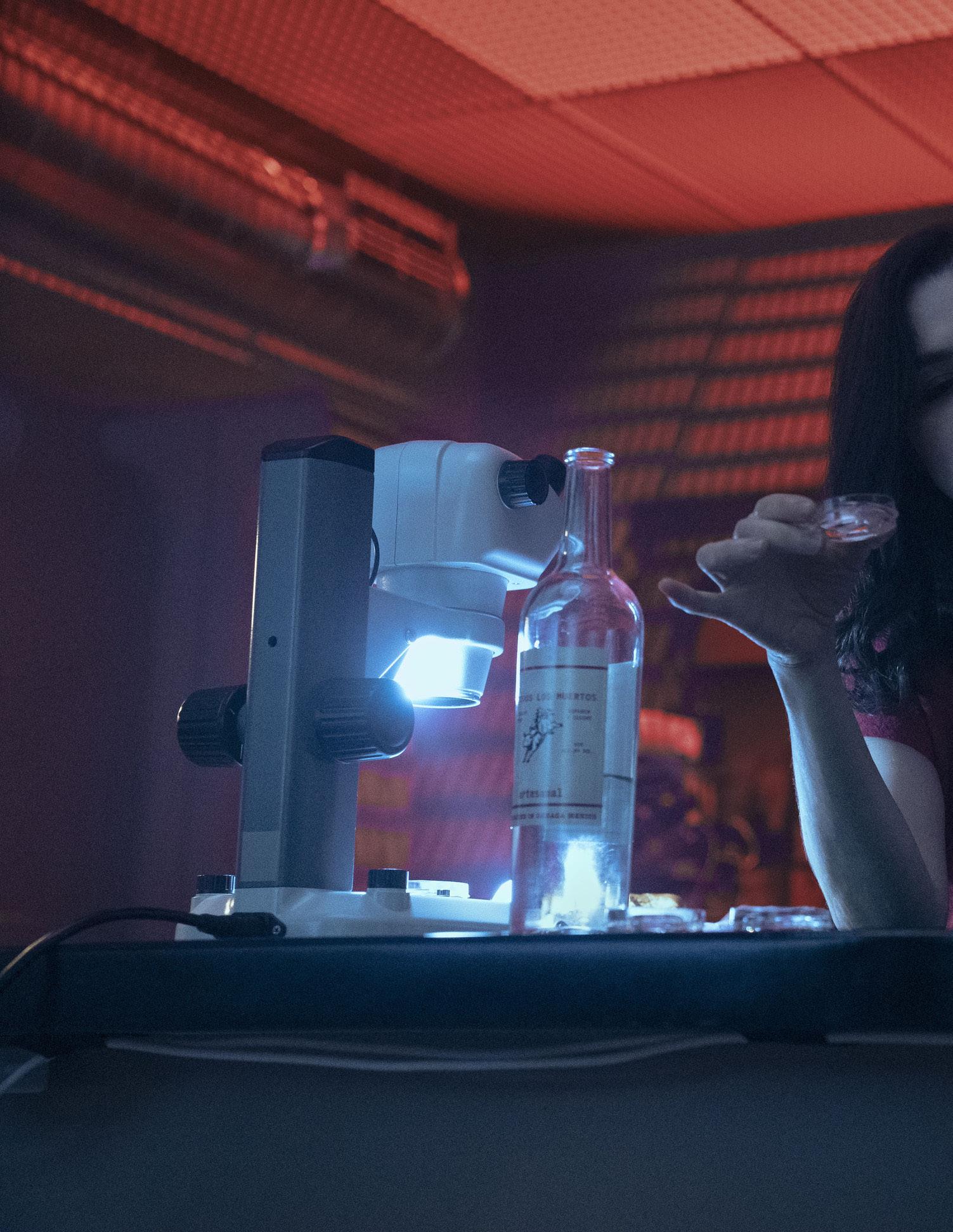
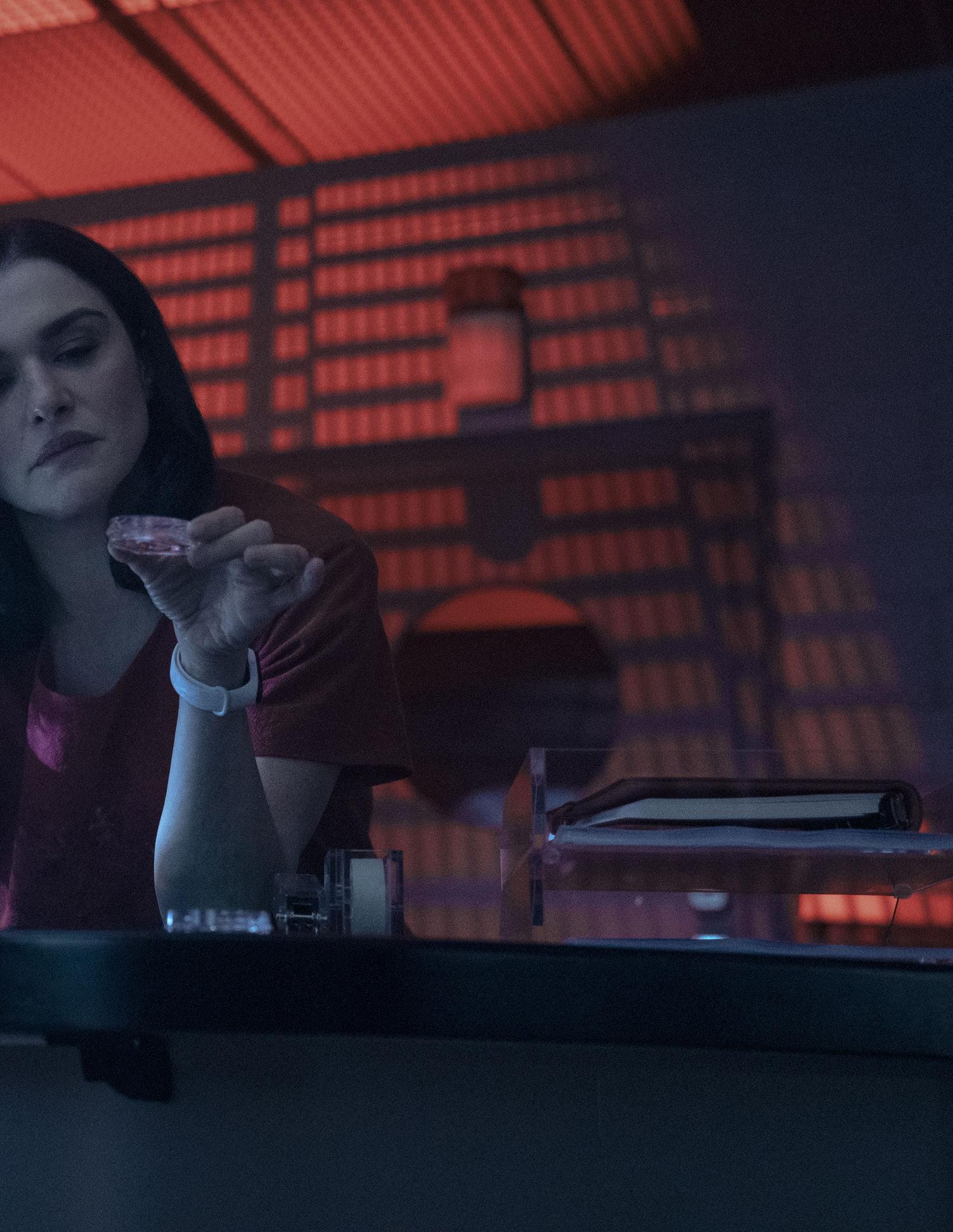
The origins of Dead Ringers date back to the strange case of Manhattan-based twin gynecologists who were found dead together in their apartment. Those events inspired the Bari Wood novel Twins, which in turn formed the basis for filmmaker David Cronenberg’s 1988 feature adaptation, starring Jeremy Irons and shot by Peter Suschitzky ASC, BSC. Amazon’s new series of the same name executes a gender flip, with twin female surgeons (played by Rachel Weisz) embarking on an even deeper and darker look at the evolving science of childbirth.
Sean Durkin was tapped to direct the first two episodes of the series, and he selected Jody Lee Lipes, ASC, as his director of photography (with Laura M. Gonçalves shooting the remaining four episodes). Lipes, who shot another drama focusing on twins, HBO’s Emmy-winning 2020 limited series I Know This Much Is True [ICG Magazine June/July 2020], says that experience wasn’t instrumental in his hiring.
“I know Sean from way back,” Lipes shares. “I shot his thesis film in college, plus his first feature as director and producer, Martha Marcy May Marlene. Sean also produced my first feature as a DP, Afterschool . Our working relationship is special, as I find Sean incredibly discerning with his visual approach and terrific with actors. Since he doesn’t come from a traditional TV background, he often prefers to tell the story with a single shot, and that’s my preference as well. The lack of coverage is unusual for television, but showrunner Alice Birch supported us as we established the look of the show.”
As noted, Episodes 3 through 6, directed by Lauren Wolkstein, Karena Evans, Karyn Kusama, and Durkin, were shot by Gonçalves, a veteran of numerous inventive and often spectacular music videos and commercials. “In my first meeting with Sean and Alice,” she recounts, “all we talked about was the tone and theme of the show. How the duality of the twins could allow us to explore a style that combined control and chaos. There was an immediate creative and personal connection and I understood how they wanted the show to evolve, visually. I was also very excited about the twinning end of things. I have used motion control a lot on previous projects; having motion control on set every day was different, but this might be one of the last shows doing twinning on such a system, so it may be historic in that way.”
Visual effects supervisor (and ICG Director of Photography) Eric Pascarelli, one of several other I Know This Much Is True veterans, says coming onto the production early helped a lot, “as we were able to help shape the approach and schedule. Based on our experience with I Know This Much Is True, we made sure they allotted enough time for us to do what was needed with the twinning. It’s more than just shooting everything twice. If you shoot five takes of the A-side, you have to select which of those takes is a keeper. Then you need to shoot corresponding takes – several, probably – for each of those selected A-sides. You can quickly get into ‘versionitis’ – where you need to do fifteen takes to get your three takes covered. Once Production understood all this, they accommodated us.”
Like the original Dead Ringers , motion control was most often employed when shooting the twinning scenes. “There are more efficient ways to shoot twinning,” admits Pascarelli. “But the main concern was not having Rachel’s performance compromised by technical matters, and to make sure she was able to see the performance she would be acting against instead of just the stand-in.” Although Pascarelli calls motion-control an obsolescent technology,

“it did permit us to visualize what the final would look like while shooting,” he adds, “and to workout eyelines and screen direction with great precision.” All of the calibrations related to mo-con work were based on SMPTE timecode. And while Pascarelli says it may be an old technology, “it is the one system that was universal and worked with everything else. Danny Salk’s video playback was keystone, with LTC timecode driving the lighting board, audio, and mo-con, usually pan, tilt, and focus.”
Lipes had shot The Good Nurse on the Sony VENICE, pushing the ISO to 6400, and he repeated that here. “There’s more noise, which I like because it prevents the digital image from looking too clean,” he reports. “And the natural light possibilities were exciting. When we lit Rachel with just one source in the room, a lone candle six feet away, there was still almost too much light, and that’s factoring in Panavision G-series lenses, which aren’t super-fast.”
With an ISO of 6400, Chief Lighting Technician Jason Velez had to take care that in-frame sources did not burn out. “We controlled every fixture on set with dimming,” he recounts, “as we would
46 MAY 2023
TOP: VFX SUPERVISOR ERIC PASCARELLI (WHO WORKED WITH DEAD RINGERS CO-DP JODY LIPES ON I KNOW THIS MUCH IS TRUE ) SAYS “THERE ARE MORE EFFICIENT WAYS TO SHOOT TWINNING [THAN MOTION CONTROL]. BUT THE MAIN CONCERN WAS NOT HAVING RACHEL’S PERFORMANCE COMPROMISED BY TECHNICAL MATTERS, AND TO MAKE SURE SHE WAS ABLE TO SEE THE PERFORMANCE SHE WOULD BE ACTING AGAINST INSTEAD OF JUST THE STAND-IN.”
BOTTOM: CO-DP LAURA M. GONÇALVES SAYS SHE FOUND THE BIRTHING SCENES THRILLING TO SHOOT. “I’M A FAN OF DOING EFFECTS IN-CAMERA,” SHE STATES. “WE WERE ALWAYS TRYING TO VISUALLY LEVEL UP THE WORK THESE BRILLIANT DOCTORS WERE DOING WITH WOMEN’S BODIES, AND SHOOT IT IN A WAY THAT’S NEVER BEEN SEEN BEFORE.”
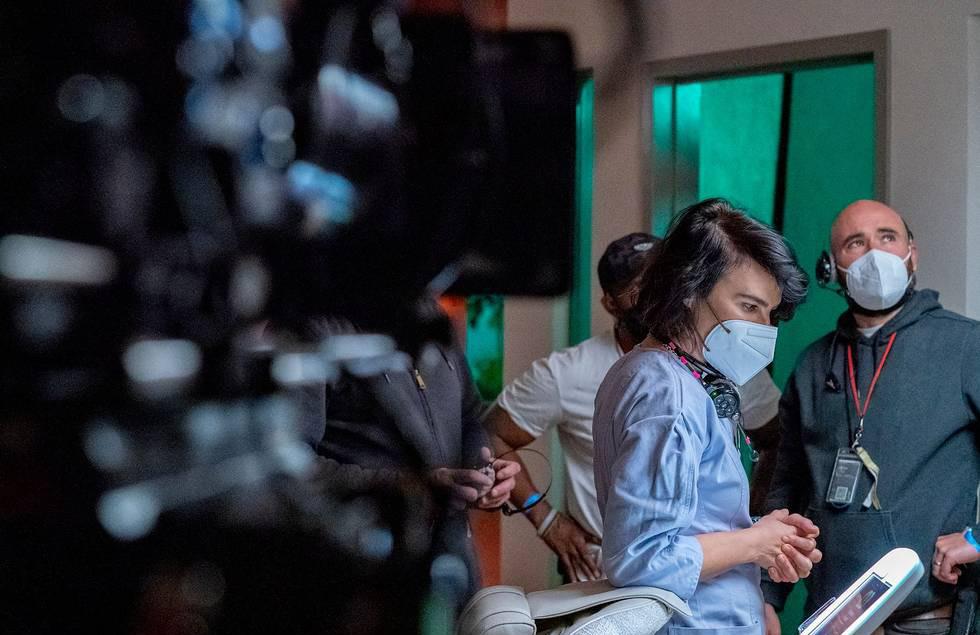
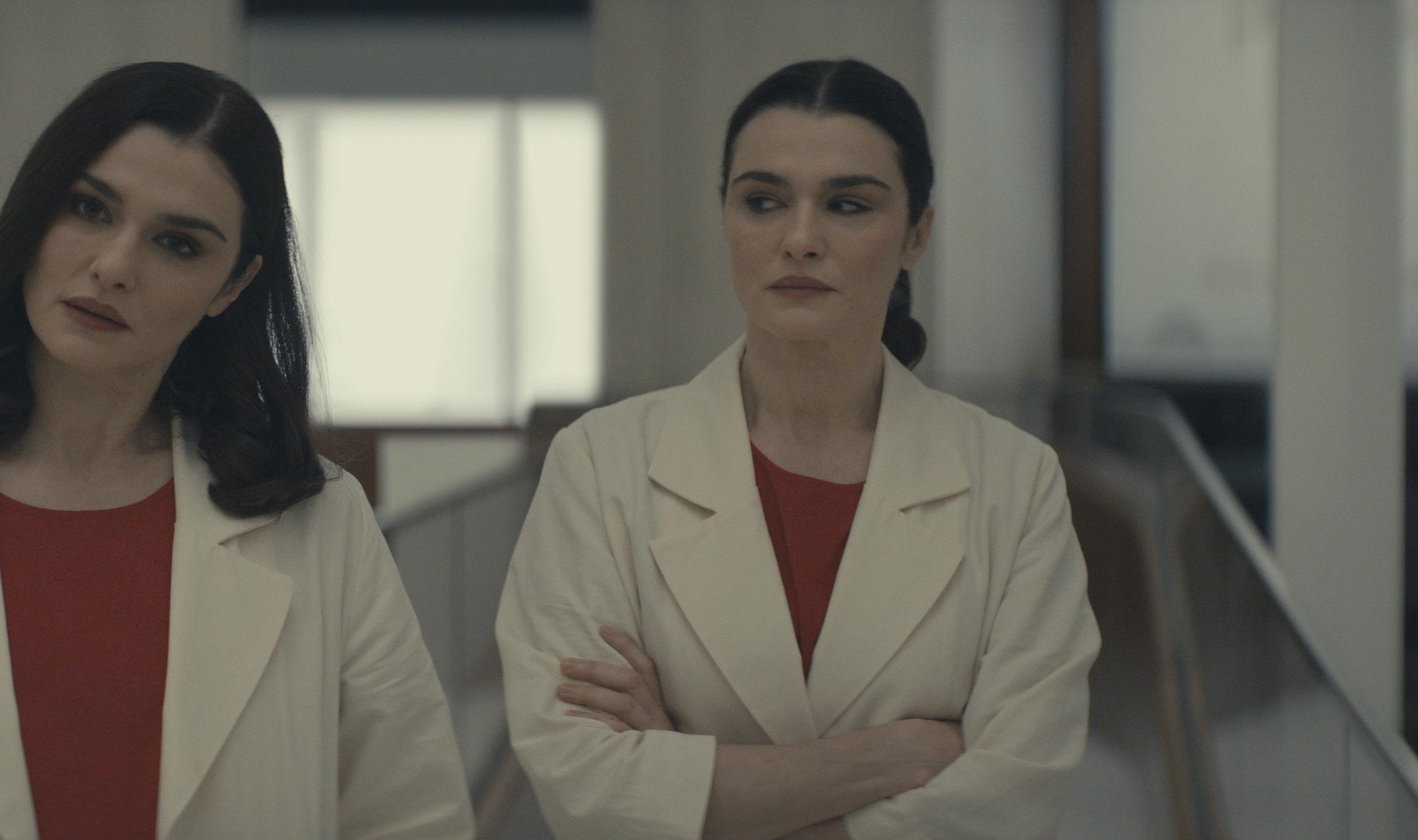
47 MAY 2023
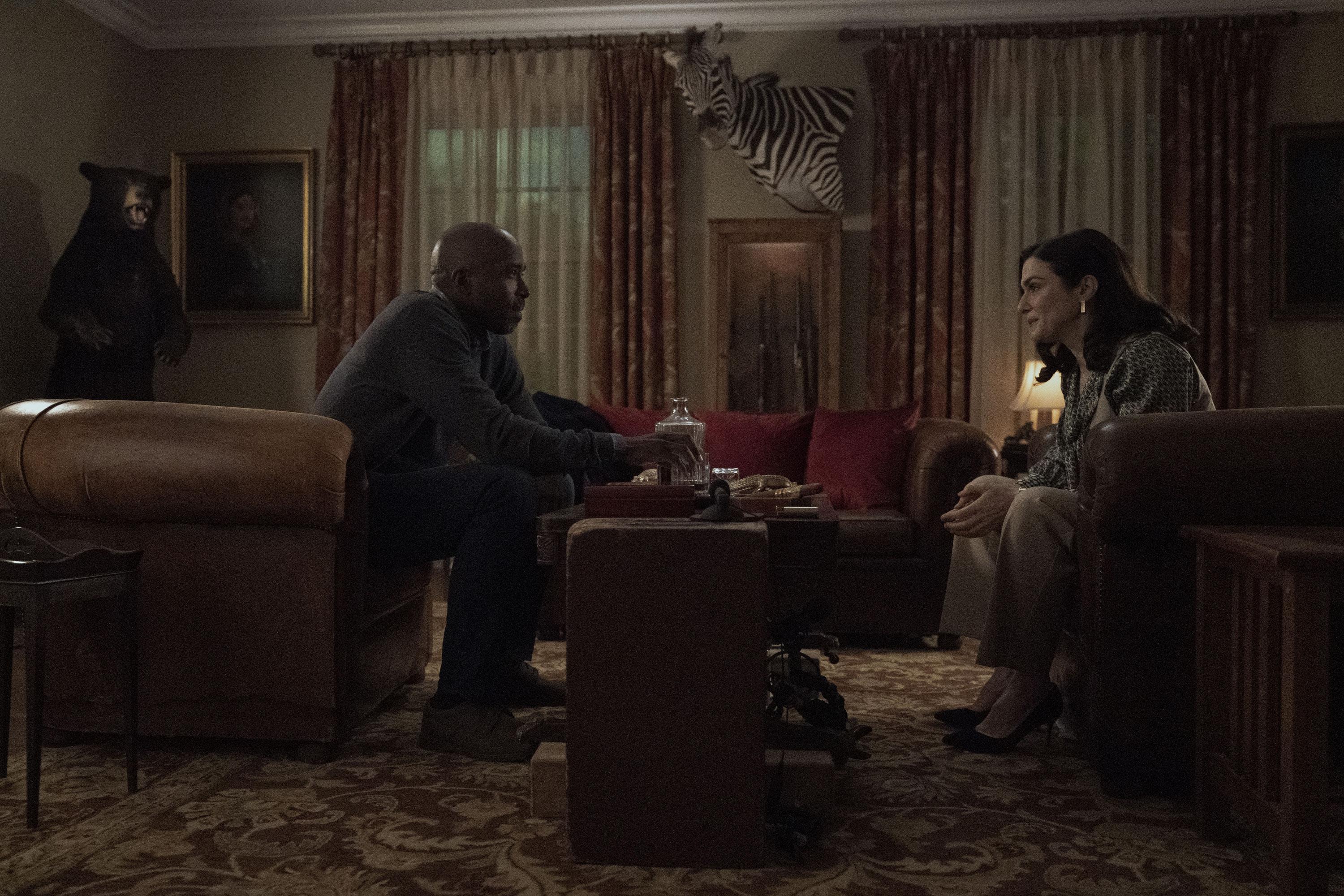
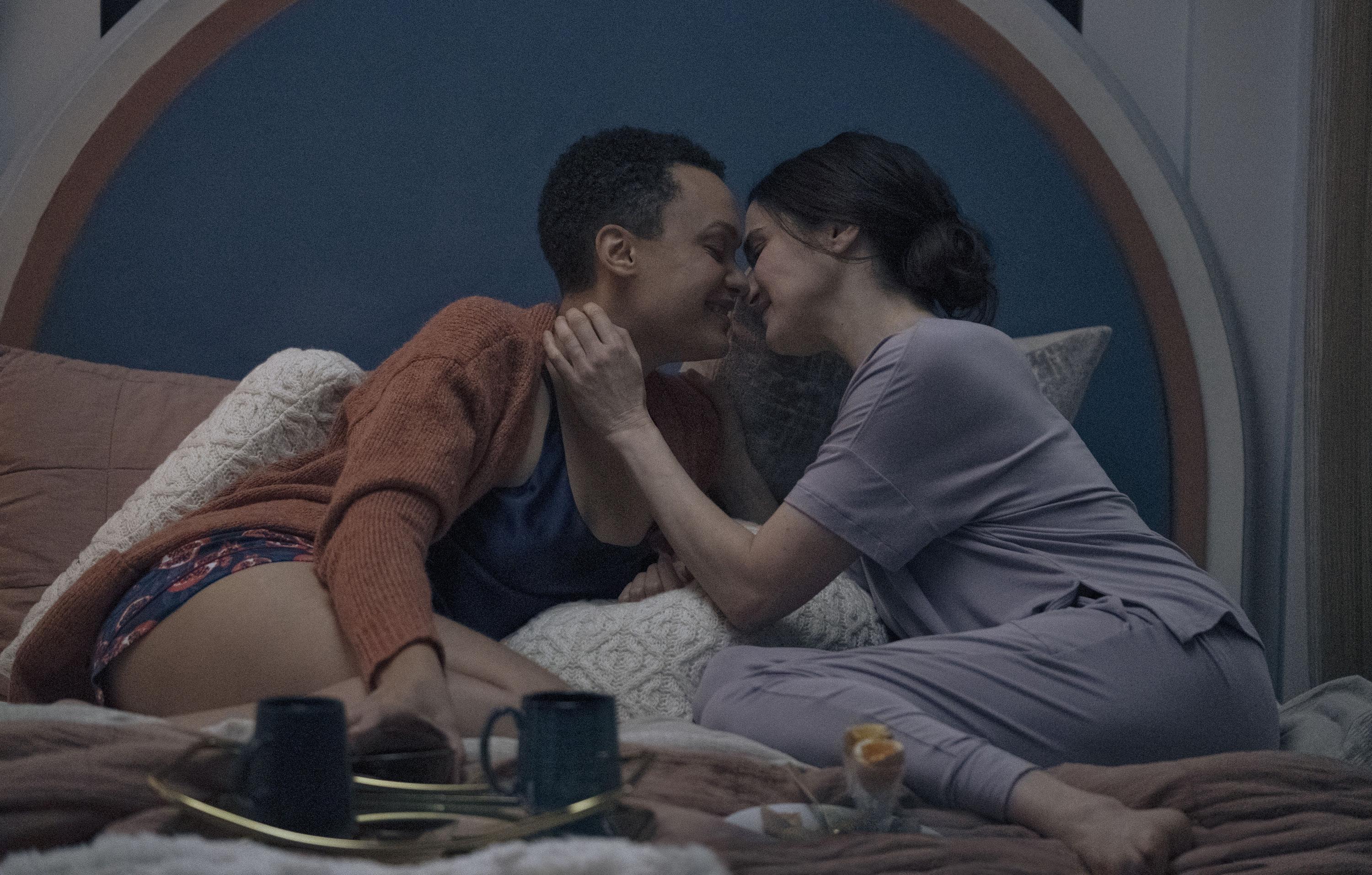
TOP/BOTTOM: CHIEF LIGHTING TECHNICIAN JASON VELEZ SAYS HIS TEAM CONTROLLED EVERY FIXTURE ON SET WITH DIMMING, “AS WE WOULD USUALLY BE IN THE LED WORLD TO CONTROL THE COLOR. SET DECORATION WOULD THROW THINGS TOGETHER AND WE WOULD TEST PRACTICALS EARLY TO SEE WHEN IT WOULD BE NECESSARY TO DOCTOR SOMETHING UP, WHICH MIGHT MEAN TEARING INTO A FLUORESCENT FIXTURE OR FAKING IT WITH LED TAPE.”
usually be in the LED world to control the color. Set decoration would throw things together and we would test practicals early to see when it would be necessary to doctor something up, which might mean tearing into a fluorescent fixture or faking it with LED tape. Fixtures would be operating down at five or six percent, plus there were multiple layers of Magic Cloth for diffusion. Fortunately, we were blessed with an excellent producer in Erica Kay who understood our needs and did everything she could to aid us while keeping within the budget.”
Velez often used medium-base LED Astera NYX bulbs that fit household fixtures. “That let us create a variety of looks, including the warmth of old-school incandescents,” he continues. “Anything modern, we would find ways to put diodes in to make it ours so we could work on set. We also did soft ceilings throughout, built from framework and stretched muslin that we could light through when appropriate but also painted to look opaque. I used DMG Lumiere Maxi Mix panels made by Rosco above the muslin. We could add cutters in the form of black Coroplast to take down any spill coming through the muslin ceilings to keep it off the walls. The soft ceiling had a bit of coolness that read 4300 Kelvin, while we’d be at 3200 degrees on the camera.”
Once Velez’s team had practicals set up, window light coming in, and soft ambiance from the ceiling, “it was a matter of figuring out how to shape the heavily diffused light reaching our actors,” he adds, “and how to take it away to give the frame the right shape. We’d begin with maybe just a Lumiere with strap-bag diffusion using Magic Cloth. If the space dictated it, the grips would provide a 4-by-4 of additional Magic Cloth. Then there might be a third layer in an 8-by-8 frame. And sometimes, beyond that, really close to Rachel, there would be another layer of Magic in 4-by-4. Each time you drop that in, you cut roughly a stop-and-a-half of light. And each of these also serves to warm up the light from the fixture by maybe 100 degrees. So, we’d have to dial the fixture down to compensate. I’d subtract all those 100-degree increments out to
offset the color shift.”
Lipes worked with Light Iron colorist Sam Daley to develop a LUT that was used throughout his two episodes. “The way Jody shoots, his look is baked in,” Daley explains. “Historically, cinematographers who shot film exposed the negative in a deliberate manner so their look could be printed with only minimal adjustments by a color timer. Jody takes the same approach, albeit with a digital file. The prevalent black levels – the soft blacks and the compressed shadow detail – aren’t anything I’m creating in the DI; that’s all a matter of exposure and lighting and the original LUT.”
DIT Anthony Hechanova used Pomfort Livegrade on set to color the image and for capture/playback on Sony A-250 monitors. “I used a combination of LUT boxes from Flanders as well as TVLogic’s IS-mini,” he shares. “Pomfort’s SilverStack software let me manage the media. I always integrate SilverStack into my workflow for its robust features. And if there is a fault in the download and the power is cut off, you can plug back in and pick up right where you left off. Since we shot such large files, that was an important consideration.”
Durkins’ preference for limited coverage was evidenced in Episode 1 during an eightpage dialogue scene between the sisters and potential investors in their proposed birthing center. “That scene featured five actors, but we covered the whole thing in just two shots,” Lipes notes. “Sean’s decisiveness about that approach obviated the need for traditional coverage while also keeping us from having a long day. We used the shorter zoom lens for shots of the sisters, with a subtle zoom. Sean always knew he wanted to avoid going in too close. So, when we did do coverage, we stayed a bit wider on close-ups and medium shots. As a result, you often get pieces of other people in the frame along with the subject – like they’re infringing on the frame, and there’s a subtle but deliberate awkwardness.”
Lipes says the Guild camera team, who are all his longtime collaborators, were “totally on
49 MAY 2023
board” with the different approaches and liked being challenged as much as the DP. “A-Camera Operator Sam Ellison and I have done a lot of movies together and he makes our work better,” Lipes shares. “He always has an incredible relationship with directors and actors. First AC Zach Rubin, who is an amazing focus puller, had since gone to operating. B-Camera Operator Rebecca Rajadnya was the First AC on The Good Nurse and moved up for this series.”
Rajadnya says that “if B-Camera didn’t have an assignment, I’d check with Jody or Laura to see if I should go shot-hunting. There were often scenes when I could find a fun or useful angle to complement the preplanned A-camera shots. I truly felt supported by Jody and Laura to trust my eye and my instincts, especially with this being my first job as a full-time operator.
“I appreciated the commitment to quality over quantity,” she adds. “We would generally leapfrog setups when possible, with B-camera going off to line-up shots ahead of time so that they would be ready to rehearse once A-camera was finished with their work. B-camera would also break off to pick off establishing shots at new locations and to shoot practical SFX-heavy inserts that we wouldn’t otherwise have had time to accomplish as a full company.”
Sam Ellison, SOC, found that twinning while shooting digitally “allowed us to build our base of knowledge with long takes in motion control and expand our practice to include more moving shots and ‘risky’ repeatable lighting elements. As a general rule, I try to forget about whatever technical apparatus I’m using and just immerse myself in how the frame should move in space. For me, the challenge was to tune out all the noise while operating clunky motion-control machinery without losing sight of how a shot naturally wanted to unfold. Our best work came when we were all in this like mindset.”
All the mo-con shoots, whether using the Pacific Motion Control system or shooting on TechnoDolly, were done by operators turning wheels without any preprogrammed moves. The PMC system used the venerable Kuper system, which still employs floppy disks but proved
fully reliable, and Aerohead remotes were often employed. The bulk of the motion-control work was overseen by veteran ICG motion control operator Don Canfield.
One of the most ambitious twinning shots occurs early in the series as the sisters walk to work one morning. “It is supposed to feel like early morning, before any direct sun,” explains Lipes. “So, it’s just ambient light in the scene. How do you do both the A and B sides of a master shot [with each piece having Weisz play a different character in the same set-up] at this time of day when A and B are shot four or five hours apart? We had to anticipate how the light on the avenue would change, in terms of direct sun bouncing from hundreds of windows down the street. Key Grip Johnny Erbes-Chan prevented any direct light from hitting that side of the street for hours. It was challenging, but we were used to this kind of planning after doing I Know This Much is True together.”
Near the end of the lengthy take, one sister takes the glasses from the other and gives them to a homeless woman. To manage the timing of this hand-off across the frame, audio cues were employed. “The director could either speak to Rachel via earwig or, on occasion, we could cue her with beeps so her second performance would sync up with her first,” Pascarelli recounts. “In other scenes, we also laid down SMPTE code to record sound and were able to edit that in a way that facilitated performance. Matt McLarty handled both sound recording and ProTools, editing all of Kitty’s lines out so Rachel, when acting the B-side, only heard herself from the A-side, with open spaces for her to speak. We also had to sync up any TV screen in the shot, because any light from that screen falling on the talent had to match. We could have tracked in the B-side, but that would have meant not being able to check the match, which we accomplished during review with a moving split.”
A stylistic go-to evolved with the color red serving as an indicator the camera would be probing one sister’s psyche. “Sean and I didn’t
TOP/BOTTOM: PUSHING THE SONY VENICE’S ISO TO 6400 ALLOWED FOR “EXICTING” NATURAL LIGHT POSSIBILITIES, ACCORDING TO LIPES. “WHEN WE LIT RACHEL WITH JUST ONE SOURCE IN THE ROOM, A LONE CANDLE SIX FEET AWAY, THERE WAS STILL ALMOST TOO MUCH LIGHT, AND THAT’S FACTORING IN PANAVISION G-SERIES LENSES, WHICH AREN’T SUPER-FAST.”
50 MAY 2023
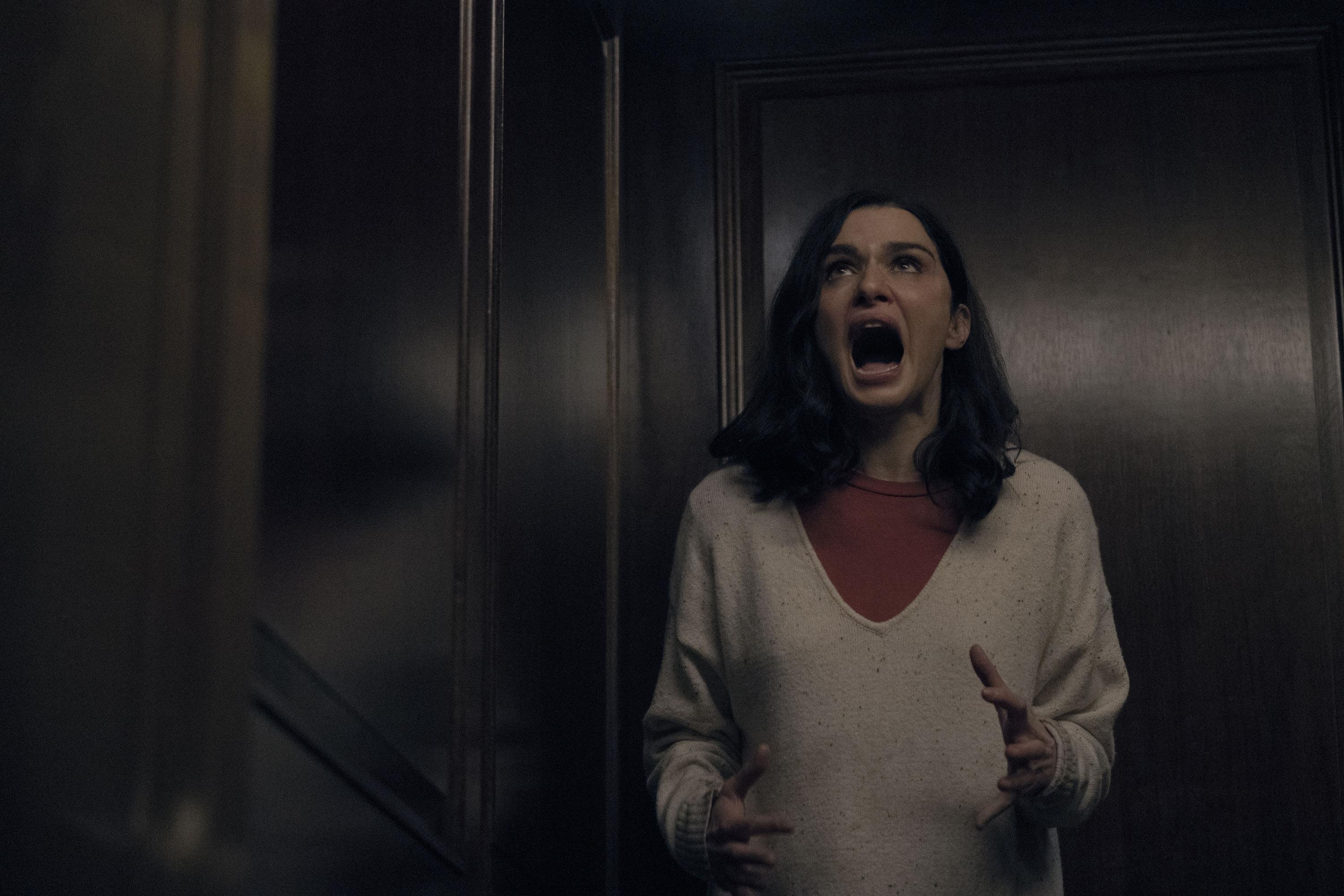

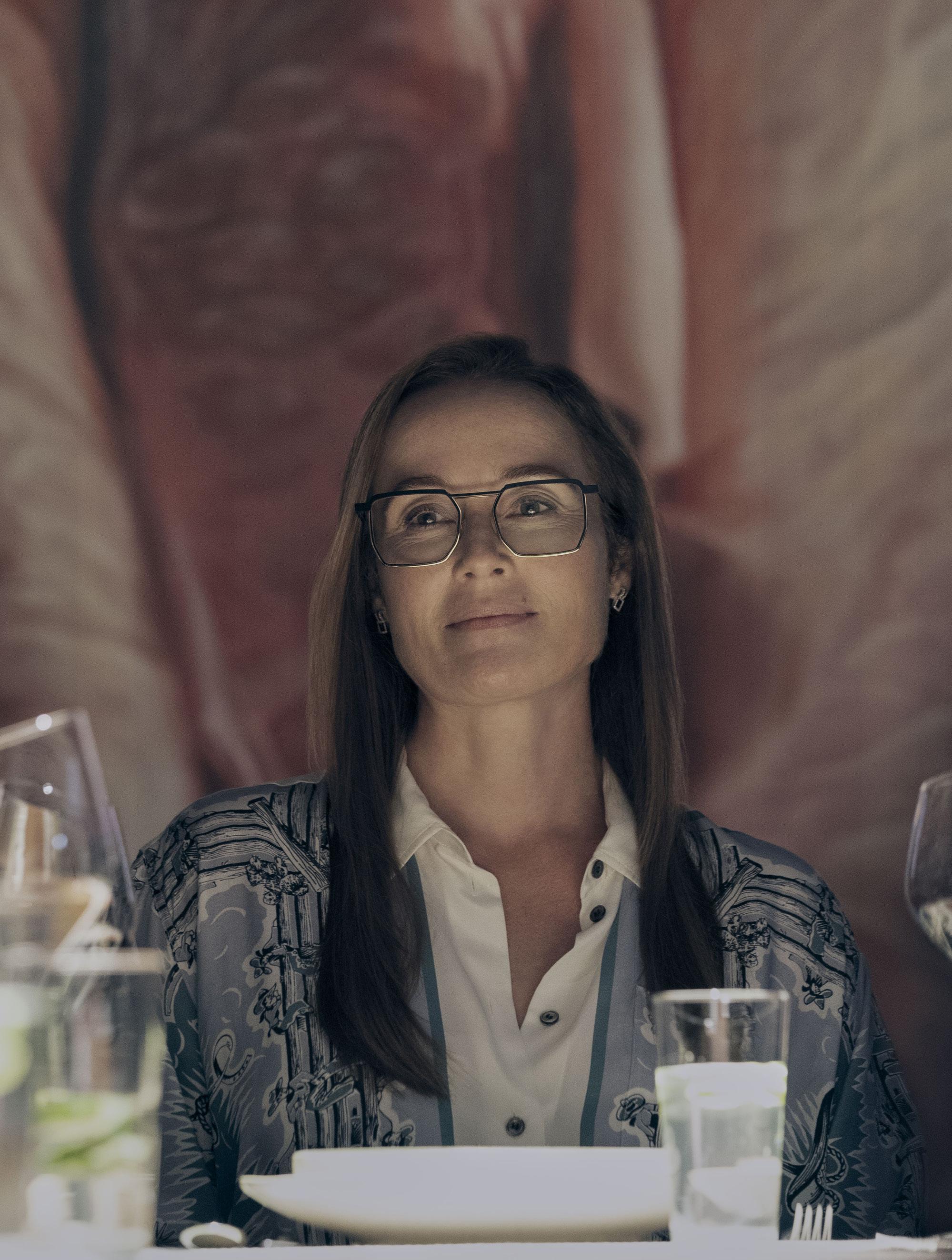
have any rules about using the red lighting or some of the lighting cues that made their way into the show,” Lipes recalls. “But when Rachel crawled along her kitchen counter, this character shift seemed to call out for a way to emphasize a change in how the audience sees her.”
Justin Foster, who succeeded Sam Ellison as A-Camera Operator, drew this shot on his first day. “We did it as a super-low angle beneath Elliot as she crawls across the kitchen counter, grabbing food with her hands and stuffing her face,” Foster remembers. “There’s a skylight in the kitchen with soft light pushing through, but then a red light fades in. I found that Jody and Sean planned simple, well-choreographed camera moves that worked with the blocking in an elegant way. They’d use pan and tilt along with the zoom, and these nodal moves harked back to ‘American Paranoia’ cinema, where you’d have very slow zooms incorporated into a pan. These shots would often end by revealing one sister in a way that pointed up the moment, sometimes reflected in a mirror.”
With the extremely high ISO on the VENICE, Rajadnya’s principal concern was one of watchfulness. “The main issue as an operator with the 6400 ISO setting was that we were often getting shadows and light reflections in frame that couldn’t be detected with our naked eye,” she describes. “Trying to track down the culprit for a boom shadow, or even worse, trying to explain to a boom operator that even though we couldn’t see the shadow, the camera could, would sometimes become a point of hilarious joint confusion.”
Rajadnya was bumped up to A-camera for one day on Episode 2, which saw her executing a sustained handheld oner as Beverly charges into an angry confrontation. “The shot started in a very small enclosure with a door that just barely grazed over Rachel Weisz’s and my heads,” she recalls. “Unfortunately, I couldn’t use an Easyrig or even do a traditional shouldering of the camera, so I ended up using a Cinesaddle, sort of swaddling the camera on my hip like a baby. This was one of the only times I was glad for my short height while operating!”
While motion control accounted for most of the twinning shots, one key scene required a full face replacement with Weisz’s visage put over her stand-in. “There was this huge and lengthy move in the atrium of the birthing center,” recounts Foster. “The characters are seen coming over this curving catwalk and then down some stairs. It was planned as a dynamic TechnoDolly move, starting with them high up and then coming around to pick them up as they descend. We knew from the start of rehearsal that there was no way Rachel was ever going to be able to match the exact pace of her stand-in over the duration of this shot, so they chose to go the face-replacement route.”
Pascarelli saw the shot as an ideal way of exploring deep-fake technology. “You see all these uses of deep fake, so why not use it for the twinning?” he asks. “People do some pretty impressive work, even when they’re just taking bad YouTube videos as their origin. I thought, ‘What if we shoot the character in high-res, then feed that in?’ Ariel Altman from Fuse set up a nine-camera array looking at both Rachel and her stand-in, Kitty, over a 120-degree arc. We recorded each reading their lines, plus Rachel doing some generic phoneme stuff. While it took a long time for the computer to process the imagery, the result let us map Rachel’s face over Kitty’s.”
The scene was in one of the first episodes Gonçalves shot. She says, “it was great to collaborate with Jody, to be there early in the process and test with him and see how dark we could go, and how much we could diffuse the light. It was always beautiful to light Rachel that way, we never had to use filters on her.”
Hechanova, impressed by how Lipes’ attention to detail combined with Pascarelli’s VFX know-how, found Gonçalves’ commitment to perfection equally welcome. “When I saw Laura operate a particular handheld shot very late in the show, it was a genuine revelation,” he declares. “I saw her brilliance, but also realized it was different from what had been done earlier in the show, and it was only then that it became clear to me she had been holding back to mesh
53 MAY 2023
LEFT: B-CAMERA OPERATOR REBECCA RAJADNYA SAYS SHE FELT “TRULY SUPPORTED BY JODY AND LAURA TO TRUST MY EYE AND MY INSTINCTS, ESPECIALLY WITH THIS BEING MY FIRST JOB AS A FULL-TIME OPERATOR.”
with what Jody had done.”
“There are very few handheld shots in the series,” Gonçalves shares. “But in Episode 5, Beverly’s relationship with Genevieve becomes serious, and there is an intimate scene where they are talking while lying in bed. I sat between the actors while they spoke all the dialogue directly to the lens, and I had the lights dim when the final line was delivered. It was all spontaneous. My director [Lauren Wolkstein] loved it, and that was the only coverage we did for the scene. It was so simple and really beautiful. This happened on a Friday after a long week, and shooting this way allowed me to send a lot of the crew home.”
The hospital where the twins worked was represented by a variety of practical locations and sets. “Many of our sets for operating rooms and corridors were lined with soffit lighting, which fit with the old-school impression of traditional older hospitals,” Velez reports. “If we were in the real thing, there would be fluorescents within a 2- or 3-inch soffit going straight down through an egg crate; but we lined the whole place with 120 Titan tubes. For walk-and-talks we would play with cues and intensities, bringing the light levels down as the characters came forward. So, they functioned first as off-camera light sources, then just as accents in the frame that didn’t distract from the performances.”
One lab set was shot at JFK’s TWA terminal. As Foster recalls: “That room already featured our ‘red’ aesthetic and had all these lamb fetuses, which were controlled live on set by special effects. Other scenes featuring human fetuses were more take-intensive because getting the movements believable for human behavior required a lot of finesse to get it fully dialed in. Other time-consuming shoots included the various surgeries, which involved a lot of cutting and bleeding effects that required retakes over how much blood got pumped out,
and sometimes the synthetic skin would need replacing after a take.”
Gonçalves says she found the birthing shoots to be thrilling. “I’m a fan of doing effects incamera,” she states. “We were always trying to visually level up the work these brilliant doctors were doing with women’s bodies, and shoot it in a way that’s never been seen before.”


Velez says that Gonçalves’ energy, and her willingness to experiment, encompassed production design as well as lighting and camera placement. “It might be, ‘Hey, why don’t we try mixing it up with an old-school incandescent or a very large tungsten unit right here?’” Velez recounts. “With Laura’s episodes, the project moved into a different realm, owing to a lot more color, especially in the Mantle birthing center. That was Wardrobe’s big ode to the feature film, with these strange red medical smocks, and we pushed that red with our lighting. In the old days, we would put up a big Fresnel and go through Rosco swatch books to come up with the perfect two or three hues. But now with LED, we didn’t have to use any gels and could still create a perfect red for the Mantle center. Then it was Laura’s responsibility to make sure the finished product had that same value in the reds.”
Light Iron’s Daley worked with Gonçalves to adjust the LUT for her episodes. “These red costumes didn’t appear in Jody’s episodes,” he shares. So, Gonçalves tested the red during her prep with Daley, who adds that “the modifications we made ensured that the red costumes had the necessary punch and rendered the way Laura wanted them.” Much of Daley’s DI work was smoothing for continuity. “Jody expects a very light touch in the DI,” the colorist adds, “so my adjustments are minimal – just occasional windowing to shape light or bring elements out.
“Even with the twinning in the walkand-talk at the atrium,” he continues, “I was mainly trying to make sure it looked natural and consistent across both sides of the frame.
54 MAY 2023
Overall, I did some typical dodging and burning that happens on regular shows, and that was possible only because when it comes to VFX, Eric delivers elements that are broadcast-ready.” After Lipes and Gonçalves worked with Daley to grade an SDR version that was approved by QC, the colorist turned his attention to the HDR iteration. “Jody and Laura didn’t want to reinvent the look of the show,” Daley adds. “So, I found a recipe to represent the SDR version faithfully within the HDR container.”
Lipes, who says he was very pleased with the results, still notes concern over how compressed post schedules can impact the final product, especially in episodic television.
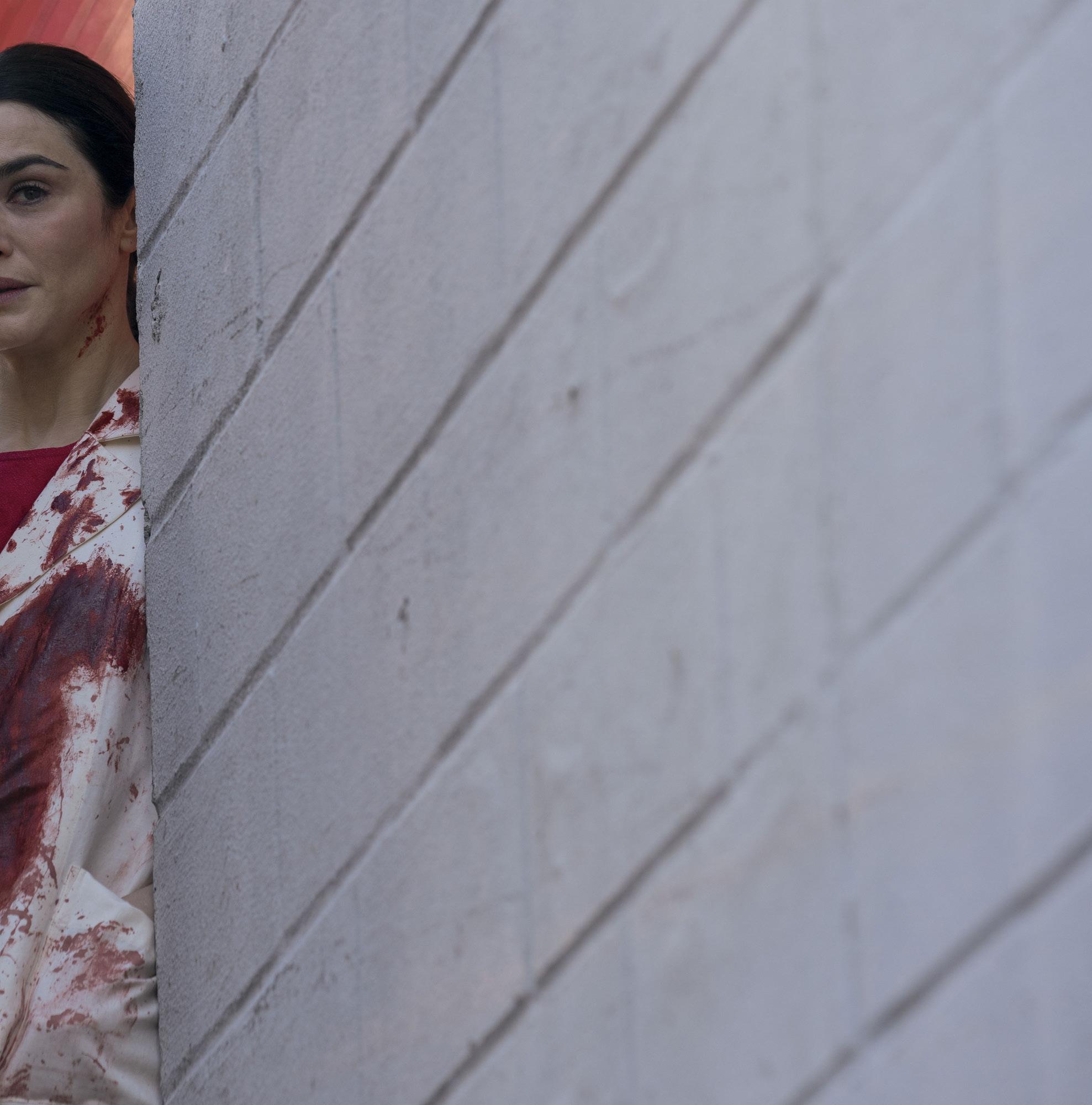

“It just feels so strange at times in the TV world,” he declares. “While production was ultimately very accommodating, the traditional assumption seems to be that everything can be done super-fast – like one full episode per day; while with a feature film, you’d have a week or more to do that much screen time. You want to wait to at least see the VFX before everything gets locked down, but schedules get so compressed it can be ridiculous. Sad to say, we all are having to fight to get the necessary time.”
Gonçalves agrees with Lipes and goes on to describe Dead Ringers as one of the hardest and most gratifying projects she’s done. “Because I was shooting back-to-back episodes, there wasn’t any time to prep with my incoming directors, so we worked non-stop to stay on top of everything,” she concludes. “We tried to push boundaries of female pleasure and horror, and to tell a story of complicated, flawed and undeniably interesting women from which you can’t look away. My hope is that people can watch the show in complete fascination with the characters and their world without thinking about the techniques. Achieving that is a real testament to the dedication and talent of the people involved. It’s something I’m proud of and I grew a lot as an artist and cinematographer.”
55 MAY 2023
OPERATOR SAM ELLISON, SOC, SAYS THAT SHOOTING DIGITALLY FOR THE TWINNING SCENES “ALLOWED US TO BUILD OUR BASE OF KNOWLEDGE WITH LONG TAKES IN MOTION CONTROL AND EXPAND OUR PRACTICE TO INCLUDE MORE MOVING SHOTS AND ‘RISKY’ REPEATABLE LIGHTING ELEMENTS.”

LOCAL 600 CREW
Directors of Photography
Jody Lee Lipes
(Episodes 101, 102, 103)
Laura M. Goncalves (Episodes 104, 105, 106, 107)
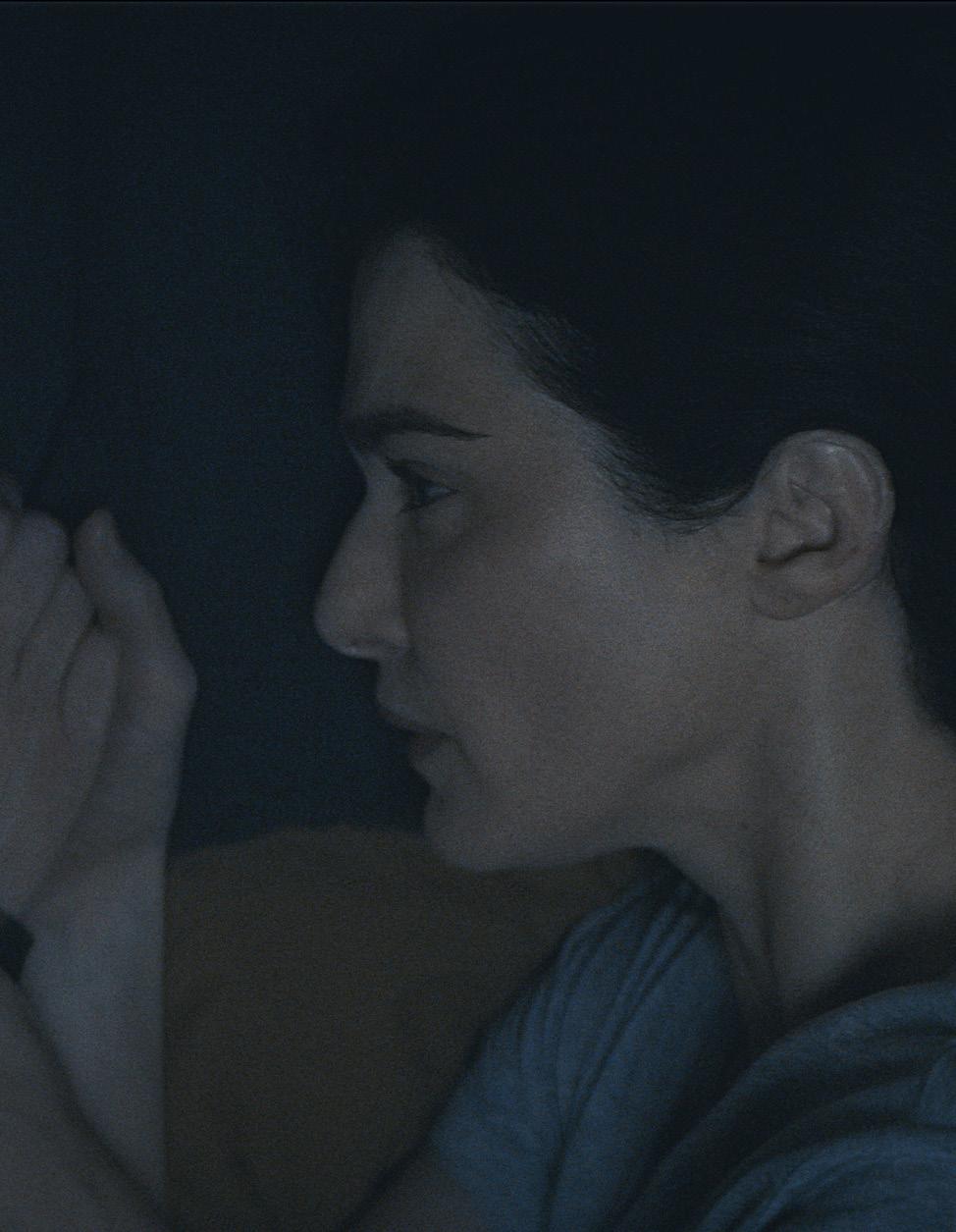
2nd Unit Director of Photography
Greta Zozula
A-Camera Operators
Sam Ellison
(Episodes 101, 102, 103)
Justin Foster (Episodes 104, 105, 106, 107)
A-Camera 1st AC
Zach Rubin
A-Camera 2nd AC
Neicy McFadden
B-Camera Operator
Rebecca Rajadnya
B-Camera 1st AC
Filipp Penson
B-Camera 2nd AC
Sancheev Ravichandran
Loader
Mike Pomorski
DIT
Anthony Hechanova
Still Photographer
Niko Tavernise
A
 A new Apple TV+ series unites two longtime Guild cinematographers (and two regional locations) for the screen adaptation of Laura Dave’s best-selling novel.
A new Apple TV+ series unites two longtime Guild cinematographers (and two regional locations) for the screen adaptation of Laura Dave’s best-selling novel.
IN
FOG
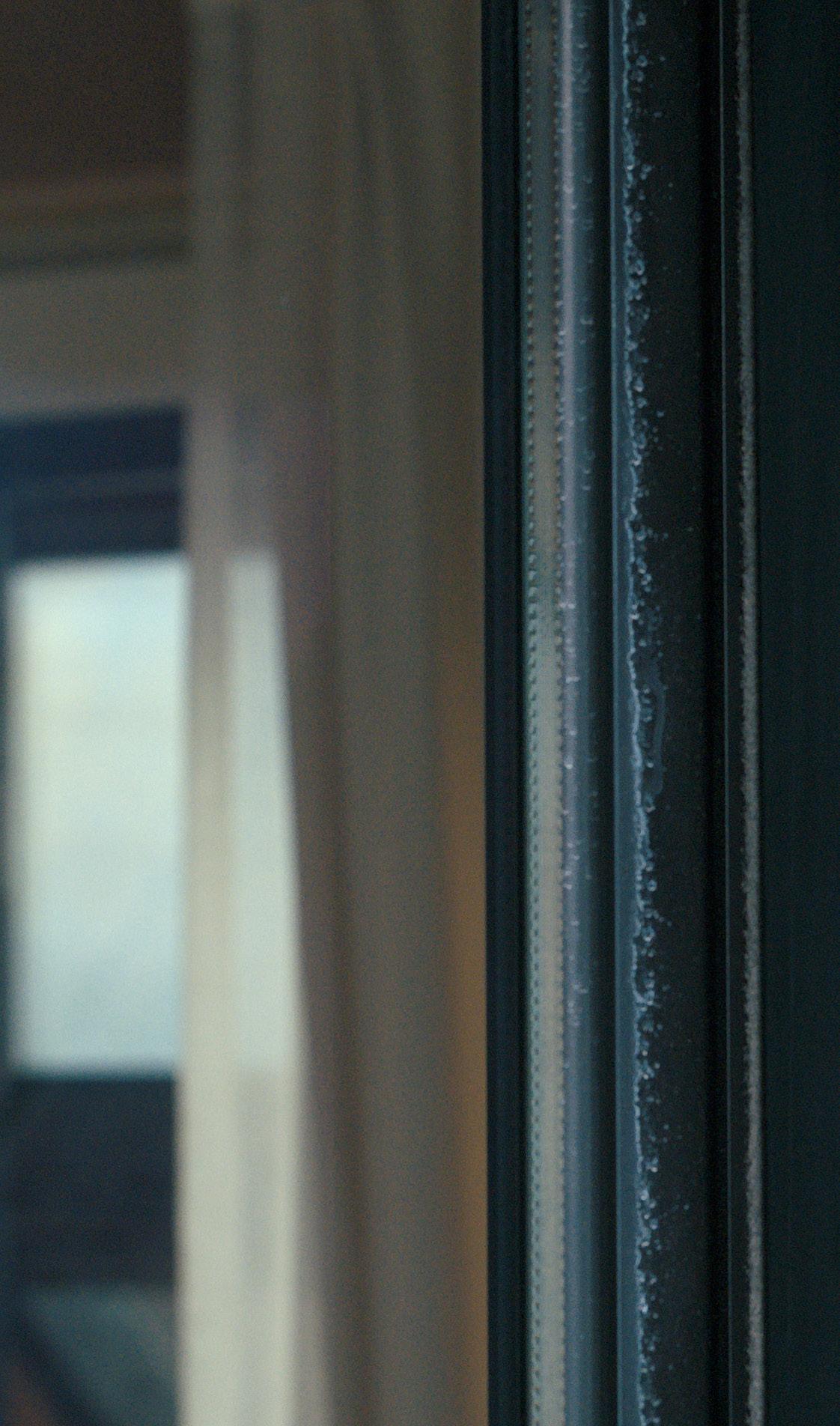 BY TED ELRICK PHOTOS BY ERIN SIMKIN / APPLE TV+ FRAMEGRABS COURTESY OF APPLE TV+
BY TED ELRICK PHOTOS BY ERIN SIMKIN / APPLE TV+ FRAMEGRABS COURTESY OF APPLE TV+
FEATURE 03

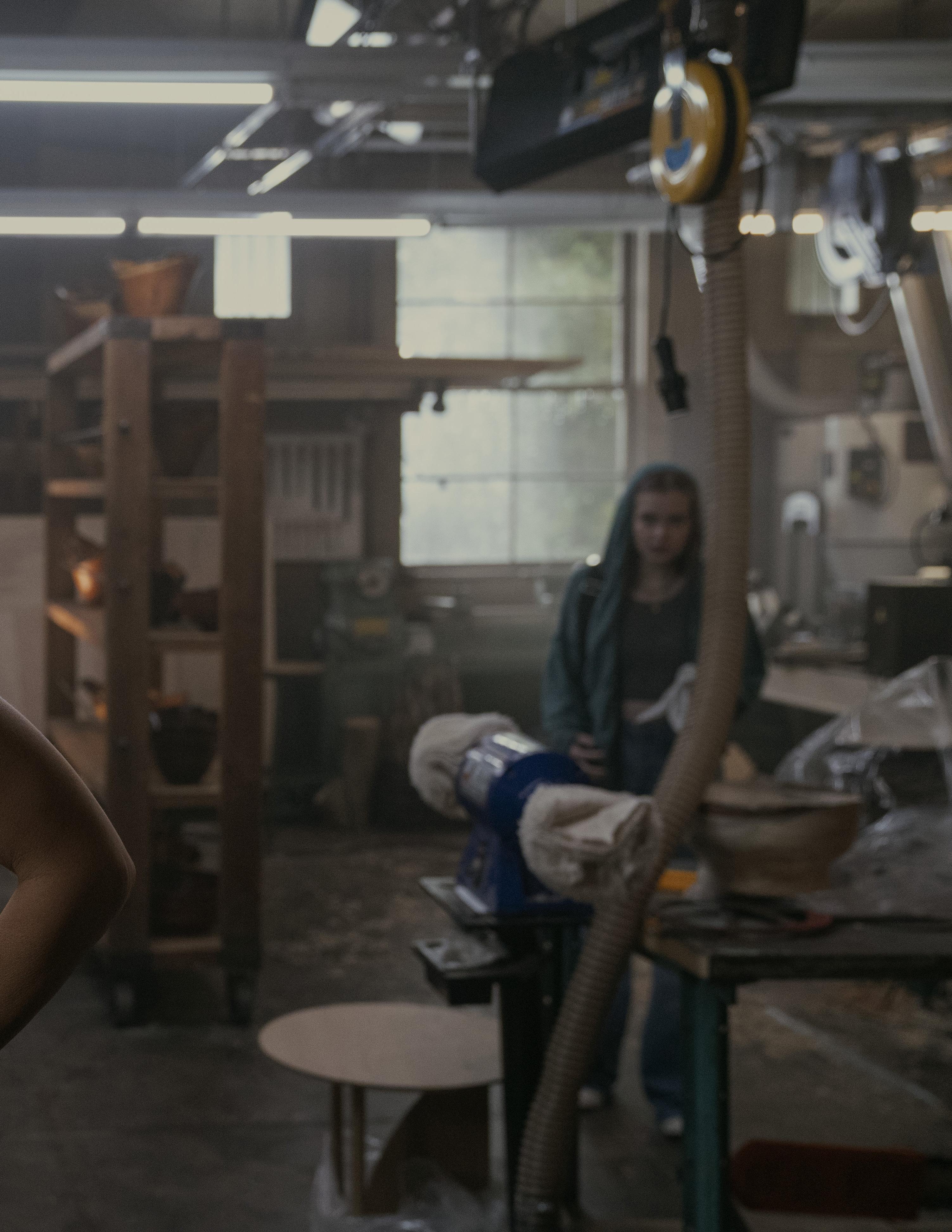
Based on novelist Laura Dave’s 2021 New York Times best-seller, The Last Thing He Told Me recently debuted as a seven-episode limited series for Apple TV+. The show unites two dynamic Local 600 cinematographers – Michael “McD” McDonough, ASC, BSC (Winter’s Bone, Fear the Walking Dead, Bosch), and Daryn Okada, ASC (Mean Girls, Just Like Heaven, Castle, Station 19), who used a variety of glass to instantly telegraph the story’s two main locations –Sausalito, CA, for the present and Austin, TX for the past.

62 MAY 2023
Photo by Jessica Brooks
Hannah’s (Jennifer Garner’s) life is upended when the mysterious past of her husband Owen Michaels (Nikolaj Coster-Waldau) rears forward, creating an emotional tsunami that destroys the couple’s idyllic houseboat existence just north of San Francisco. Events are set in motion when Owen suddenly disappears, and FBI agents swarm the Silicon Valley tech firm where Owen was a coder. His only communication to Hannah before leaving is a cryptic note that reads: “Protect Her,” referring to his teenage daughter, Bailey (Angourie Rice), from his previous marriage. Bailey does not remember her mother, who died when she was very young.
Soon enough, Hannah and Bailey team up to piece together a mystery that leads them to Owen’s past in Austin. The DP’s began coordinating the visual look in preproduction, with, as McD says, “Daryn shooting the Austin episodes and me shooting Sausalito, both on location and at the houseboat interior set on the FOX lot. We also did some pickups for each other. I knew Daryn by reputation, of course. But getting to work with him was a joy – so easy.” McD shot episodes 1, 2, 5, and 7, while Okada handled episodes 3, 4, and 6. They worked with four different directors: Olivia Newman for three episodes and Deniz Gamze Ergüven, Lila Neugebauer, and Daisy von Scherler Mayer for one episode each. McD worked extensively with Producing Director Livi Newman to set the initial look.
“Livi had just come off of posting Where The Crawdads Sing at Sony and was keenly aware of the look differentiation we required between the present-day Sausalito scenes and the Austin flashbacks,” McD continues. “Together, we must have tested a dozen different lenses at Keslow Camera

before deciding on the Canon K35’s for the flashback scenes. The Canon’s had the kinds of imperfections and organic elements that were very different from the Signatures Primes we ended up using for the present-day scenes. I picked the Signatures, which is a lens Roger Deakins helped create, because they had such a beautiful look.”
Pankaj Bajpai, Senior Colorist for Technicolor L.A., describes the lens choices as both interesting and subtle. “The Canons have a different response than the other lenses,” the veteran finishing artist observes. “That was a clever choice, and it was described throughout the post process as a ‘buttery Chardonnay’ look. It was important that in the color grade, that optical quality and texture was honestly maintained. It was fun to imagine the visuals in the way they would look if they were indeed ‘buttery Chardonnay!”
Adds DIT Sam McConville: “We supplemented with some Canon FD’s because there wasn’t a full Canon package available. We used a lot of filtration in that as well. McD also came up with the idea of using nets on the lenses. Many of them were rear netted, but some of them were front netted, which [1st AC] Jamie Felz built. Jamie’s a master of netting lenses. If you ever want to know how to net a lens, she can net a lens in minutes.”
Felz laughs when hearing McConville’s praise, adding that “it’s difficult these days to find the proper material. A lot of the stockings are now poly, so they’re shiny and reflect more light in more scattered ways. In the old days, it was wool and silk, which is more of a softer, diffused look. I think it was the mid-2000s and Woolford had a wool blend that wasn’t so bad, but those are hard to find.”
63 MAY 2023
Nonetheless, McD did find the wool blend, and Felz located an embroidery frame that’s a little bigger than a 4 by 5 frame. “You stretch the stocking over the embroidery frame,” she continues, “and you lay it over a metal frame that’s like a filter frame but without the holder on top. McD and I had some metal filter frames we had made on another show. You lay the stocking in the frame stretched, much like framing a canvas for a painting, and you glue it on the metal frame. I was using decoupage glue. You wait for it to dry, then a second coat, then you cut it free, trim it and it’s ready to go. We’d keep those in our additional filter case.”
Okada says the scope of the series was large, “but it wasn’t as if we had the time of a feature,” he notes. “It was a truly collaborative experience with Michael. When we were going through the scripts, story-wise, the second block led into introducing Austin and the flashbacks, whereas the first block was Sausalito. We knew where we were going to go with the look for everything and the colors we were playing with, so there were no surprises.”
The huge multi-level set of the Sausalito houseboat interior, where Hannah, Owen, and Bailey live, was shot on Stage 15 on the FOX lot in L.A. The houseboat exterior in Sausalito had windows running at 45-degree angles, which offered options for the filmmakers. Production Designer Christopher Brown says, “the houseboat is a wonderful piece of nautical architecture with exposed beams, so it wasn’t a mystery how it needed to go together, but we knew we weren’t going to be married to the real location in Sausalito [when building the stage interiors]. You do owe some cues and allegiances to the outside, so that when you come inside, it doesn’t feel like a cheat when you enter a room.
“Yes, there is a kitchen to the right as you enter,” Brown adds. “But it’s a different kitchen. Yes, there are sliding doors at the rear leading to a deck, but the spaces you travel through in between are different spaces. We knew we needed to tell the story that [co-creator] Laura Dave, [co-creator/
showrunner] Josh Singer and [director] Olivia Newman wanted to tell, which was that the inside of the houseboat felt like a magical place of warmth, calm and safety for Hannah. That’s where we kick everything off, and the story goes sideways from there.”


The team discussed using LED wall technology to have interactive exterior backgrounds for the actors and camera but was unable to find a company that could deliver them on the production timeline, so they opted for blue screens. “We had a traditional day/night softdrop printed for the view out the rear of the houseboat toward the East side of the bay from Sausalito,” Brown continues. “But we knew that anything out the front door was going to have to match for architecture and distance matching when we went to Sausalito for the scenes on the dock; so that became a blue screen venture. For the scenes out on the deck, the consensus was nobody wants to have actors twenty feet from a still backing that doesn’t have any motion to it. So, there was a lot of blue screen there with cropping-in of plates that got shot over the course of a couple of different times.”
McD notes that “Josh [Singer] was deeply conscious of adding to the mood of Sausalito with second unit establishing footage. Knowing [B-Camera Operator/2nd Unit DP] Matt Valentine for some 20 years, all the way back to our DP/operator days in Reality TV where you’re always looking out for ‘wow’ moments in the landscape; and knowing how good Matt’s eye is from all the climbing and biking adventures he posts on Instagram, I asked him specifically to get some amazing moodsetters of the Bay area. And he did, exactly as Josh had imagined.”
In Austin, the production shot at the UT Texas Longhorns stadium, as well as on the Congress Avenue Bridge, where one of Austin’s most spectacular sights occurs – millions of bats flying out from underneath the bridge at sunset. “We thought we’d have to augment that with CG,” Okada recalls. “But Michael actually got a lot of them.”
Adds McD: “We had to go in handheld with a minimal footprint as it was a very sensitive location, and shot kind of doc-style to get the footage.”
64 MAY 2023
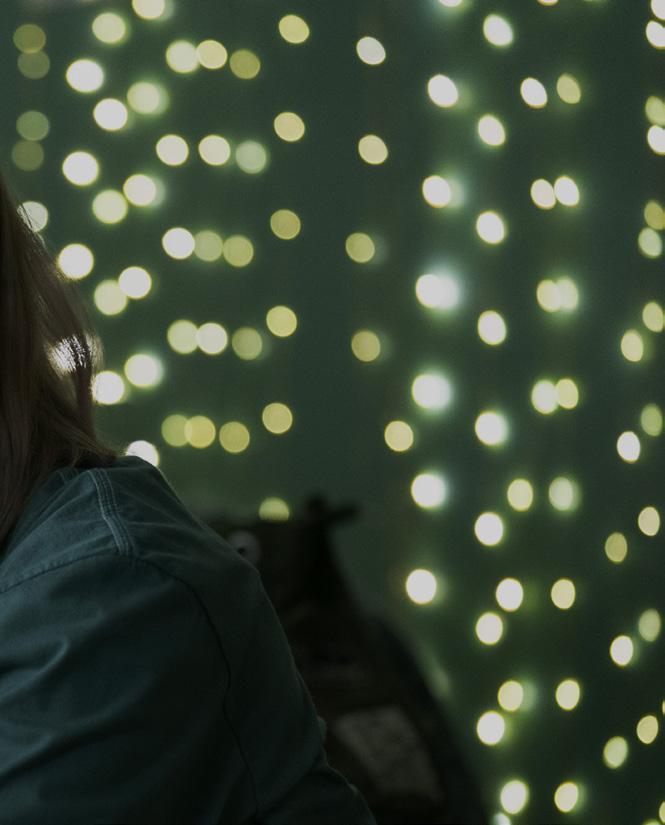


65 MAY 2023
LEFT/RIGHT: CO-DP MICHAEL “MCD” MCDONNOUGH DESCRIBES THE SAUSALITO BOAK DOCK LOCATION AS THE MOST DIFFICULT HE’S EVER ENCOUNTERED. “THERE WERE MULTIPLE NIGHT SCENES, AND WE HAD TO BE CAREFUL ABOUT THE WEIGHT RATINGS ON THE DOCKS, [ENLISTING] AN ENGINEER TO CHECK IT OUT.”
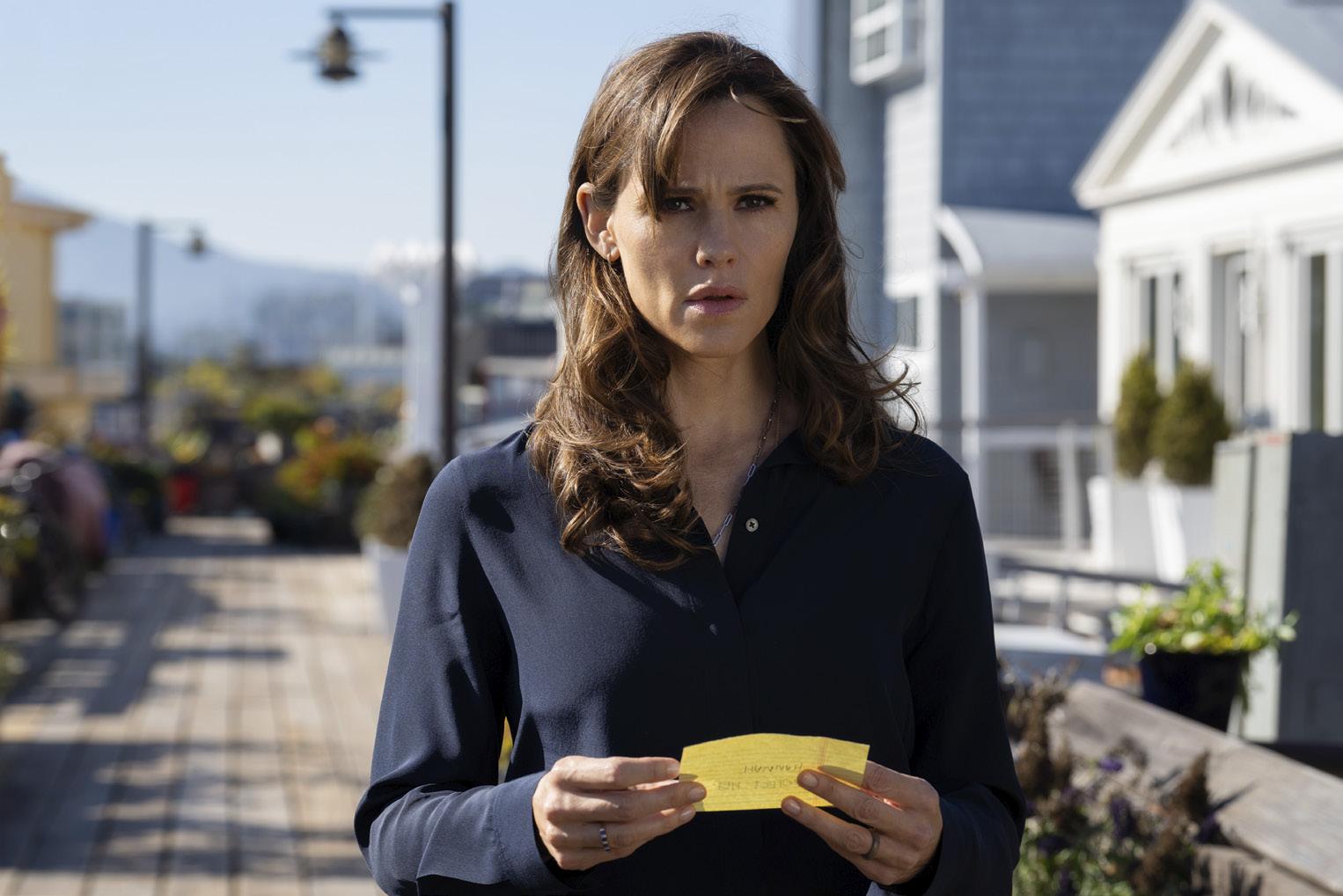

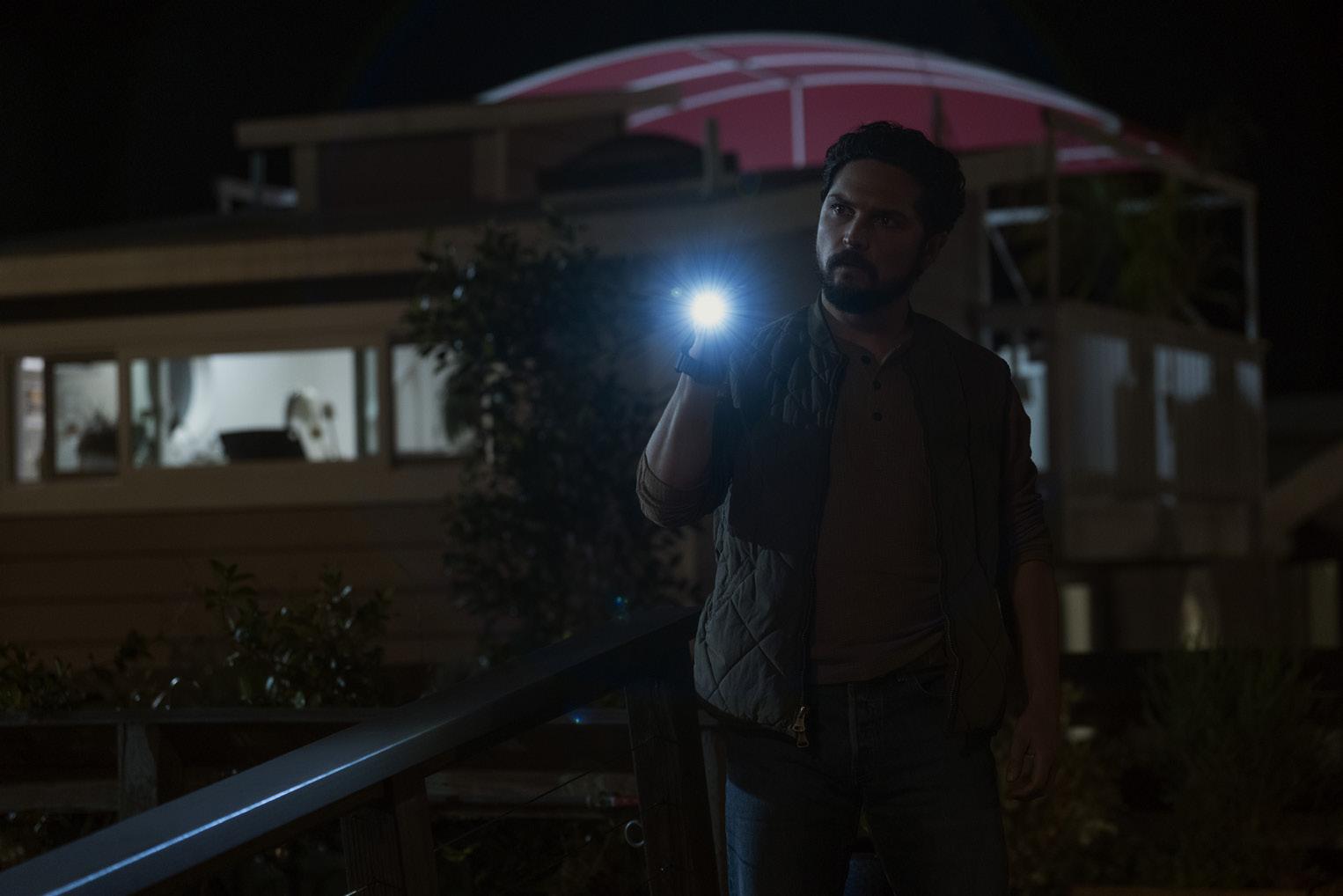 Photos by Saeed Adyani
Photos by Saeed Adyani
A-Camera Operator Kenny Brown notes that because the actors were doing a lot of running in Austin, they resorted to a number of options to keep the camera moving, aside from using a Technocrane. “I carry a rickshaw all the time,” Brown offers. “We talked about using the Grip Trix [ATV camera cars] and other moving rigs, but ended up with a bicycle riding on the sidewalks with the Ronin hanging off the back or the front. I would have a roving stand with the monitor controls on it, and I would be tucked into a doorway with somebody riding around on the pavement most of the time.”
Brown adds that, “one of our bicycle riders in Austin was a Motocross stunt rider, so we ended up with him being our pilot on the bike, which was great. Originally we had grips riding the bike, which was fine until we got into the smaller sidewalks, and reverse camera looks. That’s when it was great having a real stunt guy driving.”
Okada, who had shot Ghosts of Girlfriends Past with Garner in Boston, remembers the test day for the series, “as I kind of stayed in the dark off the stage and surprised Jennifer. We had seen each other at events but hadn’t worked together in some ten years. She was just the same. We were freezing on [Ghosts] in Boston, and she’s such a trooper. It was great working with her
again as she’s so great to photograph.”

Producer Merri Howard, whom Okada had also worked with, brought him on when the production was scouting locations for the first block. “That was great because I got to see everything they were going to do,” Okada adds. “And depending on the director, we tried to work off the scout as to planning the key camera moves. I was tracking what Michael was doing in the first block, so we had a coherency on how the camera was going to be moving from episode to episode. Sometimes we would end up shooting in the same locations and just keep the balance going. We based so many of our decisions on what was happening emotionally in the story. That was our guide, photographically.”
The longtime Local 600 member says one thing he aims for in cinematography is truthfulness. “We’re telling a story as far as how we move the camera and the use of light in various scenes,” Okada shares. “And I find when you are serving the story, the inspiration for the right shot is clear. Watch any movie of Conrad Hall’s, and every one of his shots is telling you – psychologically – what’s happening in the story. That’s why they all work so well. Being creative in the shot-making or lighting, or taking risks, comes out of your read of the characters. If you try to force in a style
that doesn’t apply to what’s happening emotionally in the story, then I find you’re at a loss for what you want to do.”
Once the team moved to Sausalito to shoot the boat dock exteriors, things got especially challenging. McD describes the location as the most difficult he’s ever encountered. “There were multiple night scenes, and we had to be careful about the weight ratings on the docks,” he recounts. “We had an engineer check it out. I couldn’t take a Technocrane down there, which would have made life easy. We had to have track and a fixedarm crane for any crane work. Lighting for night was also a challenge, as I had to explain that even shooting with a [high-dynamic range camera like] a Mini LF, when you’re not somewhere with a ton of ambient light – like New York City or Downtown L.A. – you shut your eyes, and that’s what you’re going to see. Nothing.”
So how to light at night on water in a nearly pitch-black location? The team discussed using lighting barges with Condors out in the water. But McD says, “It didn’t seem practical. So, we ended up contacting all the houseboat owners in the dock area we wanted to film in and asking permission to put lights on their flat-roof boats. We set lights up where we thought we would need
them, blacked out stands as much as we could, and used VFX to remove the rest. Overall, with the help of VFX, we were able to get most of our shots.”
Chief Lighting Technician Derrick Kolus says he deployed a dozen ARRI SkyPanel S60s on 24-foot tall Mombo combo stands to the houseboat roofs. “Some of these roofs were already two or three stories above the water line,” Kolus shares, “and the Mombos gave us another 20-feet above that. Dock shooting days were all splits ¬– half day, half night – so we began each day with the rooftop lights laid down to avoid being seen. Around dusk, teams of grips and electricians would move from boat to boat, raising the lights and stabilizing the stands with ropes and sandbags against the movement of wind and water. At wrap, everything came back down again. And it worked! Using multiple smaller lights gave us control over the look and feel of an extraordinarily challenging location, as we were able to create pools of shadow and light that were essential to our story, while quickly adjusting for shifting camera angles. Using SkyPanels helped to ensure a seamless transition between stage and location.”
Valentine’s skills as an operator were tested as well. “The houseboats sit in shallow water and we were shooting the establishers out of boats and the whole area is tidal,” he explains. “There was a walkway on pilings that, obviously, does not move up and down with the tide. But the houseboats connected to the walkway are floating, so they do rise and fall with the tide. That meant the shots
we set up on a dolly at the front door of a houseboat, and/or the gangway that goes to the walkway, kept changing between the first take and the last with the rising tide. I probably went up some eight feet. It was crazy!”
DIT Daniele Colombera came onto the Sausalito location when McConville had another commitment, and Felz says he brought a very accommodating attitude, willing to do anything for McD. “Daniele was climbing on the rooftops with his antennas to get the best signals,” Felz recounts. “Sam was fantastic too. McD could not have been luckier.”
Colombera recounts that, “whenever we were linking the exteriors of Austin with some of the interiors that were shot in L.A., I was able to pull up reference stills from Sam and match the look .Most of the time we used the same LUT that they used in L.A., and sometimes we were using a different LUT from Austin and the interiors previously shot, which McD and I thought was more appropriate as a starting point. Then I was creating each look using shot-referred ASC-CDL values that were turned over to the dailies lab. We went that route because we wanted to make sure the editors had continuity and a transparent cut-in and -out of the same location. That happened mostly in Sausalito because the main set was the houseboat.”
To tie together the interior set and exterior location shots, Bajpai recalls how “there are the differences in the natural lighting between Austin and Sausalito, but then getting into the set was different as well. How do you carry that feeling for
these different locations? I talked with McD in terms of how he lit and then basically tried to bring them together. The Austin look was very specific, and we didn’t want to do this ‘Oh, Sausalito is blue, and Austin is yellow warm. We wanted the switch in geography to feel natural and not hit you in the face with any kind of color treatment. So less was more, and at the same time, you needed to feel the two separations.”
The series opens with a dynamic sequence of Garner racing down an atrium hallway to an elevator. A Cablecam was used, stretching across the atrium at the Embassy Suites near LAX (standing in for an Austin hotel) to offer a different perspective of someone watching Garner’s character (repeated in a later episode). According to Key Grip Jason Andrew, the Cablecam was rigged by Chad Herr and included Disney’s Safety, hotel engineers, and a third-party engineer sign-off on the rig to get the running shots in the open atrium.
That type of collaboration was present across every department and throughout the Guild camera team, which included Valentine, B Camera 1st AC Jamie Stephens, Robert Sagasar, and others. By all accounts, it was the key to the series working so well under often challenging conditions.
For Okada, the team McD brought together was a joy to work with. “Most of my life has been spent doing features,” Okada concludes, “so, it wasn’t until doing television that I ever got to sit with another DP. Working with someone like [McD] was such a great experience. I can’t say enough about this team.”
68 MAY 2023
TOP/BOTTOM: CO-DP DARYN OKADA, ASC, POINTS TO THE WORK OF CONRAD HALL, ASC, FOR INSPIRATION. “EVERY ONE OF [HALL’S] SHOTS IS TELLING YOU – PSYCHOLOGICALLY – WHAT’S HAPPENING IN THE STORY,” OKADA EXPLAINS. “THAT’S WHY THEY ALL WORK SO WELL...IF YOU TRY TO FORCE IN A STYLE THAT DOESN’T APPLY TO WHAT’S HAPPENING EMOTIONALLY IN THE STORY, THEN YOU’RE AT A LOSS FOR WHAT YOU WANT TO DO.”
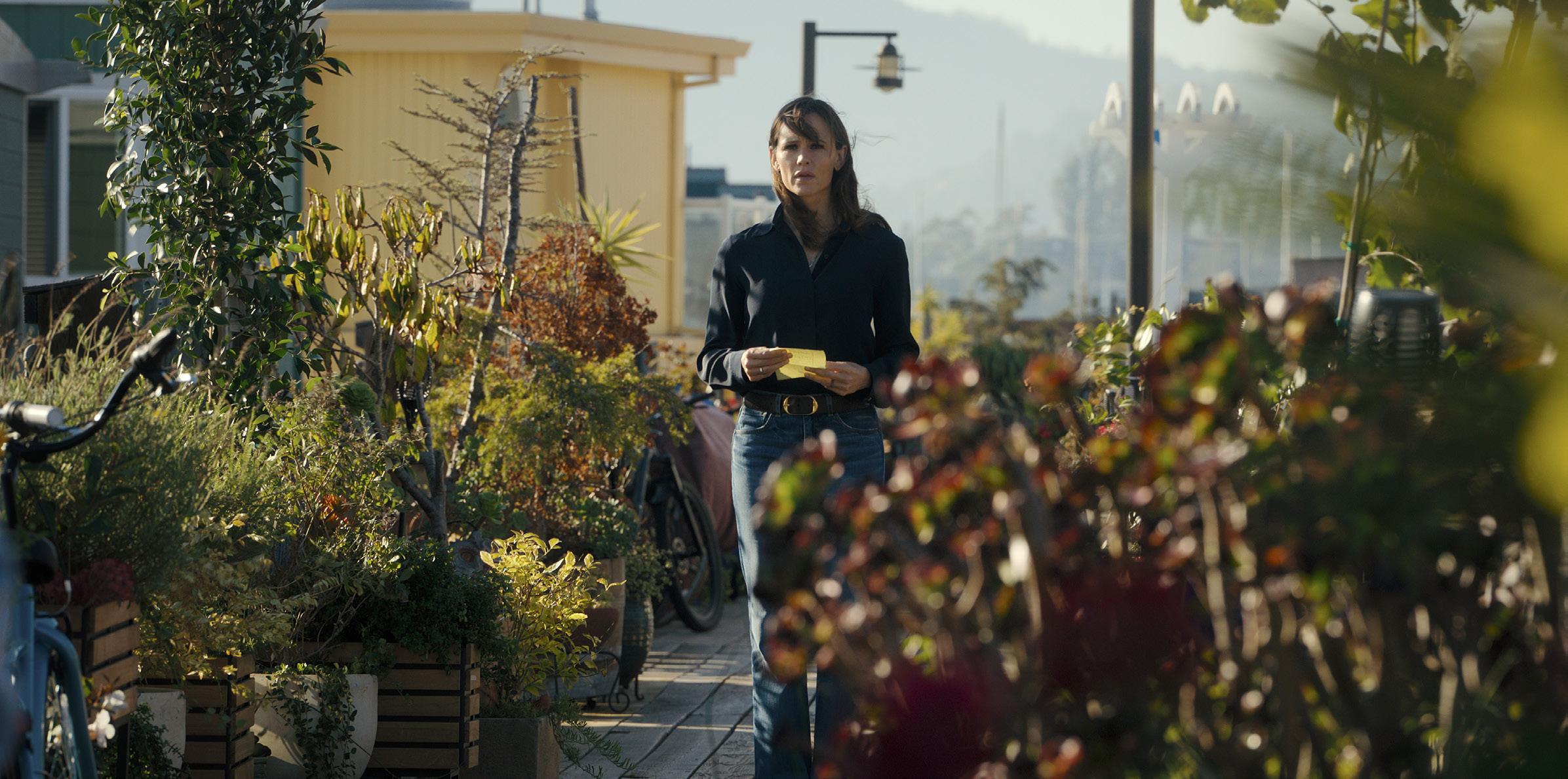

LOCAL 600 CREW
Directors of Photography
Michael McDonough (Episodes 101, 102, 105, 107)
Daryn Okada
(Episodes 103, 104, 106)
A-Camera Operator/Steadicam

Kenny Brown
A-Camera 1st AC
Jamie Felz
A-Camera 2nd AC
Casey Muldoon
B-Camera Operator
Matt Valentine
B-Camera 1st AC
Jamie Stephens
B-Camera 2nd AC
Eric Guthrie
Loader
Ryan Murray
DIT
Sam McConville
Still Photographers
Erin Simkin
Jessica Brooks
Publicist
Charlie Pinto
MCD SAYS HE AND PRODUCING DIRECTOR LIVI NEWMAN TESTED A DOZEN DIFFERENT LENSES AT KESLOW CAMERA BEFORE CHOOSING THE CANON K35’S FOR THE FLASHBACK SCENES. “THE CANON’S HAD THE KINDS OF IMPERFECTIONS AND ORGANIC ELEMENTS THAT WERE VERY DIFFERENT FROM THE SIGNATURE PRIMES WE ENDED UP USING FOR THE PRESENT-DAY SCENES,” MCD RECALLS. “I PICKED THE SIGNATURES, WHICH IS A LENS ROGER DEAKINS HELPED CREATE, BECAUSE THEY HAD SUCH A BEAUTIFUL LOOK.”

TRUE VINTAGE GLASS

ICG MAGAZINE EXPLORES THE HOTTEST TREND IN CINEMATOGRAPHY.

 By Pauline Rogers
Photo by Greg Gayne
By Pauline Rogers
Photo by Greg Gayne
Two words: vintage lenses. It would take a book to even put a dent in the subject. The history. The classification – what is true vintage versus modern vintage, or even the vintage look? And while using older glass (with ultra-sharp digital sensors) has continued to trend upward for the last five years or more, is this a look that’s here to stay? For our May issue, themed around “lenses and lighting,” we opted to skew toward “true vintage” glass with an emphasis on the rental-house perspective (and some user input).
At the risk of going down a wormhole (by diving into the 836-page book on lenses written by Jay Holben and Christopher Probst, ASC), we reached out directly to Holben for an overview. He defines vintage lenses as “representing the images of the collective memory of filmmakers who grew up in a pre-digital era. They represent the images crafted in thousands of movies from the dawn of cinema to the digital revolution. These nostalgic, softer-contrast, more aberrant [or high-character] lenses imbue an emotional response in the audience to the story being told. They aren’t a perfectly faithful representation of the world as we see it, but rather a more artistic and, dare I say, painterly or impressionistic view that may better represent how the filmmakers see their stories.”
The downsides of vintage glass (some of which can also be creative upsides) include an increase in aberrations, a decrease in overall optical performance, original mechanics that can be damaged by today’s lens mechanics, and even environmental conditions – old helical threading, greases, and delicate iris blades – all factors that have led to the rise of rehousing. (More on that later.)
Holben says vintage still camera lenses also offer several advantages, citing Century Precision, Clairmont, Samcine and Cinema Products as companies who pioneered early rehousing of still lenses, “offering a more vintage look [with less] robust coatings and aberration correction than today’s modern cinema lenses. They, generally, have larger image circles to cover more modern, largerformat cameras, and they emulate that nostalgic look that has become so popular.”
Like many, Holben cites the Canon K35s, first released in the early 1970s, as a popular current option. Ironically, “they were not openly favored when they were first released,” Holben says. “Although they were fast [and predated the Arriflex/Zeiss Super Speeds], most cinematographers saw them
as ‘low-budget lenses’ with far too many aberrations. These lenses were practically given away for just a few thousand dollars per set for decades. Today, these poor, rejected lenses are some of the most coveted vintage glass out there,” selling for upwards of $250,000.
Today’s vintage suppliers have continued the trend of “detuning” or custom-tuning lenses for individual projects. Holben says that “the popularity of covering this technique in the press has started a new revolution in tuning glass. Many companies buy inexpensive, well-designed still lenses, alter them, and then repackage them under a new name. When tuning, changing the contrast, resolution, sharpness, flare quality, field curvature and more is possible. While someone can tinker with any lenses and alter the performance, creating a consistent look throughout a set takes great skill and understanding.” Holben is upfront in his take on the changes. “There is a danger in this technique,” he states firmly. “There are some companies purchasing existing lenses, altering them, removing all identifications, and rebranding them as their original creations. The creations may be fantastic, but the subterfuge and outright lying about the origins of the lenses is absolutely unethical and should be heavily discouraged!”
L.A.-based Mark LaFleur’s Old Fast Glass may well carry the widest array of vintage lenses in the industry today. He says that “vintage lenses are simply more abundant. Ten years ago, you may have had five sets of spherical lenses to choose from at a rental house. Now you have 25 sets, and at least half are vintage.”
And that’s not just trendy choices like the Canon K35s, Cooke Speed Panchros, and Zeiss Super Speeds, but also older lenses like Kowa Cine Prominar, Bausch & Lomb Baltars, and Super Baltars. “There is also a surge of interest in the 1960s Canon
Rangefinder lenses, the most famous being the Canon 50-millimeter f/0.95 ‘Dream Lenses,’” LaFleur shares.
Old Fast Glass also concentrates on unique lenses. “We had the first set of rehoused LOMO Super Speeds in the world,” LaFleur shares. “There is nothing like them. They are not still photo lenses. They are 1980s Russian cinema lenses and were totally off the radar until the last few years.” Old Fast Glass also had the first sets of rehoused Nikon AI-S, rehoused Minolta Rokkor, rehoused Canon FD 50-300 mm, rehoused Voigtlander 36-82 mm, and others. “We also convinced TLS to rehouse a Canon FD 15-millimeter fisheye, so we could have a proper full-frame PL-mount fisheye lens,” he adds.
Like Holben, LaFleur is concerned with quirks and challenges.“Still lenses were often designed by different optical designers with each focal length with its own flavor,” he reiterates. “This is why certain sets of rehoused still glass are more desirable than others. For example, if you choose the correct versions, Canon FD, Olympus OM, Minolta Rokkor and Nikon AI-S can make for consistent sets. But then there are inconsistencies in t-stop. While a set of Master Primes are all T1.3 and Cooke S4 are all T2, a set of Leica R can vary from T.2.9 to T1.5. Typically, the wider lenses are always slow.”
LaFleur says vintage has taken over the narrative, commercial and music-video worlds for the simple reason that vintage lenses can make an immediate and bold visual impact. There are also projects with multiple narrative threads, storylines, universes and time periods that all draw clients to mixing vintage and modern (even anamorphic and spherical) to help distinguish separate worlds, times or physical places.
A genre not often talked about when it comes to vintage glass is Music Videos. LaFleur says “they are used a lot because they are short form and often rely on eye-grabbing visuals. Lenses with the heaviest character are often chosen. Where an extremely
74 MAY 2023
TOP/BOTTOM: FOR THE LOW-BUDGET FEATURE RUNNER , DP JOMO FRAY SAYS “THE DIRECTOR WANTED THE FEELING OF BEING OUTSIDE SPACE AND TIME IN AN UNDISCLOSED TIME PERIOD IN AMERICA.”

FRAY TURNED TO ARRI RENTAL’S DNA SERIES, “WHICH ARE A MIX OF THE COOKE S2 [COLOR] AND THE BOKEH OF THE CANON K35,” HE DESCRIBES. “IT’S WEIRD TO HAVE THESE TWO THINGS TOGETHER, BUT IT GAVE ME EXACTLY THE LOOK I NEEDED.” / FRAMEGRABS COURTESY OF JOMO FRAY

75 MAY 2023
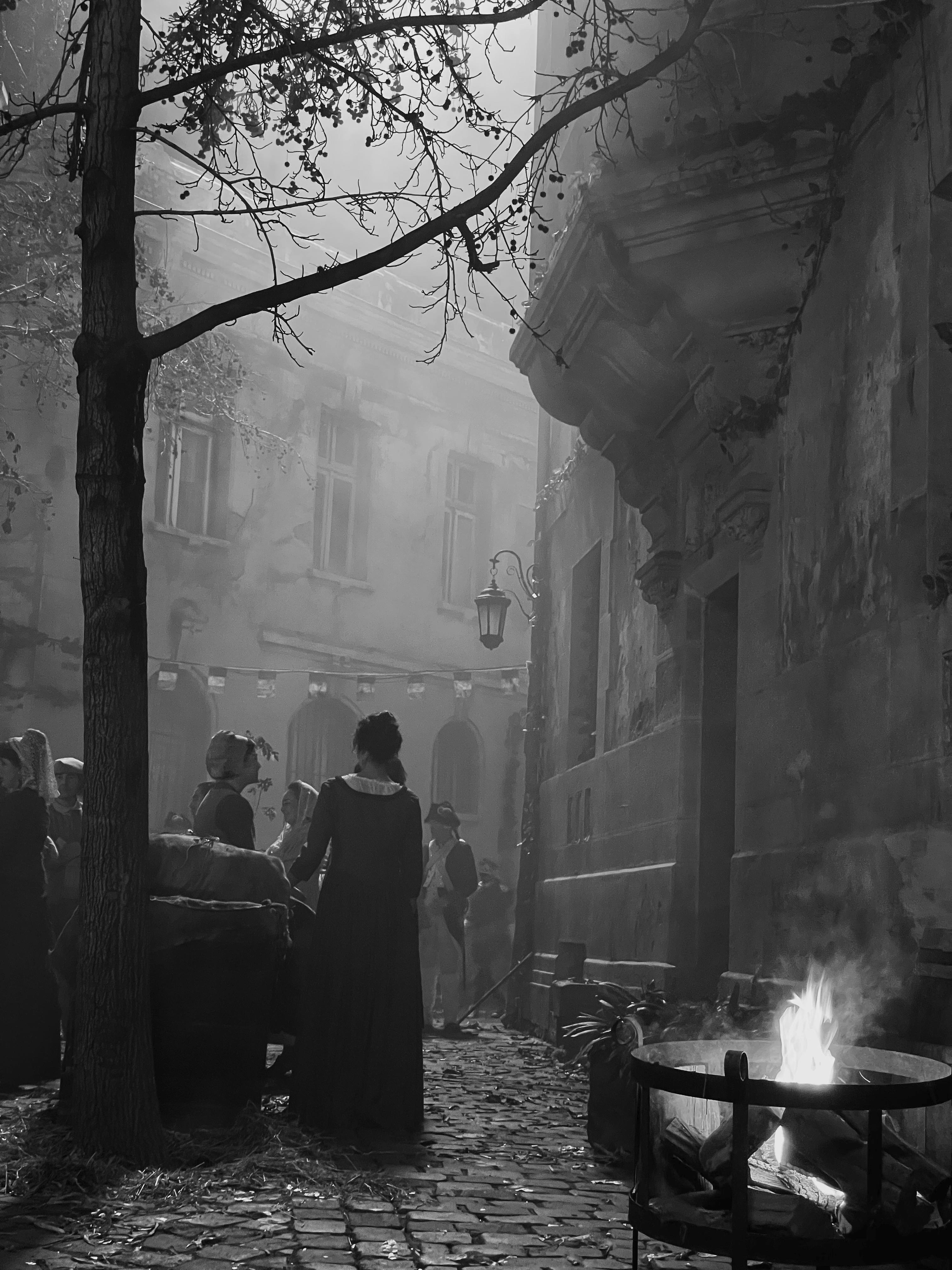
76 MAY 2023 EL CONDE
COURTESY OF ED LACHMAN, ASC
funky lens might be distracting in a 2.5-hour feature film, it might be perfect in a 2.5-minute music video.”
Cinematographer Brent Barbano relies heavily on vintage for his commercials and music videos. Recently it’s been Nippon Scope Anamorphic primes for a major fashion video, Cineovision Anamorphic primes for a music video, Zeiss B-Speeds (TLS) for both a Dior and an OnStar Commercial, and the unique Canon Rangefinder (TLS) for a music video.
“For this music video, the singer was sitting on a chair with a stark background singing to the camera,” Barbano explains. “They didn’t have a huge budget but wanted an impactful way to tell the story. I chose the ARRI Mini LF with the rehoused TLS Canon 50-millimeter Rangefinder from the Dream Set primes. We went for full frame for the biggest change in depth-of-field so I could get closer to the subject and slowly open up from a T5.6 using the Cinefade system to wide open at T1.0. One take –over four minutes. We had beautiful blooms, halation, softness and changing bokeh, all of which supported the story.”
LaFleur says, “It’s exciting to have so many options for clients. But I do worry the market is getting oversaturated. It’s nice when a lens has a lot of character. It’s nice when a lens has character and good performance. But if a lens doesn’t have a lot of character, and performance is either good or similar to modern cinema lenses, it might be better to just use modern lenses. The rental house’s job is sorting through the best options, and that can be hard for us to navigate. There is the risk of rental houses investing in a set of vintage lenses that no one is interested in. And if a vintage lens gets damaged, there is a chance you might not be able to replace it since they are getting more expensive and harder to find. Some lenses have literally disappeared from the used market.”
Risks notwithstanding, Oliver Schietinger, coprincipal of Brooklyn, NY-based TCS Film, says he’s still excited by the vintage market, tracing the TCS experience with the growth of vintage interest to a memory from 2010, before the introduction of modern-day rehousings.
“There was a DP who wanted to use Cooke Speed Panchro lenses, and I remember how excited I was to find a small starter collection on display in our dad’s ‘Used for Sale’ lens cabinet,” he recounts. “There’s a rich irony in today’s appetite for vintage lenses, recognizing the massive shift from the celluloid era, where cinematographers demanded lenses to get better – and better corrected, fewer aberrations, higher contrast. Unfortunately, it’s led to several confusing conversations with the top cinema lens manufacturers arguing for optical flaws. I think I have even managed to – unintentionally – insult one lead optical designer with my suggestions. And I get it. It’s counterintuitive.”
Schietinger also credits rehousing companies like True Lens Service, Zero Optik, and P+S Technik as early pioneers, “without which this wouldn’t be possible,” he adds. “When you look back at a prior generation of rehousings and cine-molding, they offered limited usability, and they were lacking in the
number of focus marks, the mechanical reliability, and the accuracy that today’s rehousing offers. Today we can provide an AC with an on-set experience on par with cinema-purpose-built lenses from Cooke, Leica, and Zeiss; uniform front diameters; internal focusing, and with focus and iris gears in the same position from focal length to focal length, allowing them to move with the speed necessary to meet today’s production deadlines.
“I don’t envy the position that motion-picture lens manufacturers find themselves in,” he continues, “competing with never-ending announcements of lens rehousings. Cooke tried to tackle this with their Panchro Classic modern remakes that they’ve also remade for full-frame coverage. As a result, they can offer consistency from one lens copy to the next. But that’s among the top challenges of putting together a rehoused vintage set, not to mention easy-to-order replacement lenses and lens data.”
Schietinger says there’s an ambiguity in calling lenses like the Zeiss Super Speeds “vintage.” “They aren’t vintage in the sense that they had to be rediscovered,” he notes. “However, they are 40 years old. We have a high-end production that recently wrapped shooting on Gecko-Cam ‘Stealth’ Super Speed rehousing, which solved a host of practical problems you otherwise would be forced to accept. [Guild AC’s Chris Silano and Troy Sola appreciated having them.] The AC experience is a top concern for us. I’m reminded of when Tod Campbell selected Canon K35 lenses for Season 3 of Mr. Robot. I flew to England to meet with the TLS brain trust [Colin Sanders, Keith Truslove, Gavin Whitehurst] on a begging mission, so we could deliver the TLS Canon K35 during their shoot.”
Either way, Schietinger emphasizes that introducing new lenses is a process
“We meticulously evaluate each vintage lens copy we select to re-house to offer the closest matching set of lenses from the series,” he explains. “Not everyone finds that level of effort necessary or worth it. We’ve also experimented with a UV lighting process to reverse the negative effects of radioactive decay on the glass in a lens, which can slow down the expected t-stop and shift the color temperature to warm/yellow. Our objective is to offer accurately rated, color-matched vintage lenses as close as possible to the original intended performance. Some vintage lens aging is also part of the unexpected charm. Ed Lachman compares it to wine aging.”
Speaking of Ed Lachman, ASC (who is a frequent visitor at TCS), the Oscar/Emmy-nominated director of photography says he’s always been a fan of vintage glass. “Camera and lens people can’t keep themselves from designing flat field glass, even when trying to recreate the look of the past,” he describes. “Today, I see a serious interest in the Baltars [which came out pre-1950s, before the computer].
The Cooke Speed Panchros and the K35s [which Lachman used for Desperately Seeking Susan and True Stories ], degrading the image and using the inherent flare are very popular. But, with 8K and 12K, we want lenses that can go against the camera and get a texture to the image.”
Lachman says the digital world flattens the plane, “no depth-of-field or grain – but three RGB layers,” he continues. “It’s lithography – the film is fixated on one plane with digital on three. That’s why when cinematographers want to get more ‘soul’ into their shots and make images more arresting with modern cameras, we turn to rehoused vintages. Recently, I did Pablo Larrain’s El Conde for Netflix with ARRI LF, ALEXA, and Super Baltars for the monochromatic look we wanted to give soul to the story.”
Director of Photography Bobby Bukowski worked with TCS to get the Leica R series for The Last Thing He Wanted, a film set in the late 1970s and early 1980s with Anne Hathaway as Joan Didion. “All stills were shot with those at the time, so I thought, let’s try to capture the same image,” Bukowski describes. “Today’s lenses just aren’t engineered the same way. Everything is cut with lasers and polished machines. Vintage takes us back to when the lenses were cut and polished by hand. We could get into the shadows, and they were nice for the flesh – we went without diffusion. To make sure we were right, I went into TCS with Oliver and Erik, and we put different lenses up and looked – and we were right.” Although Bukowski generally uses vintage quite a lot, he has discovered the “new” vintage lenses – like TRIBE7 (used on Till) and the Blackwings.
Rental houses such as Otto Nemenz are also putting a greater emphasis on vintage. The company recently introduced the Ottoblad (Gear Guide, page 12). Keslow Camera is also increasing its stock. According to Chad Martin, camera service manager for Keslow, vintage is here to stay, but there are challenges. “Everyone talks about T-stop and consistency, coatings aging differently from each other, and more,” Martin shares. “We also have to remember that the cinematographer often has to light what the lens can or can’t do. So [something] might be interesting at a 1.2, but move to a 3.5 – you might have two different shots.
Martin says it’s also a challenge “for our assistants coming in. Pulling focus can be difficult with a lens built for the film and the physical film plane. In addition, focus marks don’t work because the renderings are different in contrast and resolution. Yet those who are true to their desire for vintage will hunt for the right lenses and make them work.”
These include Cinematographer Christian Sprenger and his AC, Justin Watson, who worked with Keslow to choose Kowa Cine Prominars and Olympus OM Zuiko lenses for the series Atlanta Sprenger says the lenses “added an undeniable tactile character to our images. Paired with the story that we were telling and the environments in which our show takes place, it was a spiritual marriage. The lenses became a very important aspect of our staple look.”
So much so, in fact, that when Sprenger began prepping for seasons 3 and 4 (shot concurrently), he and director Hiro Murai opted to incorporate full-frame into certain episodes. “I suddenly found myself searching for a full-frame companion to the Prominars,” Sprenger relates. “Although slightly less milky, we settled on Zero Optik’s Olympus OM Zuikos.”
Watson was in on the tests and choices with
77 MAY 2023
FOR FX’S ATLANTA , DIRECTOR OF PHOTOGRAPHY CHRISTIAN SPRENGER AND FIRST AC JUSTIN WATSON CHOOSE KOWA CINE PROMINARS AND OLYMPUS OM
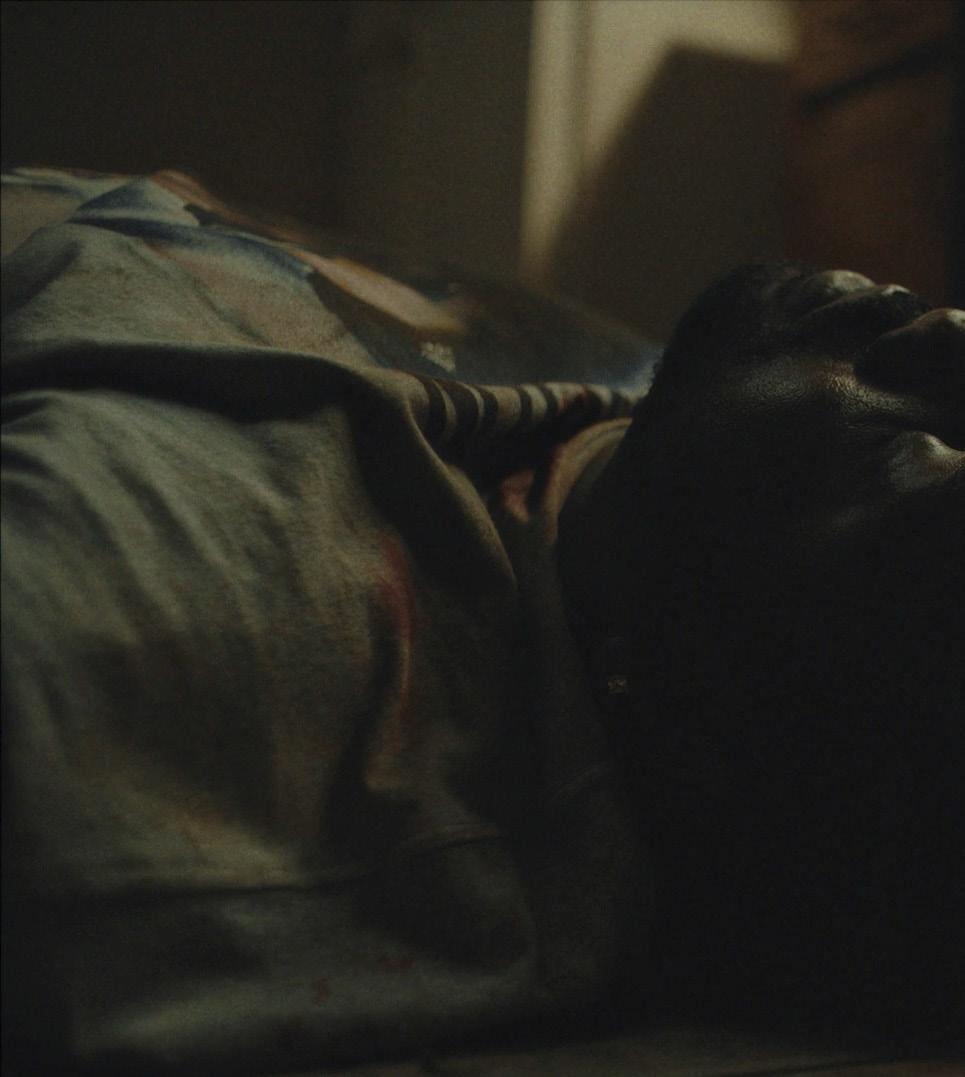

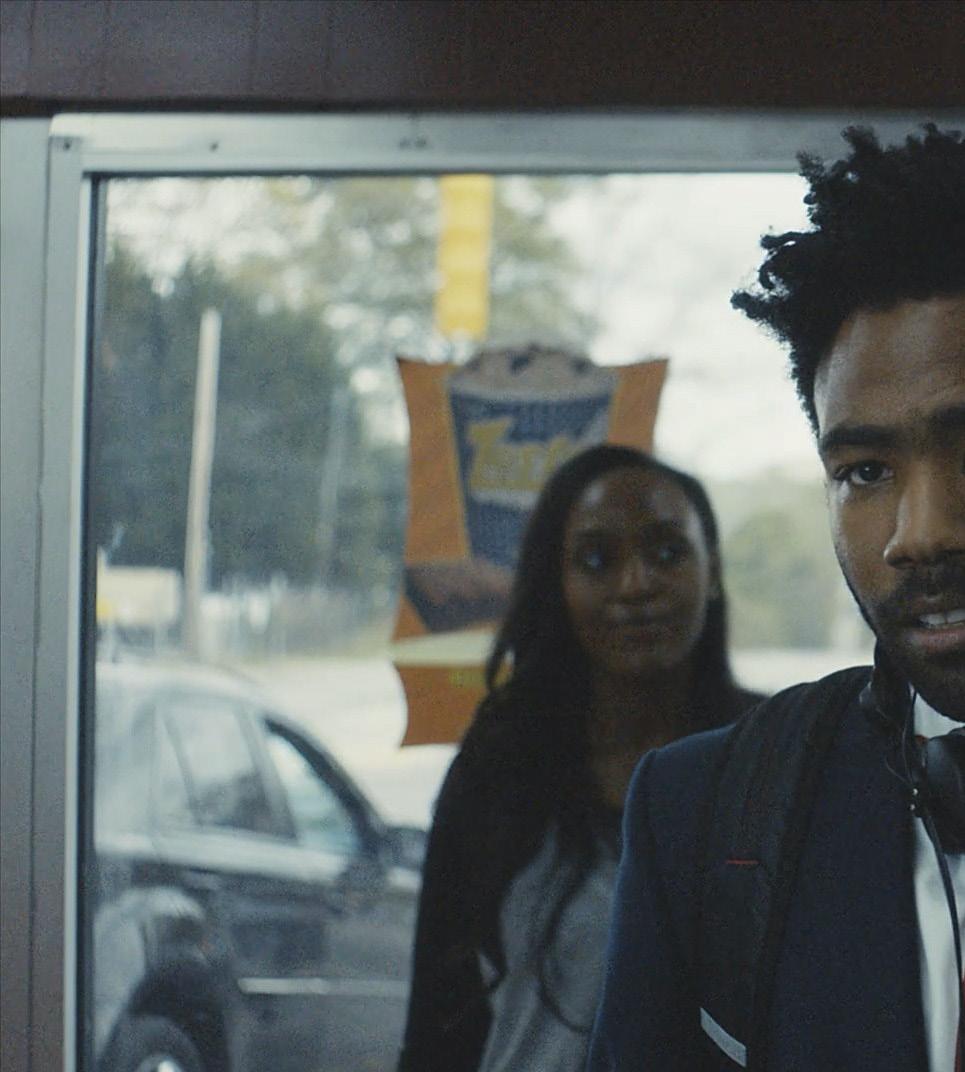



ZUIKO LENSES FROM KESLOW CAMERA. SPRENGER SAYS THE LENSES “ADDED AN UNDENIABLE TACTILE CHARACTER TO OUR IMAGES,” AND FORMED “A
SPIRITUAL MARRIAGE” WITH THE STORY THAT BECAME A KEY PART OF THE SHOW’S LOOK. / FRAMEGRABS COURTESY OF CHRISTIAN SPRENGER
78 MAY 2023




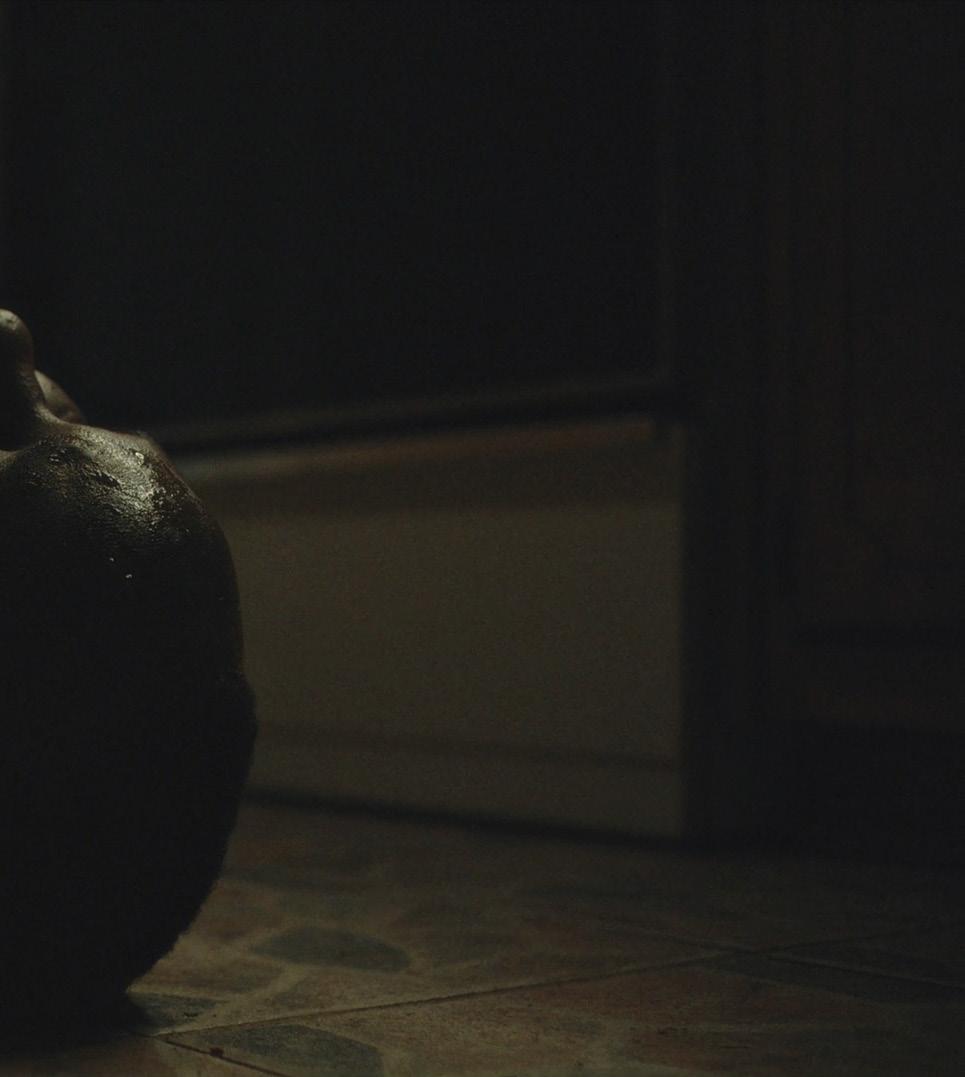

79 MAY 2023
Sprenger and Martin at Keslow. He describes an AC’s relationship with vintage glass as love/hate. “We love the character that comes with old glass, the fall-off, the bokeh and more,” Watson cites, “but dislike most original vintage lens housings and the lack of resolution. The same character we love about vintage lenses is the thing we end up fighting when it does things we don’t like. Our 40-millimeter Kowa Prominar on Atlanta had a soft spot in the upper right corner, and when an actor’s face was composed just so, it would almost look like we were blurring their face to conceal their identity. Our fix was flipping the lens upside down to put the spot on the lower left or spinning it as needed to hide the spot, depending on the frame.”
Watson loves the way some vintage glass can look, “but the thing we battle most is they can’t resolve wide open like modern glass,” he continues. “Many DP’s who like to live at a wide-open stop by default end up needing to close down on specific shots to get some sharpness back. If they don’t, the image contrast and resolution falls apart and turns to mush. Anything below a T2.8 on some lenses, and you’re on the train to Mushtown. Especially on wider shots with smaller detail in the frame, and when a shallow depth-of-field doesn’t read as much, you need to ensure you’re at the right stop for each shot to look its best.”
This wouldn’t be a well-rounded discussion without mentioning manufacturers who maintain a rental department with vintage lenses. Two prime examples are ARRI Rental and Panavision, both of which are continually looking to bring back vintage lenses to serve their clients. Guy McVicker, director of technical marketing at Panavision, likens vintage lenses to the feeling of putting on a favorite pair of old jeans. “I think the rise of vintage lens use began after the 2007/08 Writers Guild strike, when everyone went digital,” McVicker offers. “A car only needs to be 25 years old to be vintage. But Primos were born in the late 1980s, so they’re over 30 years old. However, we refer to them as ‘legacy optics,’ and when we get to optics older than Primos, from the 1980s, 70s, 60s, and 50s, we tend to call those ‘vintage.’”
Panavision often brings its lenses back for specific DP’s and projects. “Dan [Sasaki] brought the Ultra Panatars back for Bob Richardson [ASC],” McVicker adds. “A technician in our Hollywood office just resurrected a MAP55, a macro lens that sat damaged on the shelf for years. These lenses have become very popular in the last decade or so. It’s a first-generation Panavision anamorphic from the late 1950s. They’re the only front-anamorphic macro lenses in our inventory. They get refurbished, but they’re not modified in any way that’s not reversible. They are also expandable to large format.”
When Mitchell Amundsen, ASC, was looking to build his package for The Happytime Murders in 2018 and then John Schwartzman, ASC, for The Highwaymen that same year, Panavision’s H Series were assembled from specific Panavision vintage optics that all manifested the same aesthetic. “We help our cinematographers by mixing lenses when necessary,” McVicker adds. Likewise, when Elliot Davis, with Bill Coe as AC, were prepping for Hocus Pocus 2, McVicker says the team wanted to go as filtration-free as they could. “So, by mixing Leica R’s, expanded 35-millimeter-format Primos, and Primo 70s, all modified to match, they could shoot the movie in 8K on DXL2 – without filtration, even on the closeups,” he adds. “They knew they couldn’t use diffusion in high-contrast situations with specular highlights.”
To McVicker, one of the selling points of vintage lenses is the ability to work without filtration on set. “Filtration can be a wonderful tool, but it leaves a signature in the bokeh, and cinematographers like to cover their tracks. They don’t necessarily want you to look at a shot and know ‘that’s Super 16, and they shot with Hollywood Black Magic, on Zeiss Super Speeds’ – lenses that have a telltale triangular bokeh.
“Filtration in post is a very powerful tool,” he continues, “but it’s expensive, and not every cinematographer is in final color, so there is no guarantee of creative control. Vintage and modified

80 MAY 2023
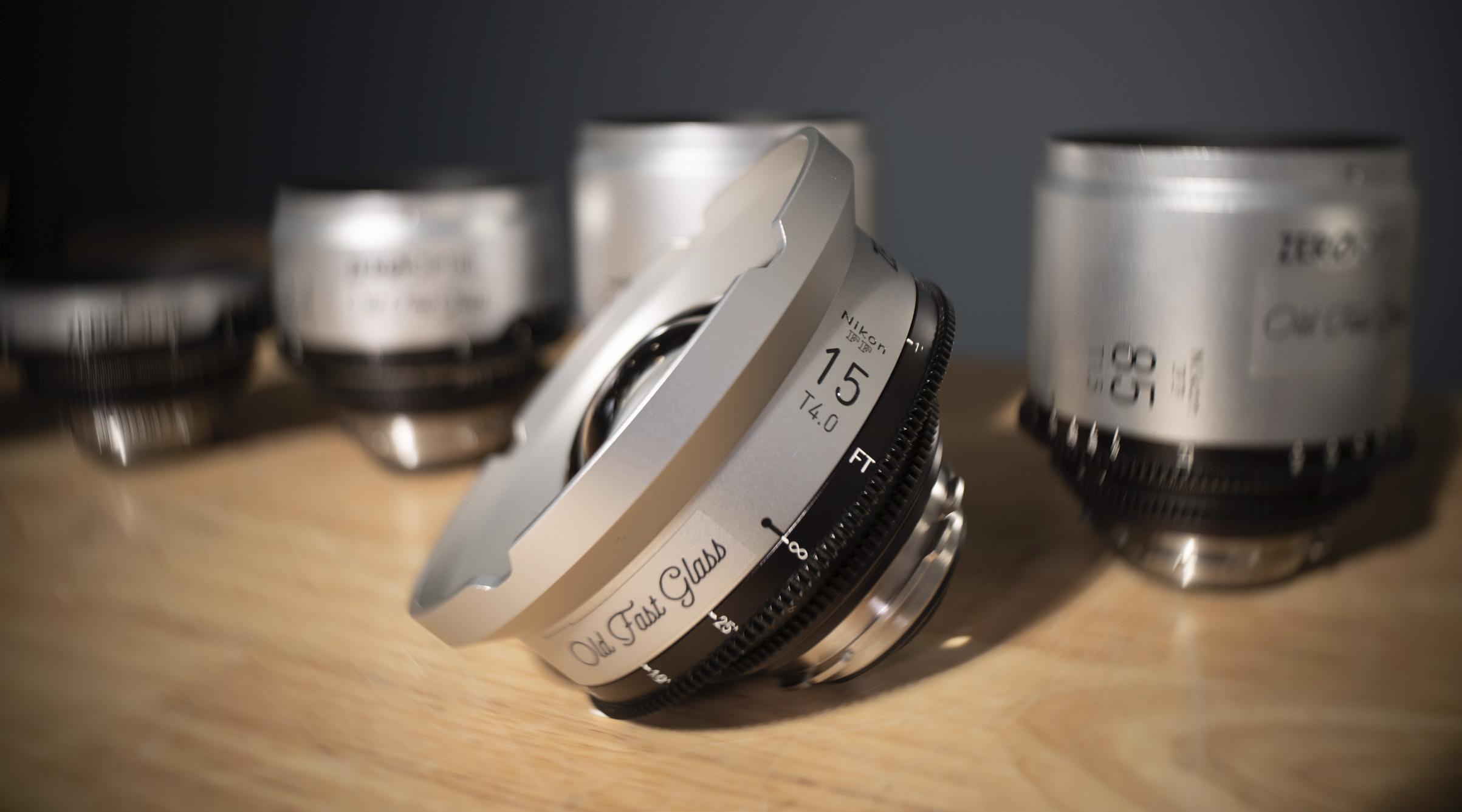
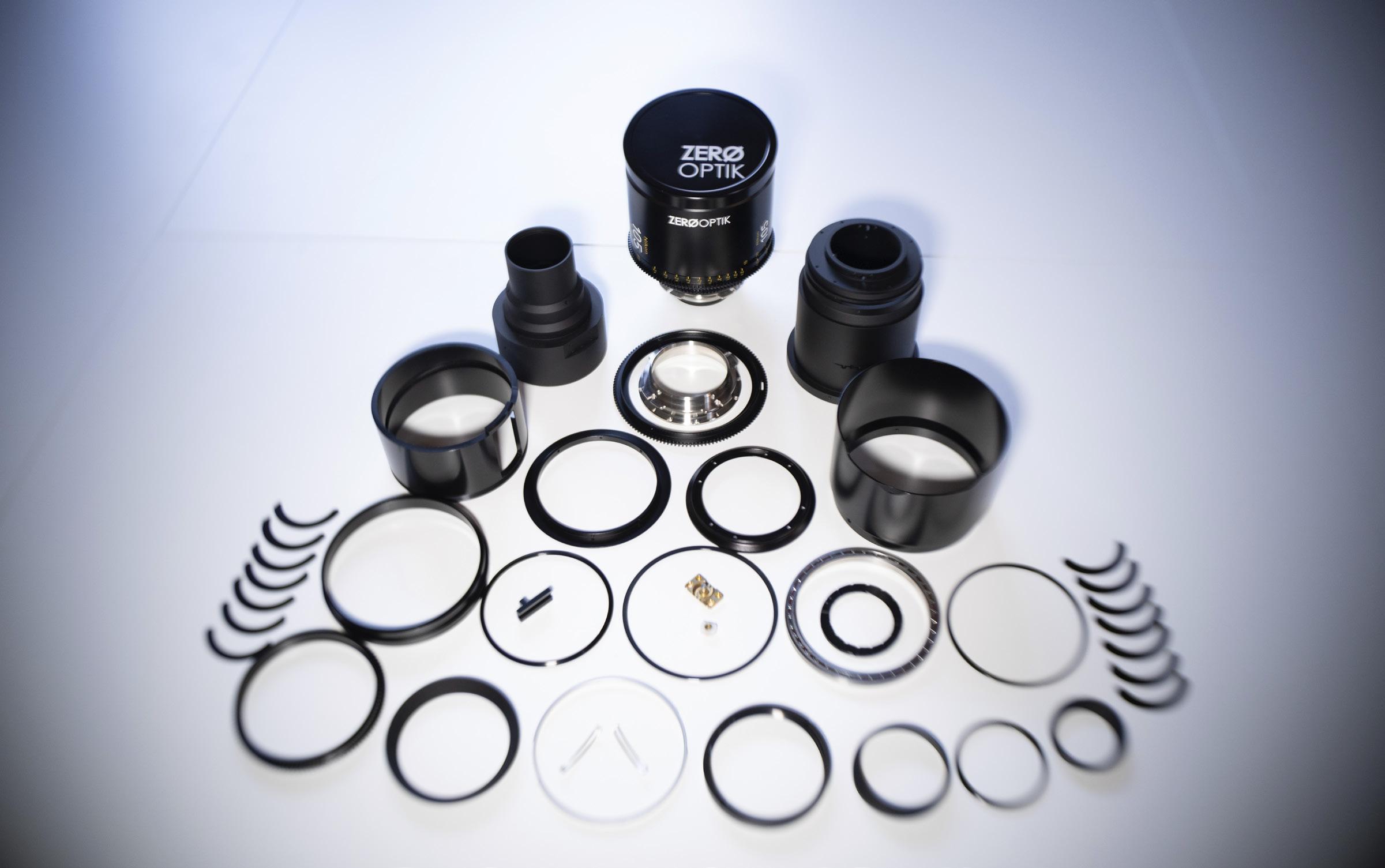
81 MAY 2023
PHOTOS BY GREG GAYNE
TOP: TCS CO-PRINCIPAL OLIVER SCHIETINGER NOTES THE RICH IRONY IN TODAY’S APPETITE FOR “LESS THAN PERFECT VINTAGE LENSES, A MASSIVE SHIFT FROM THE CELLULOID ERA, WHERE CINEMATOGRAPHERS DEMANDED LENSES TO GET BETTER – BETTER CORRECTED, FEWER ABERRATIONS, HIGHER CONTRAST,” HE SHARES. / PHOTO BY ZACH

 DILGARD
DILGARD
BOTTOM: ZERO OPTIK’S ALEX NELSON SAYS REHOUSING CAN BE LIKE BUILDING A NEW ROLEX FROM AN OLD ROLEX WATCH. “A LENS MIGHT NOT HAVE BEEN SERVICED FOR 80 YEARS. THE RINGS ARE FROZEN. HOW DO YOU EXTRACT A PART WITHOUT DAMAGING OTHERS?” / PHOTO BY GREG GAYNE
82 MAY 2023
DIRECTOR OF PHOTOGRAPHY BOBBY BUKOWSKI USED LEICA’S R SERIES FROM TCS FOR THE LAST THING HE WANTED , SET IN THE LATE 1970S AND EARLY 1980S. “VINTAGE TAKES US BACK TO WHEN THE LENSES WERE CUT AND POLISHED BY HAND,” BUKOWSKI DESCRIBES.

“WE COULD GET INTO THE SHADOWS, AND THEY WERE SO NICE FOR THE FLESH, WE WENT WITHOUT DIFFUSION.” / FRAMEGRAB COURTESY OF BOBBY BUKOWSKI
modern lenses are in high demand because they offer creative control via in-camera effects. Whether you have the final say in the grade or not, you want to do as much in camera as possible to author your image, to ensure your vision survives in the post process, and to give the colorist as solid an image to work with as possible.”
Mike Sippel, senior engineer of technologies and applications at ARRI Rental, says there is “generally no reason not to rehouse and plenty of reasons why you would. Modern film sets have certain expectations in terms of how they want to be able to use a lens [compatibility with remote focus systems being the paramount one],” Sippel explains, “and many un-rehoused vintage lenses don’t have mechanics friendly to motor-driving focusing. The focus mechanism may also be an older helical style, as opposed to modern cam-driven, which precludes or at least complicates the use of clip-on matte boxes. Older mechanics can be difficult to maintain due to a lack of parts. A good modern rehousing addresses all these concerns while leaving the desired vintage optical characteristics of the lens untouched.”
Sippel says that in some cases, “it’s almost impossible to replicate older lens designs because of materials they used in their construction, which might no longer be legal to produce,” he continues. “Substrates and coatings incorporating the element lead, for example, are no longer produced as part of the global effort to control lead contamination in the environment. Likewise, thoriated glass [which is radioactive] is banned for obvious public safety reasons.”
There is another approach – reverseengineering a vintage lens to get the same look with modern materials. “That’s extremely difficult,
even for a very talented lens designer, just because it’s often difficult to know which qualities specifically [in concrete optical terms] make a lens attractive to a cinematographer,” Sippel adds. “When talking about lenses, cinematographers use artistic terms like ‘creamy bokeh’ or ‘gentle focus roll-off,’ which don’t translate into discrete optical design parameters to which a lens designer can immediately say: ‘I know exactly what you want’ with any degree of certainty.”
ARRI Rental often applies its secret sauce to bring lenses back to life. One example is the DNA series. Jomo Fray, a long-time ARRI Rental client, has tested the DNA lenses on a host of commercials and a low-budget feature called Runner . “The director wanted the look and feeling of Americana and Midwestern bleak,” Fray says. “The feeling of being outside space and time in an undisclosed time period in America. I began working with Lynn “Gus” Gustafson at ARRI Rental. He showed me the DNA series, and it blew me away. I call it ‘Frankenstein pieces’ – the opticals are a mix of the Cooke S2 [color] and the bokeh of the K35. It’s weird to have these two things together, but it gave me exactly the look I needed.” ARRI Rental’s DNA line has also been embraced by major theatrical productions, like last year’s All Quiet on the Western Front (Prime DNA lenses), for which James Friend, ASC, BSC, won the Oscar for cinematography, as well as The Lord of Rings: The Rings of Power and House of the Dragon (both using DNA LF).
Before we bring this sequel to an end, we need to explore the challenges of rehousing. Alex Nelson of Zero Optik is at the forefront, and he keeps cool under the most demanding conditions. “There is
a wide spectrum of ways to approach bringing back vintage lenses to suit a cinematographer’s needs,” Nelson says. “Some are conservative and others holistic. They all are time-consuming. When a rehousing company goes into a job, it’s important to understand that a precise timeline isn’t always applicable.”
Nelson says rehousing can be like building a new Rolex from an old Rolex watch. “A lens might not have been serviced for 80 years. The rings are frozen. How do you extract a part without damaging others?” Nelson asks. Although Zero Optik has worked on Baltars, Leicas, Canon K35s, and Zeiss Contax lenses, one of their most interesting challenges was reengineering vintage Olympus photo lenses, where mechanical requirements were tighter and the optical performance much higher. Nelson says, “We reused only the glass elements, designing completely new metalwork, mechanics, and a housing where we could go out of the way to recalibrate the optics. It didn’t happen overnight.”
And that’s one of the key takeaways from this exploration of true vintage lenses. The supplier/user must have the desire to work hard to find the right lens, make sure it’s going to provide the desired character, and ensure it’s available for whatever job. Sometimes, the exploration is exhausted, and with cost, time frame and more, cinematographers will put a hold on using “true vintage” and turn to what Jean-Marc Bouchut at Zeiss says is “modern” adapted for vintage. “They are more consistent, made with computers, and the level of quality control is different,” he concludes. Bouchut (and others) have more to say about “new vintage” lenses, like Blackwing and TRIBE7, for example.
But we’ll save that for our next exploration.
83 MAY 2023
PRODUCTION CREDITS
COMPILED BY TERESA MUÑOZ
The input of Local 600 members is of the utmost importance, and we rely on our membership as the prime (and often the only) source of information in compiling this section. In order for us to continue to provide this service, we ask that Guild members submitting information take note of the following requests:
Please provide up-to-date and complete crew information (including Still Photographers, Publicists, Additional Units, etc.). Please note that the deadline for the Production Credits is on the first of the preceding cover month (excluding weekends & holidays).

Submit your jobs online by visiting: www.icg600.com/MY600/Report-Your-Job
Any questions regarding the Production Credits should be addressed to Teresa Muñoz at teresa@icgmagazine.com
ABC STUDIOS
“JIMMY KIMMEL LIVE!” SEASON 20
LIGHTING DIRECTOR: CHRISTIAN HIBBARD
OPERATORS: GREG GROUWINKEL, PARKER BARTLETT, GARRETT HURT, MARK GONZALES
STEADICAM OPERATOR: KRIS WILSON
JIB OPERATORS: MARC HUNTER, RANDY GOMEZ, JR., NICK GOMEZ
CAMERA UTILITIES: CHARLES FERNANDEZ, SCOTT SPIEGEL, TRAVIS WILSON, DAVID FERNANDEZ, ADAM BARKER

VIDEO CONTROLLER: GUY JONES
STILL PHOTOGRAPHERS: KAREN NEAL, MICHAEL DESMOND
2ND UNIT
DIRECTORS OF PHOTOGRAPHY: BERND REINBARDT, STEVE GARRETT
“GREY’S ANATOMY” SEASON 19
DIRECTORS OF PHOTOGRAPHY: BYRON SHAH, JEANNE TYSON
OPERATORS: STEPHEN CLANCY, SARAH LEVY, GREG WILLIAMS
ASSISTANTS: NICK MCLEAN, KIRK BLOOM, FORREST THURMAN, LISA BONACCORSO, CHRIS JONES, J.P. RODRIGUEZ
STEADICAM OPERATOR: STEPHEN CLANCY
STEADICAM ASSISTANT: NICK MCLEAN
LOADER: MARTE POST
DIGITAL UTILITY: SPENCER ROBINS
“GROWN-ISH” SEASON 6
DIRECTOR OF PHOTOGRAPHY: MARK DOERING-POWELL, ASC
OPERATORS: JESSE EVANS, ROBIN PABELLO
ASSISTANTS: ROBERT SCHIERER, MICHAEL KLEIMAN, TOMMY IZUMI, ROCIO MEDA
LOADER: ANDREW OLIVER
DIGITAL UTILITY: LAUREN VANDERWERKEN
STILL PHOTOGRAPHER: RON JAFFE
A+E STUDIOS
“THE LINCOLN LAWYER” SEASON 2 DIRECTOR OF PHOTOGRAPHY: ABRAHAM MARTINEZ OPERATORS: DENNIS NOYES, BRETT JUSKALIAN ASSISTANTS: JOE CHEUNG, BRENDAN DEVANIE, PENNY SPRAGUE, BEN PERRY
DIGITAL IMAGING TECH: FRANCESCO SAUTA CAMERA UTILITIES: ANDREW VERA, ELANA COOPER LOADER: RAUL PEREZ
APPLE STUDIOS, LLC
“CATAMOUNT”
DIRECTORS OF PHOTOGRAPHY: YARON ORBACH, EDUARDO MAYEN
OPERATORS: PHIL MARTINEZ, EDUARDO FIERRO ASSISTANTS: CAZ DUFFY, MICHAEL LEONARD, JIM MCCANN, LEON SANGINITI
STEADICAM OPERATOR: PHIL MARTINEZ
DIGITAL IMAGING TECH: STEPHEN LATTY
LOADERS: SEAN GALCZYK, RYAN BALDWIN
STILL PHOTOGRAPHER: JESSICA KOURKOUNIS
PUBLICIST: AMY JOHNSON
BEACHWOOD SERVICES
“DAYS OF OUR LIVES” SEASON 59
DIRECTOR OF PHOTOGRAPHY: DAVID MEAGHER
OPERATORS: MARK WARSHAW, MICHAEL J. DENTON, JOHNNY BROMBEREK, STEVE CLARK
CAMERA UTILITY: GARY CYPHER
VIDEO CONTROLLER: ALEXIS DELLAR HANSON
BLIND FAITH PRODUCTIONS, LLC
“DAREDEVIL: BORN AGAIN” SEASON 4
DIRECTOR OF PHOTOGRAPHY: HILLARY FYFE SPERA
OPERATORS: THOMAS SCHNAIDT, BLAKE JOHNSON
ASSISTANTS: ALEXANDER WORSTER, OLGA ABRAMSON, YALE GROPMAN, ANGJELA COVIAUX
DIGITAL IMAGING TECH: PATRICK CECILIAN
LOADERS: MCKENZIE RAYCROFT, BRIANNA MCCARTHY
STILL PHOTOGRAPHER: GIOVANNI RUFINO
PUBLICIST: NICOLE KALISH
CBS
“JUMPSTART” PILOT
DIRECTOR OF PHOTOGRAPHY: GEORGE MOORADIAN, ASC
OPERATORS: RON HIRSHMAN, DEBORAH O’BRIEN, ALLEN MERRIWEATHER, BRIAN GUNTER
ASSISTANTS: BRAD TRAVER, MARK JOHNSON
CAMERA UTILITY: VERONICA DAVIDSON
DIGITAL UTILITY: KATE STEINHEBEL
VIDEO CONTROLLER: KELSEY NINER
“ENTERTAINMENT TONIGHT” SEASON 41 LIGHTING
DESIGNER: DARREN LANGER
DIRECTOR OF PHOTOGRAPHY: KURT BRAUN
OPERATORS: JAMES B. PATRICK, ALLEN VOSS, ED SARTORI, BOB CAMPI,
RODNEY MCMAHON, ANTHONY SALERNO
JIB OPERATOR: JAIMIE CANTRELL
CAMERA UTILITY: TERRY AHERN
VIDEO CONTROLLERS: MIKE DOYLE, PETER STENDAL
“EVIL” SEASON 4
DIRECTORS OF PHOTOGRAPHY: PETR HLINOMAZ, FRED MURPHY
OPERATORS: KATE LAROSE, PARRIS MAYHEW
ASSISTANTS: ROBERT BECCHIO, RENE CROUT, ALISA COLLEY, VINCENT LARAWAY
LOADERS: FAITH EMMOLO-JOHNSON, HOLDEN HLINOMAZ, ROBERT STACHOWICZ, DENIZE SZALMA
STILL PHOTOGRAPHER: ELIZABETH FISHER
“FRASIER” SEASON 1
DIRECTOR OF PHOTOGRAPHY: GARY BAUM, ASC
OPERATORS: ALEC ELIZONDO, DEBORAH O’BRIEN, LANCE BILLITZER, EDDIE FINE
ASSISTANTS: NIGEL STEWART, BRADLEY TRAVER, CHRIS WORKMAN, JEFF ROTH, YUKA KADONO
UTILITIES: DAN LORENZE, RICHIE FINE
VIDEO CONTROLLER: JOHN O’BRIEN
DIGITAL IMAGING TECH: DEREK LANTZ
85 MAY 2023 PRODUCTION CREDITS
“THE TALK” SEASON 13
LIGHTING DIRECTOR: MARISA DAVIS
PED OPERATORS: ART TAYLOR, MARK GONZALES, ED STAEBLER
HANDHELD OPERATORS: RON BARNES, KEVIN MICHEL, JEFF JOHNSON
JIB OPERATOR: RANDY GOMEZ
HEAD UTILITY: CHARLES FERNANDEZ
UTILITIES: MIKE BUSHNER, DOUG BAIN, DEAN FRIZZEL, BILL GREINER, JON ZUCCARO
VIDEO CONTROLLER: RICHARD STROCK
STILL PHOTOGRAPHER: RON JAFFE
CHRISTMAS RETURNS, LLC
“WHERE ARE YOU CHRISTMAS?”
DIRECTOR OF PHOTOGRAPHY: BRANDEN MAXHAM
OPERATORS: NEAL TEN EYCK, LUIGI BENVISTO
ASSISTANTS: SAMUEL LUSTED, SANAE ONO, MATTHEW SULLIVAN, PAUL STENKO, DEAN EGAN
LOADER: PAYTON BERGKAMP
STILL PHOTOGRAPHER: ROBERT CLARK
CHUCK LORRE PRODUCTIONS
“HOW TO BE A BOOKIE”
DIRECTOR OF PHOTOGRAPHY: JAIME REYNOSO, AMC
OPERATORS: MIKAEL LEVIN, APRIL RUANE CROWLEY, ILAN LEVIN, JOEL PERKAL
ASSISTANTS: ROBERT MUTHAMIA, MATTHEW G. FISHER, RYAN PILON, ROSE LICAVOLI, CAMERON OWEN, NATHAN CRUM
GHOST PRODUCTIONS, INC.
“POWER BOOK II: GHOST” SEASON 4
DIRECTORS OF PHOTOGRAPHY: AARON MEDICK, DANIEL PATTERSON
OPERATORS: JAY SILVER, GARETH MANWARING, PHILIP MARTINEZ
ASSISTANTS: MICHAEL GAROFALO, RODRIGO MILLAN GARCE, TREVOR WOLFSON, KATHERINE RIVERA
DIGITAL IMAGING TECH: ROB MUIA
LOADERS: BRENDAN CRILLEY, FAY EMMOLO-JOHNSON
STILL PHOTOGRAPHERS: PAUL SCHIRALDI, MATTHEW INFANTE, CARA HOWE
PUBLICIST: SABRINA LAUFER
IONIC PRODUCTIONS, LLC
“CALLBACK” SEASON 1
DIRECTORS OF PHOTOGRAPHY: BRETT PAWLAK, ARMANDO SALAS
OPERATORS: CHRISTOPHER ARATA, TREY CLINESMITH
ASSISTANTS: NITO SERNA, SAM LINO, NEIL CHARTIER, TRACI CHARTIER
STEADICAM OPERATOR: TREY CLINESMITH
DIGITAL IMAGING TECH: AARON PICOT
LOADER: ANNIE LI
CAMERA UTILITY: SAM HOILAND
SCORPIO HEAD TECH: JAY SHEVECK
STILL PHOTOGRAPHER: SUZANNE TENNER
PUBLICIST: JOHN PISANI
INSTIGATORS, LLC
“THE INSTIGATORS AKA QUINCY”
DIRECTORS OF PHOTOGRAPHY: HENRY BRAHAM, ANDREW ROWLANDS
OPERATOR: GREGOR TAVENNER
ASSISTANTS: DERMOT HICKEY, JAMES SCHLITTENHART, EVE STRICKMAN, JAMES DEAN DRUMMOND
LOADER: ELIZABETH COMPTON
DIGITAL UTILITY: KEENAN KIMETTO
STILL PHOTOGRAPHERS: JON COURNOYER, CLAIRE FOLGER
PUBLICIST: JULIE KUEHNDORF
LINEAR PRODUCTIONS, LLC
“UNTITLED JOSH AND LAUREN PROJECT” SEASON 1
DIRECTORS OF PHOTOGRAPHY: TIM ORR, MICHAEL DALLATORRE
OPERATORS: MATTHEW DOLL, MICHAEL REPETA
ASSISTANTS: PATRICK BOROWIAK, ELI WALLACE-JOHANSSON, ROY KNAUF, JILL AUTRY
DIGITAL IMAGING TECH: ANDY BADER
LOADER: PAIGE ELIZABETH MARSICANO
DIGITAL UTILITY: ANTHONY RICHARD SCOPINO
STILL PHOTOGRAPHER: DANA HAWLEY
PUBLICIST: BRANDEE BROOKS
MAGIC CARPET PRODUCTIONS, LLC
“UNTITLED NEW YORK CHRISTMAS PROJECT AKA THE GENIE”
DIRECTOR OF PHOTOGRAPHY: JOHN GULESERIAN
OPERATORS: JOHN MOYER, HEATHER NORTON ASSISTANTS: TIMOTHY METIVIER, DJ CARROLL, RONALD WRASE, LAURA ERAUD
DIGITAL IMAGING TECH: CURTIS ABBOTT
LOADER: LUISA ORTIZ
STILL PHOTOGRAPHERS: STEPHANIE MEI-LING, JEONG PARK
MAIN LOT PRODUCTIONS, LLC
“PRETTY LITTLE LIARS: SUMMER SCHOOL” SEASON 2 DIRECTORS OF PHOTOGRAPHY: STANLEY FERNANDEZ, CARMEN CABANA
OPERATORS: CARLOS GUERRA, MICHELLE MARRION
ASSISTANTS: GAVIN FERNANDEZ, NICALENA IOVINO
DIGITAL IMAGING TECH: LEWIS ROTHENBERG
PUBLICIST: KELLEY POPHAM
NBC UNIVERSAL TELEVISION, LLC
“FBI” SEASON 5
DIRECTOR OF PHOTOGRAPHY: BART TAU
OPERATORS: AFTON GRANT, MICHAEL LATINO ASSISTANTS: LEE VICKERY, YURI INOUE, GEORGE LOOKSHIRE, NKEM UMENYI
LOADERS: RAUL MARTINEZ, CONNOR LYNCH
STILL PHOTOGRAPHER: BENNETT RAGLIN
“GIRLS5EVA” SEASON 3
DIRECTOR OF PHOTOGRAPHY: JOHN INWOOD
OPERATORS: DAVID TAICHER, ROBERT PAGLIARO
ASSISTANTS: DOUGLAS FOOTE, CAI HALL, DONALD GAMBLE, PATRICK BRACEY
DIGITAL IMAGING TECH: GUILLERMO TUNON
LOADERS: LISA CHIN, SAVANNAH ROSE LESLIE
STILL PHOTOGRAPHERS: EMILY ARAGONES, MATT INFANTE, MICHAEL PARMELEE
“LAW & ORDER” SEASON 22
DIRECTOR OF PHOTOGRAPHY: CRAIG DIBONA, ASC
OPERATORS: CHRIS HAYES, TOM WILLS
ASSISTANTS: ALEX WATERSTON, IAN BRACONE, DEREK DIBONA, EMILY DUMBRILL
LOADERS: MAX SCHWARZ, MATT ELDRIDGE
“LAW & ORDER: ORGANIZED CRIME” SEASON 3
DIRECTOR OF PHOTOGRAPHY: JIM DENAULT, ASC
OPERATORS: JONATHAN BEATTIE, JOHN PIROZZI
ASSISTANTS: JOHN OLIVERI, NICHOLAS HAHN, KEVIN HOWARD, DERRICK DAWKINS
LOADERS: PAT ARELLANO, BRANDON OSBORN
“THE EQUALIZER” SEASON 3
DIRECTORS OF PHOTOGRAPHY: TERRENCE BURKE, RON FORTUNATO
OPERATORS: JOSPEPH BLODGETT, TODD SOMODEVILLA, JASON MASON, RICARDO SARMIENTO
ASSISTANTS: ADAM GONZALEZ, JOHN FITZPATRICK, JELANI WILSON, BRYANT BAILEY, JAY ECKARDT, WARIS SUPANPONG, MICHAEL LOBB, JASON RASWANT, NIALANEY RODRIGUEZ, DANTE CORROCHER, ALEJANDRO LAZARE
DIGITAL IMAGING TECHS: TIFFANY ARMOUR-TEJADA, NATHANIEL SPIVEY
LOADERS: NAJOOD ALTERKAWI, TOM FOY, JAMAR OLIVE, SAM SHOEMAKER
STILL PHOTOGRAPHERS: MICHAEL GREENBERG, ALYSSA LONGCHAMP
NETFLIX PRODUCTIONS, LLC
“THE PERFECT COUPLE”
DIRECTORS OF PHOTOGRAPHY: ROBERTO DE ANGELIS, SHANE HURLBUT, ASC
OPERATOR: CHRISTOPHER MOSELEY
ASSISTANTS: EJ MISISCO, GREGORY WIMER, MATTHEW HEDGES, RICHELLE TOPPING
DIGITAL IMAGING TECH: MATTHEW LOVE
LOADER: GABRIELLA PEZZELLI
DIGITAL UTILITY: EMILY BARONE
STILL PHOTOGRAPHER: SEACIA PAVAO
NORTH CENTER PRODUCTIONS, LLC
“THE PENGUIN”
DIRECTOR OF PHOTOGRAPHY: DARRAN TIERNAN
OPERATORS: SAM ELLISON, ELI ARONOFF
ASSISTANTS: KALI RILEY, DEAN MARTINEZ, ADAM RUSSELL, BRIAN GRANT
STEADICAM OPERATOR: ELI ARONOFF
DIGITAL IMAGING TECH: ANTHONY HECHANOVA
LOADER: TAYLOR PRINZIVALLI
CAMERA UTILITY: MOXIE HARFELD
STILL PHOTOGRAPHER: MACALL POLAY
PARAMOUNT PICTURES
“MEAN GIRLS: THE MUSICAL”
DIRECTOR OF PHOTOGRAPHY: WILLIAM KIRSTEIN
OPERATORS: ARI ROBBINS, BRIAN JACKSON
ASSISTANTS: ERIC SWANEK, ANDREW PECK, TYLER SWANEK, CAROLYN WILLS
MAY 2023 PRODUCTION CREDITS 86
DIGITAL IMAGING TECH: GABRIEL KOLODNY
LOADER: AMANDA LETTIERI
STILL PHOTOGRAPHER: JOJO WHILDEN
SHOWTIME
“BILLIONS” SEASON 7
DIRECTORS OF PHOTOGRAPHY: JOSEPH GALLAGHER, GIORGIO SCALI, BRAD SMITH
OPERATORS: ALAN PIERCE, NICOLA BENIZZI
ASSISTANTS: GRAHAM BURT, LEONARDO GOMEZ, KELLON INNOCENT, SEAN MCNAMARA
LOADER: HUSSEIN FARRAJ
STILL PHOTOGRAPHERS: PATRICK HARBRON, WILLIAM DOUGLAS MEILS
SONY PICTURES TELEVISION
“JEOPARDY!” SEASON 36
DIRECTOR OF PHOTOGRAPHY: JEFF ENGEL
OPERATORS: DIANE L. FARRELL, SOC, MIKE TRIBBLE, JEFF SCHUSTER, L. DAVID IRETE
JIB ARM OPERATOR: MARC HUNTER
HEAD UTILITY: TINO MARQUEZ
CAMERA UTILITY: RAY THOMPSON
VIDEO CONTROLLER: JEFF MESSENGER
VIDEO UTILITIES: MICHAEL CORWIN, JEFF KLIMUCK
STILL PHOTOGRAPHER: CAROL KAELSON
“WHEEL OF FORTUNE” SEASON 37
DIRECTOR OF PHOTOGRAPHY: JEFF ENGEL
OPERATORS: DIANE L. FARRELL, SOC,
L.DAVID IRETE, RAY GONZALES, MIKE TRIBBLE
HEAD UTILITY: TINO MARQUEZ
CAMERA UTILITY: RAY THOMPSON
VIDEO CONTROLLER: JEFF MESSENGER
VIDEO UTILITIES: MICHAEL CORWIN, JEFF KLIMUCK
JIB ARM OPERATOR: STEVE SIMMONS
STILL PHOTOGRAPHER: CAROL KAELSON
STALWART PRODUCTIONS, LLC
“SUMMIT”
DIRECTOR OF PHOTOGRAPHY: ADRIAN CORREIA
OPERATORS: DEVIN LADD, KATHLEEN HARRIS
ASSISTANTS: ANDREW BRINKMAN, CASEY JOHNSON, JOSHUA REYES, YAYO VANG
CAMERA UTILITY: VICTOR DUNN
DIGITAL IMAGING TECH: LOIC DE LAME
LOADER: PAUL SPANG
STILL PHOTOGRAPHER: GENE PAGE
VERIFIED
“NEON”
DIRECTOR OF PHOTOGRAPHY: DIANA MATOS
OPERATORS: EDGAR COLON, CESAR MARRERO
ASSISTANTS: ABNER MEDINA ALEJANDRO, BRENDALIZ NEGRON COLON, ZORAIDA LUNA, MARAYDA CABRERA DAVILA
LOADER: NESTOR CESTERO
STILL PHOTOGRAPHER: FRANCISCO ROMAN SANCHEZ
WARNER BROS PICTURES
“JULIET AKA JOKER 2”
DIRECTOR OF PHOTOGRAPHY: LAWRENCE SHER, ASC
OPERATOR: COLIN ANDERSON
ASSISTANTS: JARED JORDAN, GREGORY IRWIN, MICHELLE CLAYTON SAMARAS, JAMES PAIR, JERRY PATTON
DIGITAL IMAGING TECH: NICHOLAS KAY
LOADER: NAIMA NOGUERA
DIGITAL UTILITY: HELAINA ANDERSON
STILL PHOTOGRAPHER: NIKO TAVERNISE
PUBLICIST: HEIDI FALCONER
WOODRIDGE PRODUCTIONS
“THE BLACKLIST” SEASON 10
DIRECTORS OF PHOTOGRAPHY: MICHAEL CARACCIOLO, DEREK WALKER
OPERATORS: MIKE O’SHEA, CHRIS SCARAFILE, DAN CASEY
ASSISTANTS: MIKE GUASPARI, EDGAR VELEZ, EDWIN HERRERA, KAIH WONG, JIM GOURLEY, RUBEN HERRERA
LOADERS: BERNARDO RUIZ POZO, REMINGTON LONG
WORLDWIDE ENTERTAINMENT AND MEDIA
“SO FLY CHRISTMAS”
OPERATORS: MICHAEL LINES, STORR TODD
ASSISTANTS: BRANDON EASTMAN, SAGE LARSON, MASHA PAVLOVA
DIGITAL IMAGING TECH: ROSS CITRIN
STILL PHOTOGRAPHER: DAVID SCOTT HOLLOWAY
COMMERCIALS BISCUIT
“CHILDFUND”
DIRECTOR OF PHOTOGRAPHY: ERIC SCHMIDT
ASSISTANTS: LILA BYALL, CARRIE LAZAR
DIGITAL IMAGING TECH: JOHN SPELLMAN
BOB INDUSTRIES
“AIRBNB”
DIRECTOR OF PHOTOGRAPHY: CLAIR POPKIN
OPERATOR: STEPHEN BUCKINGHAM
ASSISTANTS: CHRISTINE HODINH, JEPH FOLKINS, THERESA WONG, SHANNON BRINGHAM
DIGITAL IMAGING TECHS: MARGARET PARUS, JORDAN LIVINGSTON
CEREPRODS, LLC
“RUSH ROYALE”
DIRECTOR OF PHOTOGRAPHY: ANGEL CASTRO
ASSISTANTS: CARLOS GARCIA, ERNESTO GOMEZ
DIGITAL IMAGING TECH: OMAR RIVERA ABREU
COMMUNITY FILMS
“TAYLOR MADE”
DIRECTOR OF PHOTOGRAPHY: ERIC SCHMIDT
ASSISTANTS: GREG FRANK, WILLEM VAN VARK, ABDIEL THORNE, DANIEL LUCIO
STEADICAM OPERATOR: JAMES BALDANZA
DIGITAL IMAGING TECH: JON MCARDLE
“WHITE CLAW VODKA”
DIRECTOR OF PHOTOGRAPHY: ERIC SCHMIDT
OPERATOR: CHRIS BOTTOMS
ASSISTANTS: LILA BYALL, BILL ROBINSON, GAVIN GROSSI
DIGITAL IMAGING TECH: TAMAS HARANGI
DICTIONARY FILMS, LLC
“SAMSUNG”
DIRECTOR OF PHOTOGRAPHY: DEREK MCKANE
ASSISTANTS: ERIK KANDEFER, NOLAN MALONEY
DIGITAL IMAGING TECH: MARIUSZ CICHON
TECHNOCRANE TECH: MICHAEL BUCK
LIBRA TECH: LANCE MAYER
ELEANOR
“HYUNDAI”
DIRECTOR OF PHOTOGRAPHY: XIAOLONG LIU
ASSISTANTS: RYAN SAX, JONATHAN CYPRESS
STEADICAM OPERATOR: COLIN MACDONNELL
DIGITAL IMAGING TECH: GIANENNIO SALUCCI
GLP CREATIVE, LLC
“BETWAY”
DIRECTOR OF PHOTOGRAPHY: LUKE MCCOUBREY
ASSISTANTS: WALTER RODRIGUEZ, MATT DEGREFF
GREENCARD
“GENENTECH”
DIRECTORS OF PHOTOGRAPHY: BENJI DELL, ED WU
ASSISTANTS: BRYCE PLATZ, DUSTY SAUNDERS, DARRELL NASH
DIGITAL IMAGING TECH: NICK STRAUSER
OLD HARBOR PRODUCTIONS, INC.
“NOT YOUR AVERAGE JOE’S”
DIRECTOR OF PHOTOGRAPHY: NATHAN SWINGLE
ASSISTANT: JILL TUFTS
RADICAL MEDIA, LLC
“POINT32HEALTH”
OPERATOR: DOUGLAS PHILLIP GORDON
ASSISTANTS: PATRICK KELLY, MARY ANNE JANKE
DIGITAL IMAGING TECH: MATTHEW DORRIS
STIR FILMS, LLC
“DUNKIN’”
DIRECTOR OF PHOTOGRAPHY: DOUGLAS PHILLIP
GORDON
ASSISTANTS: PATRICK KELLY, MICHAEL RODRIGUEZ TORRENT
SUPERPRIME
“SUBWAY”
DIRECTOR OF PHOTOGRAPHY: JEFFREY KIM
OPERATORS: PATRICK RUTH, JOSEPH LAVALLEE
ASSISTANTS: JILL TUFTS, CHRISTIAN HOLLYER, KYRA KILFEATHER, JAMIESON FITZPATRICK
DIGITAL IMAGING TECH: MATTHEW DORRIS
87 MAY 2023 PRODUCTION CREDITS
CREW PHOTO
MEAN
COMPANY PAGE URL
AMAZON STUDIOS 2&3 WWW.AMAZONSTUDIOSGUILDS.COM
ASTERA 5 WWW.ASTERA-LED.COM
CHAPMAN LEONARD 9 WWW.CHAPMAN-LEONARD.COM
CINE GEAR EXPO 17 WWW.CINEGEAREXPO.COM
ECA 11 WWW.ECAWARDS.NET
FILMSCAPE CHICAGO 91 WWW.FILMSCAPECHICAGO.COM
IBC SHOW 92 WWW.IBC.ORG
MPB 7 WWW.MPG.COM
OLD FAST GLASS 85 WWW.OLDFASTGLASS.COM
LEFT TO RIGHT: JOJO WHILDEN, WILL HART, BRIAN JACKSON, CHARLOTTE WARNER, ARI ROBBINS, BILL KIRSTEIN, SAM FORNASIERO, GABRIEL KOLODNY, ANDREW PECK, CARRIE WILLIS, ERIC SWANEK, TYLER SWANEK

NOT PICTURED: CHARLOTTE WARNER, AND WILL HART (BTS/EPK CAM OPERATOR)
WEST COAST & CANADA
ROMBEAU INC.
Sharon Rombeau
Tel: (818) 762-6020
Fax: (818) 760-0860
Email: sharonrombeau@gmail.com
EAST COAST & EUROPE
ALAN BRADEN INC.
Alan Braden
Tel: (818) 850-9398
Email: alanbradenmedia@gmail.com
MAY 2023 PRODUCTION CREDITS 88
Index
REPRESENTATIVES
Advertisers
ADVERTISING
GIRLS MUSICAL
cinegearexpo.com

NIKO TAVERNISE

DEAD RINGERS
As a unit photographer on film sets, I spend a lot of time trying to shoot through people. And because those moments just before the cameras roll are often flooded with crewmembers doing their thing, they offer the best chance for a BTS image. But sometimes there’s a frame you don’t expect to be very exciting, and then someone runs through making it great – at least in my mind. That was the case while setting up for the shot of the double doors opening on the grisly twin sisters in Dead Ringers . An unidentified effects person ran through to check that the automatic doors would open, and poof – the image has instant mystery. You can see the blurry red gowns of Rachel Weisz and her double, Kitty Hawthorne, behind the doors. But that strange element of a crewmember running through makes it that much more fantastic…and creepy.”
90 MAY 2023
STOP MOTION 05.2023 90 MAY 2023
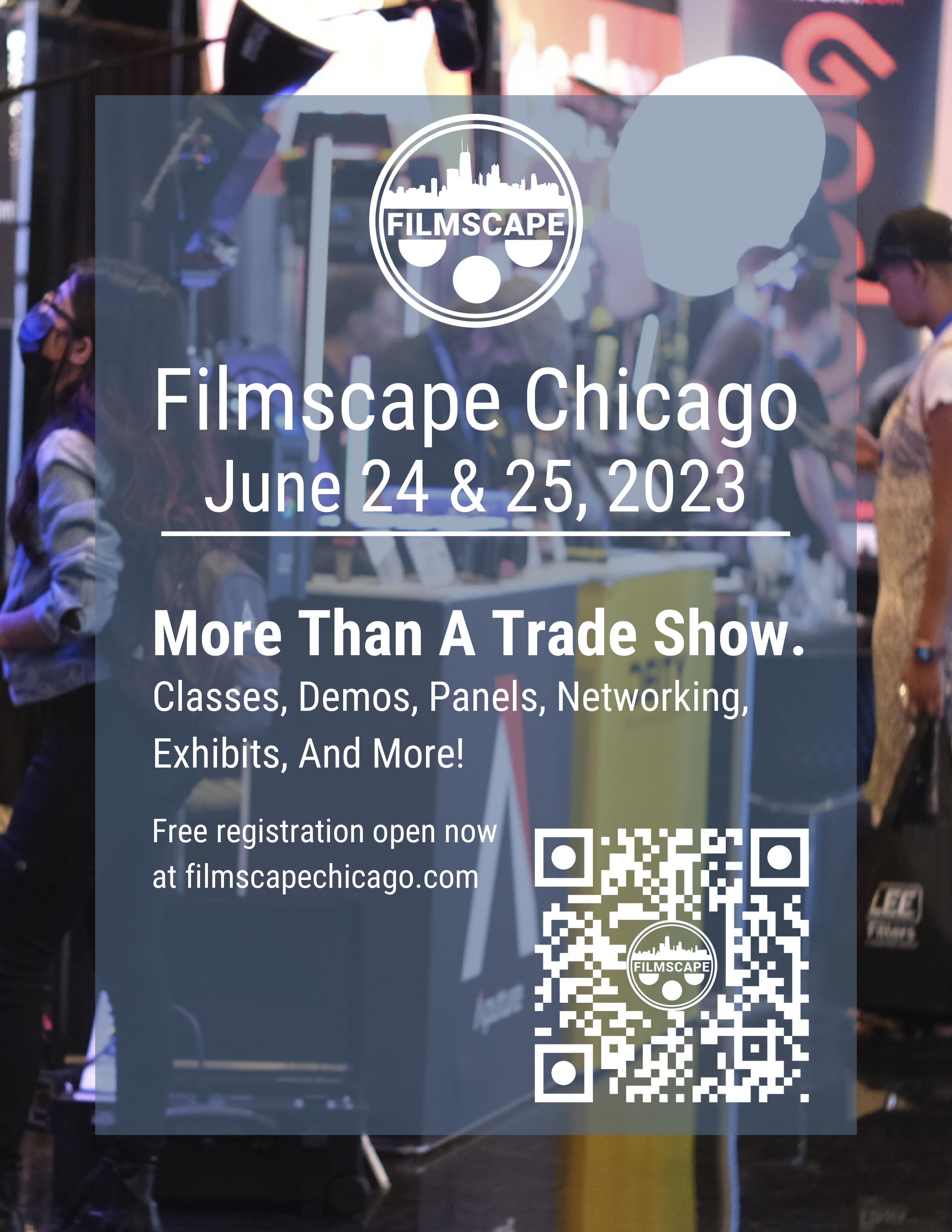







back WHERE THE ENTERTAINMENT AND TECHNOLOGY INDUSTRY REUNITE BACK AT THE RAI AMSTERDAM | 15-18 SEPTEMBER 2023 Register your interest at show.ibc.org









































































 Foldable foot for setup on flat surfaces
Cold Shoe for thirdparty accessories and to attach on cameras
Babypin included for mounting on stands and via SuperClamp
Foldable foot for setup on flat surfaces
Cold Shoe for thirdparty accessories and to attach on cameras
Babypin included for mounting on stands and via SuperClamp
























 BY PAULINE ROGERS PHOTOS BY ALYSSA LONGCHAMP
BY PAULINE ROGERS PHOTOS BY ALYSSA LONGCHAMP






 BY MATT HURWITZ PHOTOS BY ALAN MARKFIELD / COLUMBIA PICTURES
BY MATT HURWITZ PHOTOS BY ALAN MARKFIELD / COLUMBIA PICTURES





















 Lipes, ASC, and Laura M. Gonçalves probe beneath the skin for a reimagining of David Cronenberg’s horror classic Dead Ringers.
Lipes, ASC, and Laura M. Gonçalves probe beneath the skin for a reimagining of David Cronenberg’s horror classic Dead Ringers.
















 A new Apple TV+ series unites two longtime Guild cinematographers (and two regional locations) for the screen adaptation of Laura Dave’s best-selling novel.
A new Apple TV+ series unites two longtime Guild cinematographers (and two regional locations) for the screen adaptation of Laura Dave’s best-selling novel.
 BY TED ELRICK PHOTOS BY ERIN SIMKIN / APPLE TV+ FRAMEGRABS COURTESY OF APPLE TV+
BY TED ELRICK PHOTOS BY ERIN SIMKIN / APPLE TV+ FRAMEGRABS COURTESY OF APPLE TV+











 Photos by Saeed Adyani
Photos by Saeed Adyani







 By Pauline Rogers
Photo by Greg Gayne
By Pauline Rogers
Photo by Greg Gayne



















 DILGARD
DILGARD













